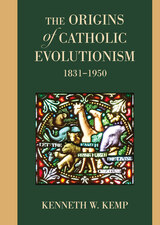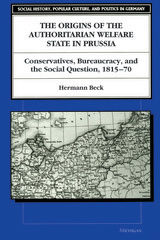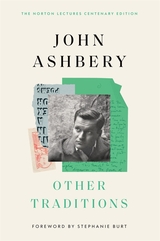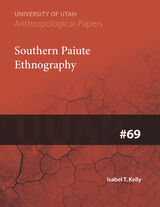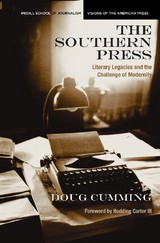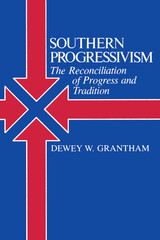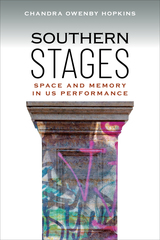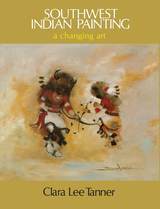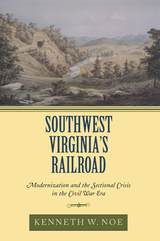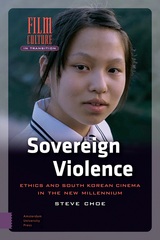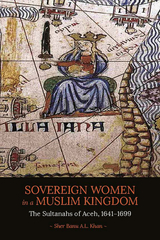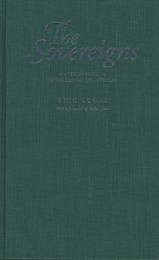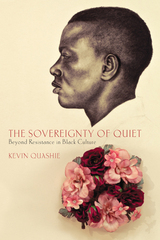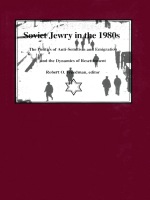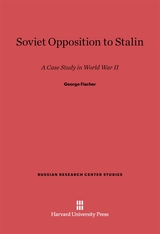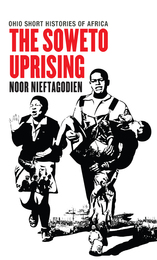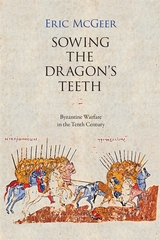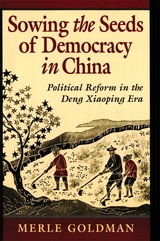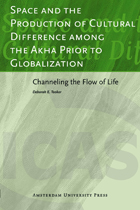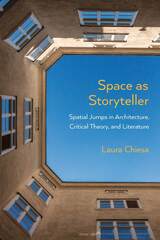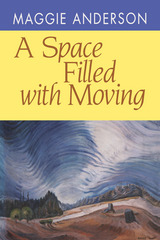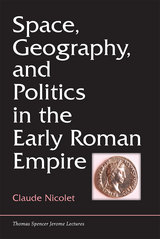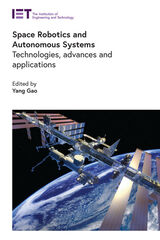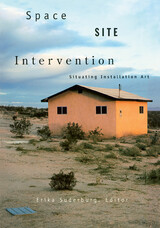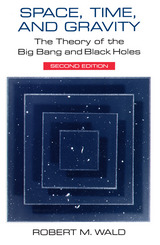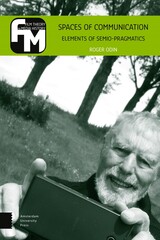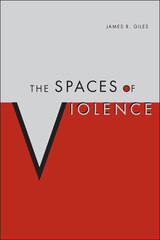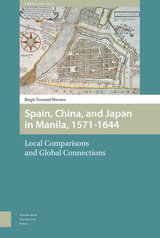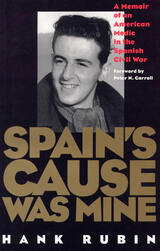Southern Paiute Ethnography: UUAP 69
Isabel T. Kelly
University of Utah Press, 1964 AKA Glen Canyon Series Number 21. A study of the four eastern bands of Southern Pauite: Kaibab, Kaiparowits, San Juan, and Panguitch. The text was written by Isabel Kelly on the basis of field data she gathered in 1932.
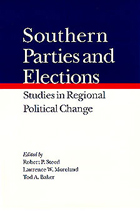 Southern Parties and Elections: Studies in Regional Political Change
Robert P. Steed
University of Alabama Press, 1997 Clarifies the recent and dramatic development of party competition in the South Southern politics has changed dramatically during the past half century. While new developments have touched virtually every aspect of the region's politics, change has been especially marked in the South's political party and electoral systems. Southern Parties and Elections explores the contemporary developments in party realignment and examines the relationship between regional party change and electoral behavior and the larger patterns in national politics. The collection's first group of essays examines some of the key legal issues in contemporary southern politics: the legal battle over majority-minority districting, the electoral consequences of such districting, the practice-fairly widespread in the South-of separating presidential elections from state and local elections, and the connections between the electorate and party change. The second section of essays focuses on nominations, elections, and partisan developments in the South, including the recent surge of voter participation in southern Republican primaries, the comparative importance of the South and selected states with large blocks of electoral votes in presidential election outcomes, and the southern contribution to patterns of voting in Congress. The final two chapters examine changes in southern state legislatures-one a case study of the Virginia General Assembly and the other an analysis of state legislatures in the region as a whole. Collectively these essays add important pieces to the enduring puzzle of "southern politics."
 The Southern Past: A Clash of Race and Memory
W. Fitzhugh Brundage
Harvard University Press, 2008 Since the Civil War whites and blacks have struggled over the meanings and uses of the Southern past. Indeed, today’s controversies over flying the Confederate flag, renaming schools and streets, and commemorating the Civil War and the civil rights movement are only the latest examples of this ongoing divisive contest over issues of regional identity and heritage. The Southern Past argues that these battles are ultimately about who has the power to determine what we remember of the past, and whether that remembrance will honor all Southerners or only select groups.
For more than a century after the Civil War, elite white Southerners systematically refined a version of the past that sanctioned their racial privilege and power. In the process, they filled public spaces with museums and monuments that made their version of the past sacrosanct. Yet, even as segregation and racial discrimination worsened, blacks contested the white version of Southern history and demanded inclusion. Streets became sites for elaborate commemorations of emancipation and schools became centers for the study of black history. This counter-memory surged forth, and became a potent inspiration for the civil rights movement and the black struggle to share a common Southern past rather than a divided one.
W. Fitzhugh Brundage’s searing exploration of how those who have the political power to represent the past simultaneously shape the present and determine the future is a valuable lesson as we confront our national past to meet the challenge of current realities.
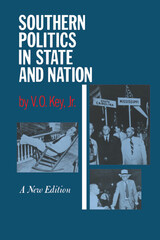 Southern Politics in State and Nation: with an Introduction by Alexander Heard
V.O. Key
University of Tennessee Press, 1984 More than thirty years after its original publication, V. O. Key's classic remains the most influential book on its subject. Its author, one of the nation's most astute observers, drew on more than five hundred interviews with Southerners to illuminate the political process in the South and in the nation.
Key's book explains party alignments within states, internal factional competition, and the influence of the South upon Washington. It also probes the nature of the electorate, voting restrictions, and political operating procedures. This reprint of the original edition includes a new introduction by Alexander Heard and a profile of the author by William C. Havard.
"A monumental accomplishment in the field of political investigation."
—Hodding Carter, New York Times
"The raw truth of southern political behavior."
—C. Vann Woodward, Yale Review
"[This book] should be on the 'must' list of any student of American politics."
—Ralph J. Bunche
V.O. Key (1908-1963) taught political science at the University of California, Los Angeles, and at Johns Hopkins, Yale, and Harvard universities. He was president of the American Political Science Association and author of numerous books, including American State Politics: An Introduction (1956); Public Opinion and American Democracy (1961); and The Responsible Electorate (1966).
The Southern Press: Literary Legacies and the Challenge of Modernity
Doug Cumming
Northwestern University Press, 2009 The Southern Press suggests that the South’s journalism struck a literary pose closer to the older English press than to the democratic penny press or bourgeois magazines of the urban North. The Southern journalist was more likely to be a Romantic and an intellectual. The region’s journalism was personal, colorful, and steeped in the classics. News was less important than narrative. Neither "public" nor "opinion" had much meaning in a racially segregated South. Paradoxically, it was this non-reformist literary tradition that produced liberal southern editors, from Henry Grady to Ralph McGill, who were viewed in the North as both explainers of and dissidents from the South.
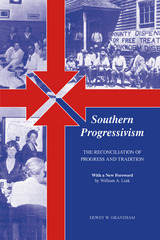 Southern Progressivism: The Reconciliation of Progress and Tradition
Dewey Grantham
University of Tennessee Press, 1983 This is the most comprehensive synthesis of the political history of the American South during the Progressive Era. Originally published in 1983, this work represented the master work of a gifted historian's career of reflecting on this period of the region's history. This new printing is accompanied by an insightful foreword by William A. Link, addressing the work's continuing relevance for today's students.
“For an understanding of what was happening and what southern progressivism was all about, [Grantham] has produced a monumental history and resource which may be added to and reinterpreted, but it is not likely to be superseded.”
–David Chalmers, Reviews in American History
“The rich detail and comprehensiveness of Grantham’s examination of the South in the first two decades of the twentieth century makes this a definitive work on the topic.”
–Library Journal
“[Grantham’s] masterful synthesis of forty years of scholarship makes the study preeminent in the field.”
–James A. Tinsley, Southwestern Historical Quarterly
“Southern Progressivism is a must for students of the twentieth-century America and the South.”
–Choice
Until his death in 2004, DEWEY W. GRANTHAM was the Holland N. McTyeire Professor of History Emeritus at Vanderbilt University. He was the author of The
South in Modern America: A Region at Odds, The Regional Imagination: The South and Recent American History, and The Life and Death of the Solid South. He served
in executive positions in the American Historical Association, the Organization of American Historians, and the Southern Historical Association.
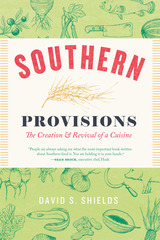 Southern Provisions: The Creation and Revival of a Cuisine
David S. Shields
University of Chicago Press, 2015 Southern food is America’s quintessential cuisine. From creamy grits to simmering pots of beans and greens, we think we know how these classic foods should taste. Yet the southern food we eat today tastes almost nothing like the dishes our ancestors enjoyed, because the varied crops and livestock that originally defined this cuisine have largely disappeared. Now a growing movement of chefs and farmers is seeking to change that by recovering the rich flavor and diversity of southern food. At the center of that movement is historian David S. Shields, who has spent over a decade researching early American agricultural and cooking practices. In Southern Provisions, he reveals how the true ingredients of southern cooking have been all but forgotten and how the lessons of its current restoration and recultivation can be applied to other regional foodways.
Shields’s turf is the southern Lowcountry, from the peanut patches of Wilmington, North Carolina to the sugarcane fields of the Georgia Sea Islands and the citrus groves of Amelia Island, Florida. He takes us on a historical excursion to this region, drawing connections among plants, farms, growers, seed brokers, vendors, cooks, and consumers over time. Shields begins by looking at how professional chefs during the nineteenth century set standards of taste that elevated southern cooking to the level of cuisine. He then turns to the role of food markets in creating demand for ingredients and enabling conversation between producers and preparers. Next, his focus shifts to the field, showing how the key ingredients—rice, sugarcane, sorghum, benne, cottonseed, peanuts, and citrus—emerged and went on to play a significant role in commerce and consumption. Shields concludes with a look at the challenges of reclaiming both farming and cooking traditions.
From Carolina Gold rice to white flint corn, the ingredients of authentic southern cooking are returning to fields and dinner plates, and with Shields as our guide, we can satisfy our hunger both for the most flavorful regional dishes and their history.
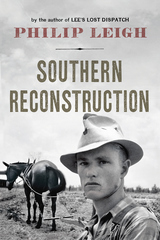 Southern Reconstruction
Philip Leigh
Westholme Publishing While the Rest of the Country Enjoyed a Gilded Age, the Deep South Descended into Devastating Poverty
The Reconstruction Era—the years immediately following the Civil War when Congress directed the reintegration of the former Confederate states into the Union—remains, as historian Eric Foner suggests, “America’s unfinished revolution.” But Reconstruction is more than a story of great racial injustice; it has left a complex legacy involving both blacks and whites, Southerners and Northerners, that is reflected today by the fact that many of the states with the highest rates of poverty were part of the former Confederacy. In Southern Reconstruction, Philip Leigh examines Federal wartime legislation in order to broaden our understanding of Reconstruction, revealing how it led to African Americans being used as political pawns, first to ensure continued Republican rule, and finally to be blamed for the South’s hardships in order to draw poor whites away from Populism and back to the aristocratic white Democratic banner.
Civil War laws, such as the Confiscation Acts, Pacific Railroad Acts, Homestead Act, Legal Tender Act, National Banking Act, and Veterans Pensions Acts, transformed America’s banking system, built a railroad web, and launched the Gilded Age in the North and West, but it also created a dubious alliance between banks and government, sparked corruption, purposely depressed Southern industry, trapped Southern farmers—both black and white—in endless annual peonage cycles, and failed to provide lands for freedmen. While Reconstruction was intended to return the South to the Union, it could not be effective with laws that abetted Southern poverty, disfranchised many whites, fostered racial animosity to a point where lynchings and Jim Crow laws erupted, and lined the pockets of wealthy or politically well-connected business leaders outside of the region.
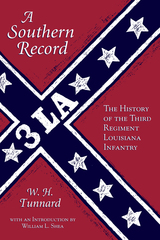 A Southern Record: The History of the Third Regiment Louisiana Infantry
William Tunnard
University of Arkansas Press, 1997 Originally published in a limited edition in 1866, this memoir of Will Tunnard’s experiences and observations of the Civil War in the West, where he served in the famed Third Louisiana Infantry, is one of only a handful of chronicles left by western Confederate soldiers. His first-person account of the battles of Wilson’s Creek, Pea Ridge, Iuka, and Corinth as well as the seige of Vicksburg, is a vivid history of these hard-fought campaigns which determined the outcome of the war in the Trans-Mississippi theater. Using letters and diaries assembled from former comrades as well as his own daily journal, Tunnard tells the story of his regiment and its extraordinary odyssey from the Gulf of Mexico to the Ozark Plateau and from the Indian Territory to Mobile Bay. He offers an extensive and valuable account of capture and parole at Vicksburg and includes muster rolls which will interest genealogists as well as Civil War scholars and history enthusiasts. With a clear eye for detail and an engaging, objective style, Tunnard conveys the pathos of war and recounts the trials of camp life, social conditions, and the war’s affect on the civilian population. Noted Civil War scholar William L. Shea supports the original text with background on the regiment and the time period, sketching a helpful chronology of events. In retelling this remarkable story of comradeship, hardship, endurance, courage, pride, and eventual defeat, Tunnard and Shea give modern readers a rare glimpse of the war in the West.
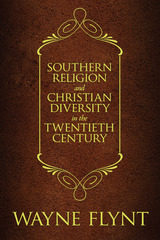 Southern Religion and Christian Diversity in the Twentieth Century
Wayne Flynt, Foreword by Charles A. Israel and John Giggie
University of Alabama Press, 2016 Essays by the distinguished historian of southern religion Wayne Flynt, that illuminate the often overlooked complexity among southern Protestants.
Throughout its dramatic history, the American South has wrestled with issues such as poverty, social change, labor reform, civil rights, and party politics, and Flynt’s writing reaffirms religion as the lens through which southerners understand and attempt to answer these contentious questions. In Southern Religion and Christian Diversity in the Twentieth Century, however, Flynt gently but persuasively dispels the myth—comforting to some and dismaying to others—of religion in the South as an inert cairn of reactionary conservatism.
Flynt introduces a wealth of stories about individuals and communities of faith whose beliefs and actions map the South’s web of theological fault lines. In the early twentieth century, North Carolinian pastor Alexander McKelway became a relentless crusader against the common practice of child labor. In 1972, Rev. Dr. Ruby Kile, in a time of segregated churches led by men, took the helm of the eight-member Powderly Faith Deliverance Center in Jefferson County, Alabama and built the fledgling group into a robust congregation with more than 700 black and white worshippers. Flynt also examines the role of religion in numerous pivotal court cases, such as the US Supreme Court school prayer case Engel v. Vitale, whose majority opinion was penned by Justice Hugo Black, an Alabamian. These fascinating case studies and many more illuminate a religious landscape of far more varied texture and complexity than is commonly believed.
Southern Religion and Christian Diversity in the Twentieth Century offers much to readers and scholars interested in the South, religion, and theology. Writing with his hallmark wit, warmth, and erudition, Flynt’s Southern Religion and Christian Diversity in the Twentieth Century is a vital record of gospel-inspired southerners whose stories revivify sclerotic assumptions about the narrow conformity of southern Christians.
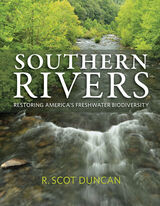 Southern Rivers: Restoring America's Freshwater Biodiversity
R. Scot Duncan
University of Alabama Press, 2024 Explores the Southeast’s imperiled river systems and solutions for preserving them in the face of habitat loss, climate change, and extinction
Southern Rivers, by award-winning nature writer and biologist R. Scot Duncan, is a thoroughly crafted exploration of the perilous state of the Southeast’s rivers and the urgent need to safeguard their vitality. The region’s rivers are the epicenter of North American freshwater biodiversity and are the top global hotspot for important aquatic animals including mussels, turtles, snails, crayfish, and fish, many of which have made important contributions to southern life and culture.
Centuries of commercial development have impaired the region’s river systems, sacrificing biodiversity and compromising the rivers’ ability to provide resources essential to human life: drinking water, waste disposal, irrigation, navigation, recreation, power production, and more. Now, increased heat and drought caused by climate change are lowering water levels. As such threats increase, it may seem necessary to choose between nature conservation and human needs, but Duncan persuasively demonstrates that this is a false choice. Conservation enhances human life.
In the same engaging voice of an expert friend that won over thousands of readers of his earlier book, Southern Wonder: Alabama’s Surprising Biodiversity, Duncan explains the task of managing southeastern rivers and how river water quality affects the daily lives of the millions who hold these historic waterways dear. He shows how managing rivers wisely can meet the needs of biodiversity and humanity both. With Americans increasingly anxious about the onset of climate change and the accelerating extinction crisis, Southern Rivers illuminates actionable solutions.
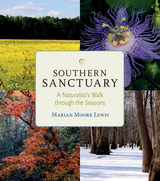 Southern Sanctuary: A Naturalist's Walk through the Seasons
Marian Moore Lewis
University of Alabama Press, 2015 In Southern Sanctuary, retired NASA research scientist and writer Marian Moore Lewis takes readers on a journey of discovery through the Goldsmith-Schiffman Wildlife Sanctuary, a 400-acre preserve in Madison County, Alabama. Writing in the voice of a knowledgeable friend and with accompanying color photographs, Lewis introduces plants, animals, and other wildlife that reside in the preserve’s meadows, woods, and waterways—like those beloved throughout the American South.
Lewis has organized this beautifully presented volume into twelve monthly chapters. She starts her year in April after the crystalline frosts of winter have thawed. Already a bobcat has stamped a padded paw print in the lush spring muds as crossvine blossoms of magenta and lemon beckon winged pollinators nearby. Walk with her into the months of summer, when trees leaf out into a cathedral of habitats for birds, insects, and small mammals. In language naturalists of any age will enjoy, Lewis explains marvelous compound eyes, called ommatidia, of iridescent dragonflies and the homey carpentry of beavers damming a creek. As colored reflections signal autumn, companionable songbirds migrate south while the last caterpillars of summer roll themselves into a leaf tent, or hibernaculum, to exist in diapause until next spring. In winter, Lewis admires nature at rest and rocks like chert, sought by Native Americans for arrowheads. Chert lies over bedrock of crenellated limestone, remnant of a time when an undersea Alabama reverberated with life preparing to emerge from the sea.
Southern Sanctuary provides a rich compendium of useful features. Lewis uses both common and Latin names for the insects, plants and flowers, fungi, fish, reptiles, and mammals thus enriching knowledge of botany and zoology. Her photos and descriptions make it easy for explorers of Southern Appalachian riparian habitats to use the book to identify species of plants and animals near their own homes. Rounding out this astonishing work are handy guides to additional resources, taxonomy and measurements, rainfall, soil types, and native trees.
Southern Sanctuary will be of value to educators and students, professional and amateur naturalists, hikers, birdwatchers, botanists, and ecologists. Infusing a wealth of useful information into an elegant design, it encourages an awareness of Alabama’s rich biodiversity. Marian Moore Lewis’s Southern Sanctuary is a new classic in the best tradition of nature writing.
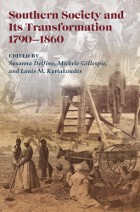 Southern Society and Its Transformations, 1790-1860
Edited by Susanna Delfino, Michele Gillespie & Louis M. Kyriakoudes
University of Missouri Press, 2011 In Southern Society and Its Transformations, a new set of scholars challenge conventional perceptions of the antebellum South as an economically static region compared to the North. Showing that the pre-Civil War South was much more complex than once thought, the essays in this volume examine the economic lives and social realities of three overlooked but important groups of southerners: the working poor, non-slaveholding whites, and middling property holders such as small planters, professionals, and entrepreneurs. The nine essays that comprise Southern Society and Its Transformations explore new territory in the study of the slave-era South, conveying how modernization took shape across the region and exploring the social processes involved in its economic developments. The book is divided into four parts, each analyzing a different facet of white southern life. The first outlines the legal dimensions of race relations, exploring the effects of lynching and the significance of Georgia’s vagrancy laws. Part II presents the advent of the market economy and its effect on agriculture in the South, including the beginning of frontier capitalism. The third section details the rise of a professional middle class in the slave era and the conflicts provoked. The book’s last section deals with the financial aspects of the transformation in the South, including the credit and debt relationships at play and the presence of corporate entrepreneurship.
Between the dawn of the nation and the Civil War, constant change was afoot in the American South. Scholarship has only begun to explore these progressions in the past few decades and has given too little consideration to the economic developments with respect to the working-class experience. These essays show that a new generation of scholars is asking fresh questions about the social aspects of the South’s economic transformation. Southern Society and Its Transformations is a complex look at how whole groups of traditionally ignored white southerners in the slave era embraced modernizing economic ideas and actions while accepting a place in their race-based world. This volume will be of interest to students of Southern and U.S. economic and social history.
 Southern Soul-Blues
David Whiteis
University of Illinois Press, 2013 Attracting passionate fans primarily among African American listeners in the South, southern soul draws on such diverse influences as the blues, 1960s-era deep soul, contemporary R & B, neosoul, rap, hip-hop, and gospel. Aggressively danceable, lyrically evocative, and fervidly emotional, southern soul songs often portray unabashedly carnal themes, and audiences delight in the performer-audience interaction and communal solidarity at live performances. Examining the history and development of southern soul from its modern roots in the 1960s and 1970s, David Whiteis highlights some of southern soul's most popular and important entertainers and provides first-hand accounts from the clubs, show lounges, festivals, and other local venues where these performers work. Profiles of veteran artists such as Denise LaSalle, the late J. Blackfoot, Latimore, and Bobby Rush--as well as contemporary artists T. K. Soul, Ms. Jody, Sweet Angel, Willie Clayton, and Sir Charles Jones--touch on issues of faith and sensuality, artistic identity and stereotyping, trickster antics, and future directions of the genre. These revealing discussions, drawing on extensive new interviews, also acknowledge the challenges of striving for mainstream popularity while still retaining the cultural and regional identity of the music and maintaining artistic ownership and control in the age of digital dissemination.
Southern Stages: Space and Memory in US Performance
Hopkins, Chandra
University of Iowa Press, 2025 Each day, countless southerners pass symbols and monuments dedicated to white supremacy and the “Old South”: statues, cemeteries, plantations, downtown squares, and even regional theatre stages. Some may only glance at them, ignorant to their history, while others recall the physical and psychological trauma embedded by generations of enslavement.
Through the eyes of actors and everyday people, Southern Stages offers an engaging new model for interrogating the performance of southernness, as well as how memory and imagination intersect in spaces that have shaped hundreds of years of American history. Chandra Owenby Hopkins employs cultural memory and lived realities of Black and white communities to examine the earliest and most enduring southern stages: the playhouse and the public square.
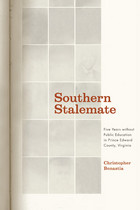 Southern Stalemate: Five Years without Public Education in Prince Edward County, Virginia
Christopher Bonastia
University of Chicago Press, 2011 In 1959, Virginia’s Prince Edward County closed its public schools rather than obey a court order to desegregate. For five years, black children were left to fend for themselves while the courts decided if the county could continue to deny its citizens public education. Investigating this remarkable and nearly forgotten story of local, state, and federal political confrontation, Christopher Bonastia recounts the test of wills that pitted resolute African Americans against equally steadfast white segregationists in a battle over the future of public education in America. Beginning in 1951 when black high school students protested unequal facilities and continuing through the return of whites to public schools in the 1970s and 1980s, Bonastia describes the struggle over education during the civil rights era and the human suffering that came with it, as well as the inspiring determination of black residents to see justice served. Artfully exploring the lessons of the Prince Edward saga, Southern Stalemate unearths new insights about the evolution of modern conservatism and the politics of race in America.
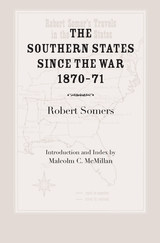 The Southern States Since The War
Robert Somers
University of Alabama Press, 1965 An extraordinarily valuable contribution to the history of the South during Reconstruction
Somers was fifty-eight years of age when he landed in America in the fall of 1870. His long-time newspaper career and his interest in social and economic matters had prepared him in a very special way to study the South, where the whole way of life had been so lately wracked by war. He was a keen and objective observer, modest and restrained in criticism and praise. On the whole he was optimistic for the future of the South. Although apparently a Southern sympathizer during the War, he was able to subordinate this sympathy and give a fair, detached, and balanced appraisal of economic life, politics and race relations. His interest in politics was confined in the main to their effect on the economic and social phases of the South's welfare.
Since his trip to America was not sponsored by “any Association, mercantile or political,” he was at liberty to record conditions as he saw them. Many of the accounts of conditions in the South in this period may be classified as promotional literature. State bureaus of immigration and agriculture, land companies, railroads and other interested groups hired agents to make favorable reports on cheap lands, on opportunities for industrial enterprise, deposits of minerals and the existence of other natural resources. They exaggerated economic opportunities and favorable political, cultural, and social conditions. Somers, on the other hand, was a true traveler, in the pay of no organization and with no axe to grind. He was particularly interested in economic and social matters: cotton and sugar culture, Negroes, railroads, natural resources, labor, industry, immigration and education. Since an analysis of the South’s economy was Somers’ major objective, his book made an extraordinarily valuable contribution to the history of the South during Reconstruction.
 The Southern Tradition: The Achievement and Limitations of an American Conservatism
Eugene Genovese
Harvard University Press, 1994 In recent years American conservatism has found a new voice, a new way of picking up the political pieces left in the wake of liberal policies. But what seems innovative, Eugene Genovese shows us, may in fact have very old roots. Tracing a certain strain of conservatism to its sources in a rich southern tradition, his book introduces a revealing perspective on the politics of our day. As much a work of political and moral philosophy as one of history, The Southern Tradition is based on the intellectual journey of one of the most influential historians of the late twentieth century.To appreciate the tradition of southern conservatism, Genovese tells us, we must first understand the relation of southern thought to politics. Toward this end, he presents a historical overview that identifies the tenets, sensibilities, and attitudes of the southern-conservative world view. With these conditions in mind, he considers such political and constitutional issues as state rights, concurrent majority, and the nature and locus of political power in a constitutional republic. Of special interest are the southern-conservative critiques of equality and democracy, and of the Leviathan state in its liberal, socialist, and fascist forms. Genovese examines these critiques in light of the specific concept of property that has been central to southern social and political thought.Not only does this book illuminate a political tradition grounded in the writings of John Randolph and John C. Calhoun, but it shows how this lineage has been augmented by powerful literary figures such as Allen Tate, Lewis Simpson, and Robert Penn Warren. Genovese here reconstitutes the historical canon, re-envisions the strengths and weaknesses of the conservative tradition, and broadens the spectrum of political debate for our time.
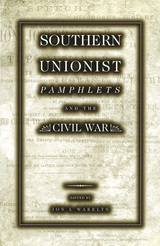 Southern Unionist Pamphlets and the Civil War
Edited by Jon L. Wakelyn
University of Missouri Press, 1999
During the Civil War, many southerners expressed serious opposition to secession and openly entreated their fellow southerners to maintain support for the Union. A number of these unionists actively opposed the Confederacy while remaining within its borders; others fled their homes and the South, becoming exiles in northern cities and the border slave states. The southern unionist leaders used their oral and written communication skills to proclaim their opposition to the Confederacy, often producing pamphlets that circulated in the North, in the border states, and in the heart of the Confederacy itself. Jon L. Wakelyn unites the voices of these southern unionists in the first comprehensive collection of their written arguments—Southern Unionist Pamphlets and the Civil War.
Including eighteen pamphlets and a discussion of twenty-two others, this book provides a magnificent representation of the southern unionists and their concerns. Written between 1861 and 1865, the pamphlets were compiled by local and national political leaders, including three federal congressmen and future vice president and president Andrew Johnson, as well as concerned private citizens and members of the military and clergy. Except for Florida, South Carolina, and Georgia, all Confederate and border slave states are represented in this collection.
The topics discussed and the events described in the pamphlets cover a wide range of subjects. The authors discuss their motivation to remain loyal to the union, the actions of their friends and enemies, the perilous life of unionists behind military lines, their continued support for the federal government, and their hopes for a restored Union. Aware that their northern allies would read these pamphlets, the unionists also wrote to solicit northern aid, to renew efforts to defeat the Confederacy, and to gain sympathy for the plight of their people behind enemy lines.
A remarkable collection of primary source material, Southern Unionist Pamphlets and the Civil War provides the most detailed study of the internal resistance to the Confederacy available to date. Students, scholars, and general readers alike will find this volume an invaluable resource for Civil War studies.
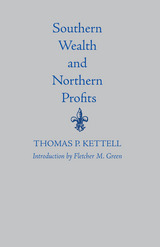 Southern Wealth and Northern Profits
Thomas P. Kettell with Introduction by Fletcher M. Green
University of Alabama Press, 1965 “This able work addresses itself peculiarly to the patriotism and interests of the American people, at this juncture, when it has become the duty of every good citizen, whatever may be his political creed, to aid in spreading the light of that truth which alone is depended upon to ‘combat error where the press is free.’”
Thomas Prentice Kettell was an outstanding spokesman of that group of pre-Civil War Northerners who earnestly believed that it was possible to save their country from the horrors of a sectional conflict, who worked many years to prevent the threatened dissolution of the Union, but zealously supported the national government during the Civil War in the hope that military victory would achieve what thirty years of wrangling, negotiation, and compromise had failed to accomplish-namely the preservation of a united North and South. Most of this Northern group were linked by economic ties to the planters of the South. As merchants, shippers, and financiers they largely depended upon the cotton trade for much of their prosperity; hence they opposed governmental policies which they believed would disturb their connections with the South and the foundations on which their economic prosperity and well being rested. But the fact that their ideas and position were founded on selfish economic interests did not make their action dishonest or unpatriotic.
Southern Wealth and Northern Profits was favorably received in the South where Kettell’s free trade principles, sympathetic attitude toward slavery, and his interest in Southern economic development had long been known. Moderate Southerners hoped the book might be helpful toward a compromise that would prevent secession, whereas radicals hoped it would further the cause of secession.
 Southern Womanhood and Slavery: A Biography of Louisa S. McCord, 1810-1879
Leigh Fought
University of Missouri Press, 2018 Southern Womanhood and Slavery is the first full-length biography of Louisa S. McCord, one of the most intriguing intellectuals in antebellum America. The daughter of South Carolina planter and politician Langdon Cheves, and an essayist in her own right, McCord supported unregulated free trade and the perpetuation of slavery and opposed the advancement of women’s rights. This study examines the origins of her ideas.
Leigh Fought constructs an exciting narrative that follows McCord from her childhood as the daughter of a state representative and president of the Bank of the United States through her efforts to accept her position as wife and mother, her career as an author and plantation mistress, and the Union invasion of South Carolina during the Civil War, to the end of her life in the emerging New South. Fought analyzes McCord’s poetry, letters, and essays in an effort to comprehend her acceptance of slavery and the submission of women. Fought concludes that McCord came to a defense of slavery through her experience with free labor in the North, which also reinforced her faith in the paternalist model for preserving social order.
McCord’s life as a writer on “unfeminine” subjects, her reputation as strong-minded and masculine, her late marriage, her continued ownership of her plantation after marriage, and her position as the matron of a Civil War hospital contradicted her own philosophy that women should remain the quiet force behind their husbands. She lived during a time of social flux in which free labor, slavery, and the role of women underwent dramatic changes, as well as a time that enabled her to discover and pursue her intellectual ambitions. Fought examines the conflict that resulted when those ambitions clashed with McCord’s role as a woman in the society of the South.
McCord’s voice was an interesting, articulate, and necessary feminine addition to antebellum white ideology. Moreover, her story demonstrates the ways in which southern women negotiated through patriarchy without surrendering their sense of self or disrupting the social order. Engaging and very readable, Southern Womanhood and Slavery will be of special interest to students of southern history and women’s studies, as well as to the general reader.
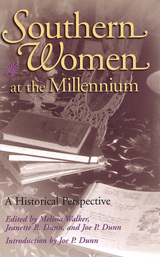 Southern Women at the Millennium: A Historical Perspective
Edited by Melissa Walker, Jeanette R. Dunn, & Joe P. Dunn, & Intro by Joe P. Dunn
University of Missouri Press, 2003
This collection of essays by eight scholars of southern women’s history traces the evolution of southern women’s lives during the twentieth century. Throughout this era, southern life, and in particular the opportunities for southern women, changed dramatically as southern women have taken leadership roles in business, government, education, and social programs.
The essayists employ a variety of approaches, ranging from case studies to historical overviews, but they all carefully place the developments in southern women’s lives in a national context. Most important, each author seeks to understand the nature of change in these women’s lives over the last century and to forecast the course of their lives in the future.
The first effort to synthesize research on southern women during this period, this collection will be useful to both scholars and students of southern history. Students will be provided with an introduction to women’s involvement in many areas of southern society, while scholars will appreciate the essays as a guide to new directions for research.
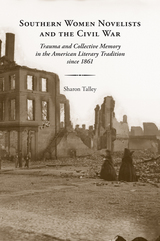 Southern Women Novelists and the Civil War: Trauma and Collective Memory in the American Literary Tradition since 1861
Sharon Talley
University of Tennessee Press, 2014 During and after the Civil War, southern women played a critical role in shaping the South’s evolving collective memory by penning journals and diaries, historical accounts, memoirs, and literary interpretations of the war. While a few of these writings—most notably Mary Chesnut’s diaries and Margaret Mitchell’s novel, Gone with the Wind—have been studied in depth by numerous scholars, until now there has been no comprehensive examination of Civil War novels by southern women. In this welcome study, Sharon Talley explores works by fifteen such writers, illuminating the role that southern women played in fashioning cultural identity in the region.
Beginning with Augusta Jane Evans’s Macaria and Sallie Rochester Ford’s Raids and Romance of Morgan and His Men, which were published as the war still raged, Talley offers a chronological consideration of the novels with informative introductions for each time period. She examines Reconstruction works by Marion Harland, Mary Ann Cruse, and Rebecca Harding Davis, novels of the “Redeemed” South and the turn of the century by Mary Noailles Murfree, Ellen Glasgow, and Mary Johnston, and narratives by Evelyn Scott, Margaret Mitchell, and Caroline Gordon from the Modern period that spanned the two World Wars. Analysis of Margaret Walker’s Jubilee (1966), the first critically acclaimed Civil War novel by an African American woman of the South, as well as other post–World War II works by Kaye Gibbons, Josephine Humphreys, and Alice Randall, offers a fitting conclusion to Talley’s study by addressing the inaccuracies in the romantic myth of the Old South that Gone with the Wind most famously engraved on the nation’s consciousness.
Informed by feminist, poststructural, and cultural studies theory, Talley’s close readings of these various novels ultimately refute the notion of a monolithic interpretation of the Civil War, presenting instead unique and diverse approaches to balancing “fact” and “fiction” in the long period of artistic production concerning this singular traumatic event in American history.
Sharon Talley, professor of English at Texas A&M University–Corpus Christi, is the author of Ambrose Bierce and the Dance of Death and Student Companion to Herman Melville. Her articles have appeared in American Imago, Journal of Men’s Studies, and Nineteenth-Century Prose.
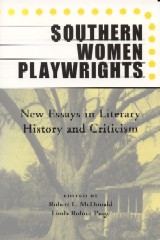 Southern Women Playwrights: New Essays in History and Criticism
Edited by Robert McDonald and Linda Rohrer Paige
University of Alabama Press, 2001 This timely collection addresses the neglected state of scholarship on southern women dramatists by bringing together the latest criticism on some of the most important playwrights of the 20th century. Coeditors Robert McDonald and Linda Rohrer Paige attribute the neglect of southern women playwrights in scholarly criticism to "deep historical prejudices" against drama itself and against women artists in general, especially in the South. Their call for critical awareness is answered by the 15 essays they include in Southern Women Playwrights, considerations of the creative work of universally acclaimed playwrights such as Beth Henley, Marsha Norman, and Lillian Hellman (the so-called "Trinity") in addition to that of less-studied playwrights, including Zora Neale Hurston, Carson McCullers, Alice Childress, Naomi Wallace, Amparo Garcia, Paula Vogel, and Regina Porter. This collection springs from a series of associated questions regarding the literary and theatrical heritage of the southern woman playwright, the unique ways in which southern women have approached the conventional modes of comedy and tragedy, and the ways in which the South, its types and stereotypes, its peculiarities, its traditions-both literary and cultural-figure in these women's plays. Especially relevant to these questions are essays on Lillian Hellman, who resisted the label "southern writer," and Carson McCullers, who never attempted to ignore her southernness. This book begins by recovering little-known or unknown episodes in the history of southern drama and by examining the ways plays assumed importance in the lives of southern women in the early 20th century. It concludes with a look at one of the most vibrant, diverse theatre scenes outside New York today-Atlanta.
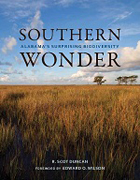 Southern Wonder: Alabama's Surprising Biodiversity
R. Scot Duncan
University of Alabama Press, 2013 Southern Wonder explores Alabama’s amazing biological diversity, the reasons for the large number of species in the state, and the importance of their preservation.
Alabama ranks fifth in the nation in number of species of plants and animals found in the state, surpassed only by the much larger western states of California,Texas, Arizona, and New Mexico. When all the species of birds, trees, mammals, reptiles, amphibians, fishes, wildflowers, dragonflies, tiger beetles, and ants are tallied, Alabama harbors more species than 90 percent of the other states in the United States. Alabamais particularly rich in aquatic biodiversity, leading the nation in species of freshwater fishes, turtles, mussels, crayfish, snails, damselflies, and carnivorous plants. The state also hosts an exceptional number of endemic species—those not found beyond its borders—ranking seventh in the nation with 144 species. The state’s 4,533 species, with more being inventoried and discovered each year, are supported by no less than 64 distinct ecological systems—each a unique blend of soil, water, sunlight, heat, and natural disturbance regimes. Habitats include dry forests, moist forests, swamp forests, sunny prairies, grassy barrens, scorching glades, rolling dunes, and bogs filled with pitcher plants and sundews. The state also includes a region of subterranean ecosystems that are more elaborate and species rich than any other place on the continent.
Although Alabama is teeming with life, the state’s prominence as a refuge for plants and animals is poorly appreciated. Even among Alabama’s citizens, few outside a small circle of biologists, advocates, and other naturalists understand the special quality of the state’s natural heritage. R. Scot Duncan rectifies this situation in Southern Wonder by providing a well-written, comprehensive overview that the general public, policy makers, and teachers can understand and use. Readers are taken on an exploratory journey of the state’s varied landscapes—from the Tennessee River Valley to the coastal dunes—and are introduced to remarkable species, such as the cave salamander and the beach mouse. By interweaving the disciplines of ecology, evolution, meteorology, and geology into an accessible whole, Duncan explains clearly why Alabama is so biotically rich and champions efforts for its careful preservation.
Published in Cooperation with The Nature Conservancy
 Southern Workers and the Search for Community: Spartanburg County, South Carolina
G. C. Waldrep III
University of Illinois Press, 2000 Spartanburg County, South Carolina, offered an example of the enduring legacy of the southern textile industry, company-owned mill villages, and union struggles of the 1930s. G. C. Waldrep illuminates the complex meshing of community ties and traditions with the goals and ideals of unionism. Unions aligned with a social vision of mutuality, equality, and interdependency already established in mill villages. But because companies owned the villages, labor conflicts involved not only work issues like wages and hours but virtually every other aspect of life. In documenting the high stakes of labor protest, Waldrep shows how the erosion or outright destruction of community undermined the ability of workers to respond to the assaults of employers overwhelmingly supported by government agencies and agents. Beautifully written and persuasively argued, Southern Workers and the Search for Community opens the gates of southern company towns to illuminate the human issues behind the mechanics of labor.
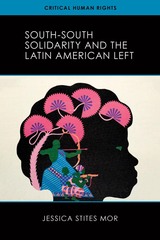 South-South Solidarity and the Latin American Left
Jessica Stites Mor
University of Wisconsin Press, 2024 Transnational solidarity movements often play an important role in reshaping structures of global power. However, there remains a significant gap in the historical literature on collaboration between parties located in the Global South. Facing increasing repression, the Latin American left in the 1960s and 1970s found connection in transnational exchange, organizing with distant activists in Africa, the Middle East, and the Caribbean. By exploring the particularities of South-South solidarity, this volume begins new conversations about what makes these movements unique, how they shaped political identities, and their lasting influence.
Jessica Stites Mor looks at four in-depth case studies: the use of legal reform to accomplish the goals of solidarity embedded in Mexico's revolutionary constitution, visual and print media circulated by Cuba and its influence on the agenda of the Afro-Asian block at the United Nations, organizing on behalf of Palestinian nationalism in reshaping Argentina's socialist left, and the role of Latin American Catholic activists in challenging the South African apartheid state. These examples serve as a much-needed road map to navigate our current political climate and show us how solidarity movements might approach future struggles.
 Southwell's Sphere: The Influence of England's Secret Poet
Gary M. Bouchard
St. Augustine's Press, 2016 Once feared by Queen Elizabeth I and admired by William Shakespeare, Robert Southwell, s.j. (1561–1595), clings today to a thinning canonical presence in English literature among a sphere of other writers incongruously called the metaphysical poets. Southwell’s Sphere lifts this sixteenth century Jesuit priest and prolific writer from the obscurity in which he too often resides and places him instead at the center of a sphere of English poets upon whom his life and works exerted an observable influence. As he weaved his religious content into the familiar loom of Elizabethan form and style, this young missionary priest was seeking not just to catechize those whom he regarded as the faithful and the fallen, but to intentionally reform the verse of his native England. Remarkably, during his brief six-year mission, he actually managed in many respects to do so. Surviving for six years by successfully navigating and fostering a complicated underground Catholic network in and around London before being captured, tortured and imprisoned, Southwell was brought to trial and executed at Tyburn at age 33. He therefore never knew most of the “skillfuller wits” that he called upon to direct their poetic skills to the service of God. And like the marks upon his tortured body, the poetic marks of influence that his work left upon individual writers of this era were in many cases deliberately concealed. Southwell’s Sphere seeks to rediscover those marks and offer the reader a renewed appreciation for this subverted and subverting literary force in Early Modern England. In individual explicative chapters this book examines works by six poets whose verse may be appreciated differently in light of Robert Southwell’s life and work. The author makes the case that Southwell’s works, posthumously and prolifically published, instructed William Alabaster, provoked Edmund Spenser, prompted George Herbert, haunted John Donne, inspired Richard Crashaw and — two and a half centuries later — consoled Gerard Manley Hopkins, s.j. With the exception of Spenser, all of these poets were, like Southwell, ordained ministers. The particular personal, political and religious complexities of each of their lives notwithstanding, what they most shared in common with Southwell was their priestly vocation, their talent as English poets and the inevitable and inextricable joining of these two activities in their lives. While it would have made little sense for any of these poets to acknowledge Southwell as a poetic peer, each of them authored important verse that can best be appreciated within the sphere of this improbably successful and influential English poet.
 The Southwest: A Fire Survey
Stephen J. Pyne
University of Arizona Press, 2016 With its scattered mountains and high rims, its dry air and summer lightning, its rising tier of biomes from desert grasses to alpine conifers, and its aggressive exurban sprawl, something in the Southwest is ready to burn each year and some high-value assets seem ever in their path. But the past 20 years have witnessed an uptake in savagery, as routine surface burns have mutated into megafires and overrun nearly a quarter of the region’s forests. What happened, and what does it mean for the rest of the country?
Through a mixture of journalism, history, and literary imagination, fire expert Stephen J. Pyne provides a lively survey of what makes this region distinctive, moving us beyond the usual conversations of science and policy. Pyne explores the Southwest’s sacred mountains, including the Jemez, Mogollon, Huachucas, and Kaibab; its sky islands, among them the Chiricahuas, Mount Graham, and Tanque Verde; and its famous rims and borders. Together, the essays provide a cross-section of how landscape fire looks in the early years of the 21st century, what is being done to manage it, and how fire connects with other themes of southwestern life and culture.
The Southwest is part of the multivolume series describing the nation’s fire scene region by region. The volumes in To the Last Smoke also cover California, the Northern Rockies, the Great Plains, Florida, and several other critical fire regions. The series serves as an important punctuation point to Pyne’s 50-year career with wildland fire—both as a firefighter and a fire scholar. These unique surveys of regional pyrogeography are Pyne’s way of “keeping with it to the end,” encompassing the directive from his rookie season to stay with every fire “to the last smoke.”
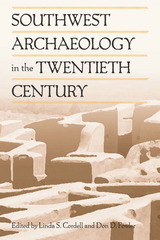 Southwest Archaeology in the Twentieth Century
Linda S Cordell
University of Utah Press, 2011 Mesa Verde, Chaco Canyon, Canyon de Chelly, and Paquimé are as well known to tourists as they are to scholars as emblems of the American Southwest. This region has been the scene of intense archaeological investigation for more than a hundred years, with more research done here than in any other part of the United States. The arid and sparsely populated landscape provides excellent site preservation, while the living native peoples give cultural continuity with the past. In the first decades of the twentieth century Americans saw the Southwest as exotic—as opposed to the Mexican perspective, which viewed the region, sometimes called the Northwest, as more of a backwater. Both views continue to shape and color the study of the area today.
With contributions from well-known archaeologists, Southwest Archaeology in the Twentieth Century reviews the histories of major archaeological topics of the region during the twentieth century, with particular attention to the vast changes in southwestern archaeology during the later decades of the century. Included are the huge influence of field schools, the rise of cultural resource management (CRM), the uses and abuses of ethnographic analogy, the intellectual contexts of archaeology in Mexico, and current debates on agriculture, sedentism, and political complexity.
By looking back at the previous century of study, this book provides an authoritative retrospective of intellectual trends as well as a synthesis of current themes in the arena of the American Southwest.
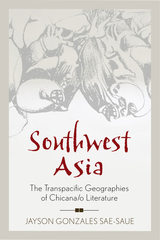 Southwest Asia: The Transpacific Geographies of Chicana/o Literature
Jayson Gonzales Sae-Saue
Rutgers University Press, 2016 Chicana/o literature is justly acclaimed for the ways it voices opposition to the dominant Anglo culture, speaking for communities ignored by mainstream American media. Yet the world depicted in these texts is not solely inhabited by Anglos and Chicanos; as this groundbreaking new book shows, Asian characters are cast in peripheral but nonetheless pivotal roles. Southwest Asia investigates why key Chicana/o writers, including Américo Paredes, Rolando Hinojosa, Oscar Acosta, Miguel Méndez, and Virginia Grise, from the 1950s to the present day, have persistently referenced Asian people and places in the course of articulating their political ideas. Jayson Gonzales Sae-Saue takes our conception of Chicana/o literature as a transnational movement in a new direction, showing that it is not only interested in North-South migrations within the Americas, but is also deeply engaged with East-West interactions across the Pacific. He also raises serious concerns about how these texts invariably marginalize their Asian characters, suggesting that darker legacies of imperialism and exclusion might lurk beneath their utopian visions of a Chicana/o nation. Southwest Asia provides a fresh take on the Chicana/o literary canon, analyzing how these writers have depicted everything from interracial romances to the wars Americans fought in Japan, Korea, and Vietnam. As it examines novels, plays, poems, and short stories, the book makes a compelling case that Chicana/o writers have long been at the forefront of theorizing U.S.–Asian relations.
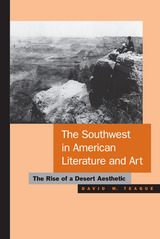 The Southwest in American Literature and Art: The Rise of a Desert Aesthetic
David W. Teague
University of Arizona Press, 1997 Is there a way to appreciate the desert without destroying it, a way to enjoy it without consuming it and to love it without killing it? Moreover, how can literature about the southwestern landscape affect ways in which it is either exploited or preserved? When and how did the desert change dramatically in the eyes of Anglo Americans from barren wilderness to national treasure?
By focusing on cultures that lived in the Southwest and by analyzing ways in which they described the land, David Teague persuasively argues against the destructive approach that Americans currently take to the region. Included are Native American legends and Spanish and Hispanic literature. However, the bulk of the study concentrates on Anglo American views of the Southwest, which have been generally at odds with the ecology of the deserts.
Ranging from oral traditions of the Navajo, Zuñi, and Hopi Indians to travel journals, fiction, and visual art, Teague examines the work of nearly thirty writers, artists, and explorers, including Alvar Núñez Cabeza de Vaca, Mary Austin, John Wesley Powell, and Frederic Remington. As he traces ideas about the desert over time, the author shows how American literature and art have come to represent the Southwest as a landscape to be sustained rather than transformed.
Bound to gain a prominent place in ecological criticism and in literature of the Southwest, this book offers important insights for scholars and students of literature, environmental studies, history, anthropology, and Native American studies. Its originality and vigor will also appeal to general readers with an interest in the landscape—and the future—of the American Southwest.
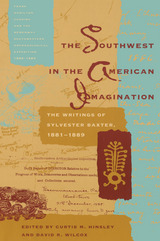 The Southwest in the American Imagination: The Writings of Sylvester Baxter, 1881-1889
Curtis M. Hinsley
University of Arizona Press, 1996 In the fall of 1886, Boston philanthropist Mary Tileston Hemenway sponsored an archaeological expedition to the American Southwest. Directed by anthropologist Frank Hamilton Cushing, the Hemenway Expedition sought to trace the ancestors of the Zuñis with an eye toward establishing a museum for the study of American Indians. In the third year of fieldwork, Hemenway's overseeing board fired Cushing based on doubts concerning his physical health and mental stability, and much of the expedition's work went unpublished. Today, however, it is recognized as a critical base for research into all of southwestern prehistory.
Drawing on materials housed in half a dozen institutions and now brought together for the first time, this projected seven-volume work presents a cultural history of the Hemenway Expedition and early anthropology in the American Southwest, told in the voices of its participants and interpreted by contemporary scholars. Taken as a whole, the series comprises a thorough study and presentation of the cultural, historical, literary, and archaeological significance of the expedition, with each volume posing distinct themes and problems through a set of original writings such as letters, reports, and diaries. Accompanying essays guide readers to a coherent understanding of the history of the expedition and discuss the cultural and scientific significance of these data in modern debates.
This first volume, The Southwest in the American Imagination, presents the writings of Sylvester Baxter, a journalist who became Cushing's friend and publicist in the early 1880s and who traveled to the Southwest and wrote accounts of the expedition. Included are Baxter's early writings about Cushing and the Southwest, from 1881 to 1883, which reported enthusiastically on the anthropologist's work and lifestyle at Zuñi before the expedition. Also included are published accounts of the Hemenway Expedition and its scientific promise, from 1888 to 1889, drawing on Baxter's central role in expedition affairs as secretary-treasurer of the advisory board. Series co-editor Curtis Hinsley provides an introductory essay that reviews Baxter's relationship with Cushing and his career as a journalist and civic activist in Boston, and a closing essay that inquires further into the lasting implications of the "invention of the Southwest," arguing that this aesthetic was central to the emergence and development of southwestern archaeology.
Seen a century later, the Hemenway Expedition provides unusual insights into such themes as the formation of a Southwestern identity, the roots of museum anthropology, gender relations and social reform in the late nineteenth century, and the grounding of American nationhood in prehistoric cultures. It also conveys an intellectual struggle, ongoing today, to understand cultures that are different from the dominant culture and to come to grips with questions concerning America's meaning and destiny.
Southwest Virginia's Railroad: Modernization and the Sectional Crisis in the Civil War Era
Kenneth W. Noe
University of Alabama Press, 2003 A close study of one region of Appalachia that experienced economic vitality and strong sectionalism before the Civil War This book examines the construction of the Virginia and Tennessee Railroad through southwest Virginia in the 1850s, before the Civil War began. The building and operation of the railroad reoriented the economy of the region toward staple crops and slave labor. Thus, during the secession crisis, southwest Virginia broke with northwestern Virginia and embraced the Confederacy. Ironically, however, it was the railroad that brought waves of Union raiders to the area during the war
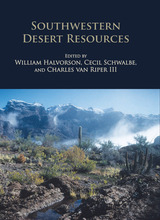 Southwestern Desert Resources
Edited by William Halvorson, Cecil Schwalbe, and Charles van Riper III
University of Arizona Press, 2010 The southwestern deserts stretch from southeastern California to west Texas and then south to central Mexico. The landscape of this region is known as basin and range topography featuring to “sky islands” of forest rising from the desert lowlands which creates a uniquely diverse ecology. The region is further complicated by an international border, where governments have caused difficulties for many animal populations.
This book puts a spotlight on individual research projects which are specific examples of work being done in the area and when they are all brought together, to shed a general light of understanding the biological and cultural resources of this vast region so that those same resources can be managed as effectively and efficiently as possible. The intent is to show that collaborative efforts among federal, state agency, university, and private sector researchers working with land managers, provides better science and better management than when scientists and land managers work independently.
 Southwestern Medical Dictionary: Spanish-English, English-Spanish
Margarita Artschwager Kay
University of Arizona Press, 2001 As doctors' time becomes more limited, communication with patients becomes more important and the need for doctor-patient understanding becomes critical. Here is a book that helps bridge the gap between the professional language of health care providers and that of people whose first language is Spanish.
A staple of southwestern health care for more than twenty years, this dictionary can make a difference in patient care. Now available in a revised edition, it focuses on vocabulary used in health contexts by Spanish-speaking people in order to help patients tell their stories and medical practitioners to understand them. Unlike other bilingual dictionaries that emphasize scientific terms, this one focuses on standard Spanish terms as well as regional expressions peculiar to Mexican Spanish—language encountered in Chicago as easily as in Phoenix.
In the Spanish-to-English section, Spanish terms are followed by English translations and sample sentences to help health care practitioners understand how a patient might use them:
acedías, heartburn, pain in lower esophagus perceived as in the heart. Uno tiene la tendencia a sufrir de acedías después de comer chile. One has a tendency to suffer heartburn after eating chile. (syn: acidez, agruras del estómago)
In the English-to-Spanish section, English words are translated into simple Spanish terms along with English synonyms.
Now available in a revised edition, this handy reference features:
• more than 3,000 entries
• new entries that reflect current health problems and treatments
• inclusion of cognates
• Spanish definitions of English words
• anatomical drawings with bilingual labels
• more material on medicinal plants, including an appendix of poisonous and non-poisonous plants
• lists of food items and kinship terms
This book is an indispensable reference for all health care professionals who see patients of Mexican origin. Combining idiomatic precision with technical accuracy, it can help break down language barriers on either side of the border.
 Southwestern National Monuments: Frank Pinkley and the Rise of the National Park System
Will Moore
University of Utah Press, 2025 Uncovering forgotten stories of the national monuments of the American Southwest
This volume uncovers the little-known legacy of Frank Pinkley, the first superintendent of the Southwestern National Monuments (SWNM)—a unique National Park Service unit established in 1923. Pinkley’s leadership and innovative approach helped protect and develop thirty diverse monuments, ranging from Montezuma Castle to White Sands, linked by miles of rough roads and united by their historical, archaeological, and natural significance.
Drawing on archived SWNM Monthly Reports, Will Moore reconstructs the stories behind these monuments and their contributions to the nascent national park system. From the pioneering all-Navajo Mobile Unit of the Civilian Conservation Corps to visionary work in visitor education, Pinkley and his team helped to set a course for the protection of American landscapes. Southwestern National Monuments is essential reading for anyone passionate about America's natural heritage and national parks.
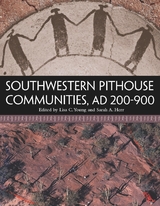 Southwestern Pithouse Communities, AD 200-900
Edited by Lisa C. Young and Sarah A. Herr
University of Arizona Press, 2012 Pithouses are the earliest identifiable domestic architecture in many areas of the world, and can provide insights into the origins of communities--a fundamental component of past and present societies. In this book, Lisa Young and Sarah Herr invite archaeologists to explore the development of communities using information from pithouse sites in the American Southwest. Using regional and topical syntheses to investigate the formation of pithouse communities, contributors to this volume examine the complex relationship between the economic transition to agricultural dependence and the social changes associated with sedentism. They discover that during this transformation, peoples' relationship with the landscape changed in ways that affected their use of space, community organization, and cultural identity. Employing various theoretical perspectives, these contributions analyze changes in pithouses, site layout, communal architecture, and settlement patterns to investigate the development of place-based communities. Chapters look at community formation strategies in populous regions like the northern San Juan Basin, the southern Colorado Plateau, Mimbres/southern Mogollon, and Hohokam Basin and Range and compare them with social structures in more sparsely populated regions like the northeast Hohokam peripheries, the Arizona Transition Zone, the Cibola region, southeast New Mexico, and the northern Rio Grande. The book also includes thematic discussions of panregional economic change, the complex relationship between house and household, and the demographic shifts accompanying the Neolithic Demographic Transition. An essential book for students and archaeologists interested in the origins of communities, Southwestern Pithouse Communities is also an important comparative resource for scholars interested in social change during the transition to settled village life.
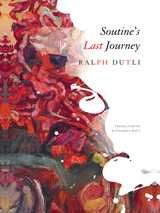 Soutine’s Last Journey
Ralph Dutli
Seagull Books, 2019 This is a biographical novel that tells the story of Chaim Soutine, a Jewish painter from Belorussia who had to be smuggled back to Paris in 1943.
August 6, 1943. Chaim Soutine, a Jewish painter from Belorussia and a contemporary of Chagall, Modigliani, and Picasso, is hidden in a hearse that’s traveling from a small town on the Loire towards Nazi-occupied Paris. Suffering from a stomach ulcer, he urgently needs a life-saving operation. But the hearse must avoid the occupiers’ checkpoints, and it becomes increasingly likely that he will not survive the journey.
In a stream of extraordinary images, the morphine-induced artist hallucinates and remembers his life. He dreams of his childhood in Smilovichi near Minsk; his beginnings as a painter in Vilna; his arrival in 1913 in the art capital of the world, Paris, where he befriends Modigliani; and his survival of years of struggle and finding sudden success, only to be persecuted and forced into hiding when the Nazis invade. Back in the present, the painter believes that the power of milk is the only possible remedy for his ulcer. In his mind, he is traveling to a “white paradise”—a strange clinic where a “god in white” declares him healed but forbids him to paint. But for Soutine, neither paradise nor salvation exists if he cannot paint. So, he begins to paint again in secret, willing to pay the price of discovery.
A brilliant biographical novel about childhood, longing, friendship, bodily pain, and the wounds of exile, Ralph Dutli’s Soutine’s Last Journey is ultimately an exploration of language and the power of art.
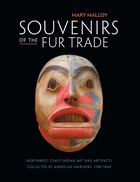 Souvenirs of the Fur Trade: Northwest Coast Indian Art and Artifacts Collected by American Mariners, 1788–1844
Mary Malloy
Harvard University Press, 2000 American mariners made more than 175 voyages to the Northwest Coast during the half-century after the ships Columbia and Washington pioneered the route from Boston in 1787. Although obtaining sea otter pelts for the China trade was the original purpose of the voyages, the art and culture of Northwest Coast Indians so intrigued and fascinated American sailors that the collecting of ethnographic artifacts became an important secondary trade. The Indians traded masks, hats, paddles, pipes, fishhooks, spoons, clothing, and canoe models from their canoes to the decks of Yankee vessels.
In this act of exchange, the artifacts moved from one world to another—first to shipboard, and later to the “cabinets of curiosities” of learned societies in Massachusetts, where many of them found homes. The objects were the first examples of Northwest Coast Indian material culture to enter American museums, and they influenced perceptions of Northwest Coast Indian people and their complex cultures.
By carefully researching the records of ten institutions and the shipboard journals of more than a dozen mariners, Mary Malloy has brought details about these early collections together for the first time. From utilitarian objects to artistic masterpieces, these souvenirs tell a story of commerce and cultural exchange that reached across the continent during the period when Americans were first beginning to look westward.
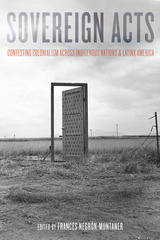 Sovereign Acts: Contesting Colonialism Across Indigenous Nations and Latinx America
Edited by Frances Negrón-Muntaner
University of Arizona Press, 2017 While the sovereign nation-state is considered the world’s political norm, millions of colonial subjects, immigrants, refugees, and native peoples appear to be without sovereignty. What claims have they to sovereignty? If they cannot ever constitute themselves into sovereign nation-states, are they out of the political game? Can a framework like sovereignty—used historically to exploit, dispossess, and even exterminate people—be a part of a struggle for political freedom?
Editor Frances Negrón-Muntaner and the contributors to Sovereign Acts engage in a debate around these questions with surprising results. Moving the idea of sovereignty beyond the narrow confines of the nation-state, beyond the concept of a power that one either has or lacks, this paradigm-shifting work examines the multiple ways that Indigenous nations and U.S. territorial peoples act as sovereign and the possible limits of such sovereign acts within the current globalized context. A valuable contribution to the debate around indigenous and other conceptions of sovereignty, Sovereign Acts goes further than legal frameworks to investigate the relationships among sovereignty, gender, sexuality, representation, and the body.
From activist style and choreography to the politics of recognition, the scholars and artists featured in this unique volume map out how people disrupt modern notions of sovereignty, attempt to redefine what being sovereign means, or seek alternative political vocabularies. Sovereignty is not only, after all, a kingdom and a crown.
CONTRIBUTORS
Michael Lujan Bevacqua
Glen Coulthard
Jennifer Nez Denetdale
Adriana María Garriga-López
Jessica A. F. Harkins
Brian Klopotek
Davianna Pomaika‘i McGregor
Frances Negrón-Muntaner
Yasmin Ramírez
Mark Rifkin
Madeline Román
Stephanie Nohelani Teves
Fa‘anofo Lisaclaire Uperesa
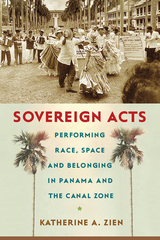 Sovereign Acts: Performing Race, Space, and Belonging in Panama and the Canal Zone
Zien, Katherine A.
Rutgers University Press, 2017 Winner of the 2018 Gordon K. and Sybil Farrell Lewis Book Prize from the Caribbean Studies Association
Winner of the 2017 Annual Book Prize from the Canadian Association of Latin American and Caribbean Studies (CALACS)
Sovereign Acts explores how artists, activists, and audiences performed and interpreted sovereignty struggles in the Panama Canal Zone, from the Canal Zone’s inception in 1903 to its dissolution in 1999. In popular entertainments and patriotic pageants, opera concerts and national theatre, white U.S. citizens, West Indian laborers, and Panamanian artists and activists used performance as a way to assert their right to the Canal Zone and challenge the Zone’s sovereignty, laying claim to the Zone’s physical space and imagined terrain.
By demonstrating the place of performance in the U.S. Empire’s legal landscape, Katherine A. Zien transforms our understanding of U.S. imperialism and its aftermath in the Panama Canal Zone and the larger U.S.-Caribbean world.
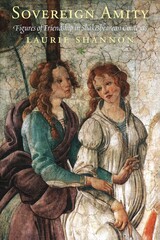 Sovereign Amity: Figures of Friendship in Shakespearean Contexts
Laurie Shannon
University of Chicago Press, 2001 Renaissance formulations of friendship typically cast the friend as "another self" and idealized a pair of friends as "one soul in two bodies." Laurie Shannon's Sovereign Amity puts this stress on the likeness of friends into context and offers a historical account of its place in English culture and politics.
Shannon demonstrates that the likeness of sex and station urged in friendship enabled a civic parity not present in other social forms. Early modern friendship was nothing less than a utopian political discourse. It preceded the advent of liberal thought, and it made its case in the terms of gender, eroticism, counsel, and kingship. To show the power of friendship in early modernity, Shannon ranges widely among translations of classical essays; the works of Elizabeth I, Montaigne, Donne, and Bacon; and popular literature, to focus finally on the plays of Shakespeare. Her study will interest scholars of literature, history, gender, sexuality, and political thought, and anyone interested in a general account of the English Renaissance.
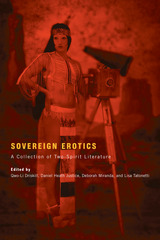 Sovereign Erotics: A Collection of Two-Spirit Literature
Edited by Qwo-Li Driskill, Daniel Heath Justice, Deborah Miranda, and Lisa Tatonetti
University of Arizona Press, 2011 Two-Spirit people, identified by many different tribally specific names and standings within their communities, have been living, loving, and creating art since time immemorial. It wasn’t until the 1970s, however, that contemporary queer Native literature gained any public notice. Even now, only a handful of books address it specifically, most notably the 1988 collection Living the Spirit: A Gay American Indian Anthology. Since that book’s publication twenty-three years ago, there has not been another collection published that focuses explicitly on the writing and art of Indigenous Two-Spirit and Queer people.
This landmark collection strives to reflect the complexity of identities within Native Gay, Lesbian, Bisexual, Transgender, Queer, and Two-Spirit (GLBTQ2) communities. Gathering together the work of established writers and talented new voices, this anthology spans genres (fiction, nonfiction, poetry, and essay) and themes (memory, history, sexuality, indigeneity, friendship, family, love, and loss) and represents a watershed moment in Native American and Indigenous literatures, Queer studies, and the intersections between the two.
Collaboratively, the pieces in Sovereign Erotics demonstrate not only the radical diversity among the voices of today’s Indigenous GLBTQ2 writers but also the beauty, strength, and resilience of Indigenous GLBTQ2 people in the twenty-first century.
Contributors: Indira Allegra, Louise Esme Cruz, Paula Gunn Allen, Qwo-Li Driskill, Laura Furlan, Janice Gould, Carrie House, Daniel Heath Justice, Maurice Kenny, Michael Koby, M. Carmen Lane, Jaynie Lara, Chip Livingston, Luna Maia, Janet McAdams, Deborah Miranda, Daniel David Moses, D. M. O’Brien, Malea Powell, Cheryl Savageau, Kim Shuck, Sarah Tsigeyu Sharp, James Thomas Stevens, Dan Taulapapa McMullin, William Raymond Taylor, Joel Waters, and Craig Womack
 Sovereign Fictions: Poetics and Politics in the Age of Russian Realism
Ilya Kliger
University of Chicago Press, 2024 An exploration of Russian realist fiction reveals a preoccupation with the absolutist state.
The nineteenth-century novel is generally assumed to owe its basic social imaginaries to the ideologies, institutions, and practices of modern civil society. In Sovereign Fictions, Ilya Kliger asks what happens to the novel when its fundamental sociohistorical orientation is, as in the case of Russian realism, toward the state. Kliger explores Russian realism’s distinctive construals of sociality through a broad range of texts from the 1830s to the 1870s, including major works by Tolstoy, Dostoevsky, Gogol, Pushkin, Lermontov, Goncharov, and Turgenev, and several lesser-known but influential books of the period, including Alexander Druzhinin’s Polinka Saks (1847), Aleksei Pisemsky’s One Thousand Souls (1858), and Vasily Sleptsov’s Hard Times (1865). Challenging much current scholarly consensus about the social dynamics of nineteenth-century realist fiction, Sovereign Fictions offers an important intervention in socially inflected theories of the novel and in current thinking on representations of power and historical poetics.
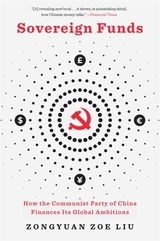 Sovereign Funds: How the Communist Party of China Finances Its Global Ambitions
Zongyuan Zoe Liu
Harvard University Press, 2023 “A fascinating insight into the evolution of China’s financial policy and its strategic investments using leveraged foreign exchange reserves.” —Diane Coyle, Enlightened Economist
“[Liu] shows that Chinese sovereign funds are so different from better-known sovereign wealth funds, such as those of the governments of Abu Dhabi and Norway, that she prefers to call them ‘sovereign leveraged funds’...These various exotic workarounds, which Liu skillfully traces, produce ‘shadow reserves.’” —Andrew J. Nathan, Foreign Affairs
“Follow the money, find the politics...Liu shows how China pioneered a whole new class of sovereign wealth funds.” —Times of India
One of the keys to China’s global rise has been its strategy of deploying sovereign wealth on behalf of state power. Since President Xi Jinping took office in 2013, China has doubled down on financial statecraft, making shrewd investments with the money it has made by leveraging its foreign exchange reserves. Sovereign Funds tells the story of how the Communist Party of China (CPC) became a global financier of surpassing ambition.
Zongyuan Zoe Liu offers a comprehensive and up-to-date analysis of the evolution of China’s sovereign funds, including the China Investment Corporation, the State Administration of Foreign Exchange, and Central Huijin Investment, showing how these institutions have become mechanisms not only for transforming low-reward foreign exchange reserves into investment capital but also for power projection. Sovereign funds are essential drivers of the national interest, shaping global markets, advancing the historic Belt and Road Initiative, and funneling state assets into strategic industries such as semiconductors, fintech, and artificial intelligence. Liu uncovers how the CPC is a leader in both foreign exchange reserves investment and economic statecraft, using state capital to encourage domestic economic activity and create spheres of influence worldwide.
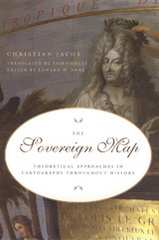 The Sovereign Map: Theoretical Approaches in Cartography throughout History
Christian Jacob
University of Chicago Press, 2006 A novel work in the history of cartography, The Sovereign Map argues that maps are as much about thinking as seeing, as much about the art of persuasion as the science of geography. As a classicist, Christian Jacob brings a fresh eye to his subject—which includes maps from Greek Antiquity to the twentieth century—and provides a theoretical approach to investigating the power of maps to inform, persuade, and inspire the imagination.
Beginning with a historical overview of maps and their creation—from those traced in the dirt by primitive hands to the monumental Dutch atlases and ornate maps on Italian palace walls—Jacob goes on to consider the visual components of cartography: the decorative periphery, geometric grid, topographical lines, dots, details of iconographic figures, and many other aspects. Considering text on maps—titles, toponyms, legends, and keys—Jacob proposes that writing can both clarify and interfere with a map's visual presentation. Finally Jacob examines the role of the viewer in decoding a map's meaning and the role of society in defining the power of maps as authoritative depictions of space.
Innovative in its philosophical motivation and its interdisciplinary approach to looking at and writing about maps, The Sovereign Map is eagerly awaited by scholars from many different fields.
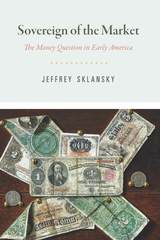 Sovereign of the Market: The Money Question in Early America
Jeffrey Sklansky
University of Chicago Press, 2017 What should serve as money, who should control its creation and circulation, and according to what rules? For more than two hundred years, the “money question” shaped American social thought, becoming a central subject of political debate and class conflict. Sovereign of the Market reveals how and why this happened.
Jeffrey Sklansky’s wide-ranging study comprises three chronological parts devoted to major episodes in the career of the money question. First, the fight over the innovation of paper money in colonial New England. Second, the battle over the development of commercial banking in the new United States. And third, the struggle over the national banking system and the international gold standard in the late nineteenth century. Each section explores a broader problem of power that framed each conflict in successive phases of capitalist development: circulation, representation, and association. The three parts also encompass intellectual biographies of opposing reformers for each period, shedding new light on the connections between economic thought and other aspects of early American culture. The result is a fascinating, insightful, and deeply considered contribution to the history of capitalism.
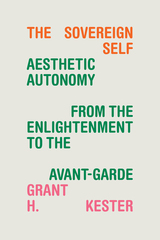 The Sovereign Self: Aesthetic Autonomy from the Enlightenment to the Avant-Garde
Grant H. Kester
Duke University Press, 2023 In The Sovereign Self, Grant H. Kester examines the evolving discourse of aesthetic autonomy from its origins in the Enlightenment through avant-garde projects and movements in the nineteenth and twentieth centuries. Kester traces the idea of aesthetic autonomy—the sense that art should be autonomous from social forces while retaining the ability to reflect back critically on society—through Kant, Schiller, Hegel, Marx, and Adorno. Kester critiques the use of aesthetic autonomy as the basis for understanding the nature of art and the shifting relationship between art and revolutionary praxis. He shows that dominant discourses of aesthetic autonomy reproduce the very forms of bourgeois liberalism that autonomy discourse itself claims to challenge. Analyzing avant-garde art and political movements in Russia, India, Latin America, and elsewhere, Kester retheorizes the aesthetic beyond autonomy. Ultimately, Kester demonstrates that the question of aesthetic autonomy has ramifications that extend beyond art to encompass the nature of political transformation and forms of anticolonial resistance that challenge the Eurocentric concept of “Man,” upon which the aesthetic itself often depends.
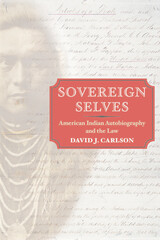 Sovereign Selves: American Indian Autobiography and the Law
David J. Carlson
University of Illinois Press, 2005 This book is an exploration of how American Indian autobiographers' approaches to writing about their own lives have been impacted by American legal systems from the Revolutionary War until the 1920s. Historically, Native American autobiographers have written in the shadow of "Indian law," a nuanced form of natural law discourse with its own set of related institutions and forms (the reservation, the treaty, etc.). In Sovereign Selves, David J. Carlson develops a rigorously historicized argument about the relationship between the specific colonial model of "Indian" identity that was developed and disseminated through U.S. legal institutions, and the acts of autobiographical self-definition by the "colonized" Indians expected to fit that model. Carlson argues that by drawing on the conventions of early colonial treaty-making, nineteenth- and early twentieth-century Indian autobiographers sought to adapt and redefine the terms of Indian law as a way to assert specific property-based and civil rights. Focusing primarily on the autobiographical careers of two major writers (William Apess and Charles Eastman), Sovereign Selves traces the way that their sustained engagement with colonial legal institutions gradually enabled them to produce a new rhetoric of "Indianness."
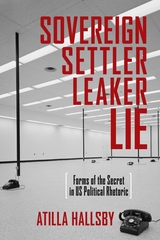 Sovereign, Settler, Leaker, Lie: Forms of the Secret in US Political Rhetoric
Atilla Hallsby
Ohio State University Press, 2026 In Sovereign, Settler, Leaker, Lie, Atilla Hallsby argues that secrets play a pivotal role in organizing political discourse in the United States. Hallsby takes up contemporary case studies—ranging from the Valerie Plame scandal during the George W. Bush presidency, to the use of Saul Alinsky’s name as a partisan codeword for politicizing Obama’s Blackness, to Chelsea Manning’s public naming and outing—to show how dramatic revelations increasingly fail to produce meaningful change and instead reproduce entrenched racial, gendered, and colonial hierarchies.
The core feature of these interlinked moments of crisis is the secret: a rhetorical patterning of political life organized by specific forms, each one lending a familiar shape to the shadows of American empire. These forms, theorized here as tropes, connect decades of secrets, linking the George W. Bush administration’s War on Terror to the Trump-era reemergence of “deep state” conspiracy theories. As an extension of secrecy and surveillance studies, and with the aim of attaining a more accountable and just form of US governmentality, Sovereign, Settler, Leaker, Lie explains how still-unfolding political realities in the United States emerged, transformed, and regenerate.
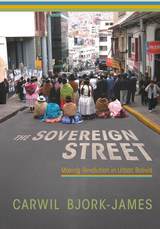 The Sovereign Street: Making Revolution in Urban Bolivia
Carwil Bjork-James
University of Arizona Press, 2020 In the early twenty-first century Bolivian social movements made streets, plazas, and highways into the decisively important spaces for acting politically, rivaling and at times exceeding voting booths and halls of government. The Sovereign Street documents this important period, showing how indigenous-led mass movements reconfigured the politics and racial order of Bolivia from 1999 to 2011. Drawing on interviews with protest participants, on-the-ground observation, and documentary research, activist and scholar Carwil Bjork-James provides an up-close history of the indigenous-led protests that changed Bolivia. At the heart of the study is a new approach to the interaction between protest actions and the parts of the urban landscape they claim. These “space-claiming protests” both communicate a message and exercise practical control over the city. Bjork-James interrogates both protest tactics—as experiences and as tools—and meaning-laden spaces, where meaning is part of the racial and political geography of the city. Taking the streets of Cochabamba, Sucre, and La Paz as its vantage point, The Sovereign Streetoffers a rare look at political revolution as it happens. It documents a critical period in Latin American history, when protests made headlines worldwide, where a generation of pro-globalization policies were called into question, and where the indigenous majority stepped into government power for the first time in five centuries.
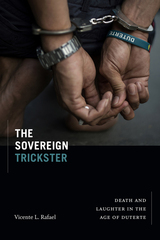 The Sovereign Trickster: Death and Laughter in the Age of Duterte
Vicente L. Rafael
Duke University Press, 2022 In The Sovereign Trickster Vicente L. Rafael offers a prismatic view of the age of Rodrigo Duterte in the contemporary Philippines. Framing Duterte as a trickster figure who boasts, jokes, terrorizes, plays the victim, and instills terror, Rafael weaves together topics ranging from the drug war, policing, and extrajudicial killings to neoliberal citizenship, intimacy, and photojournalism. He is less concerned with defining Duterte as a fascist, populist, warlord, and traditional politician than he is with examining what Duterte does: how he rules, the rhetoric of his humor, his use of obscenity to stoke fear, and his projection of masculinity and misogyny. Locating Duterte's rise within the context of counterinsurgency, neoliberalism, and the history of electoral violence, while drawing on Foucault’s biopower and Mbembe’s necropolitics, Rafael outlines how Duterte weaponizes death to control life. By diagnosing the symptoms of the authoritarian imaginary as it circulates in the Philippines, Rafael provides a complex account of Duterte’s regime and the social conditions that allow him to enjoy continued support.
Sovereign Violence: Ethics and South Korean Cinema in the New Millennium
Steve Choe
Amsterdam University Press, 2016 South Korea is home to one of the most vibrant film industries in the world today, producing movies for a strong domestic market that are also drawing the attention of audiences worldwide. This book presents a comprehensive analysis of some of the most well-known and incendiary South Korean films of the millennial decade from nine major directors. Building his analysis on contemporary film theory and philosophy, as well as interviews and other primary sources, Steve Choe makes a case that these often violent films pose urgent ethical dilemmas central to life in the age of neoliberal globalization.
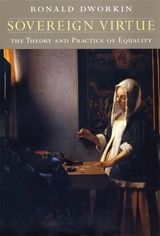 Sovereign Virtue: The Theory and Practice of Equality
Ronald Dworkin
Harvard University Press, 2000 Equality is the endangered species of political ideals. Even left-of-center politicians reject equality as an ideal: government must combat poverty, they say, but need not strive that its citizens be equal in any dimension. In his new book Ronald Dworkin insists, to the contrary, that equality is the indispensable virtue of democratic sovereignty. A legitimate government must treat all its citizens as equals, that is, with equal respect and concern, and, since the economic distribution that any society achieves is mainly the consequence of its system of law and policy, that requirement imposes serious egalitarian constraints on that distribution.
What distribution of a nation's wealth is demanded by equal concern for all? Dworkin draws upon two fundamental humanist principles--first, it is of equal objective importance that all human lives flourish, and second, each person is responsible for defining and achieving the flourishing of his or her own life--to ground his well-known thesis that true equality means equality in the value of the resources that each person commands, not in the success he or she achieves. Equality, freedom, and individual responsibility are therefore not in conflict, but flow from and into one another as facets of the same humanist conception of life and politics. Since no abstract political theory can be understood except in the context of actual and complex political issues, Dworkin develops his thesis by applying it to heated contemporary controversies about the distribution of health care, unemployment benefits, campaign finance reform, affirmative action, assisted suicide, and genetic engineering.
Sovereign Women in a Muslim Kingdom: The Sultanahs of Aceh, 1641-1699
Sher Banu Khan
National University of Singapore Press, 2018 The Islamic kingdom of Aceh was ruled by queens for half of the 17th century. Was female rule an aberration? Unnatural? A violation of nature, comparable to hens instead of roosters crowing at dawn? Indigenous texts and European sources offer different evaluations. Drawing on both sets of sources, this book shows that female rule was legitimised both by Islam and adat (indigenous customary laws), and provides original insights on the Sultanah’s leadership, their relations with male elites, and their encounters with European envoys who visited their court. The book challenges received views on kingship in the Malay world and the response of indigenous polities to east-west encounters in Southeast Asia’s Age of Commerce.
The Sovereigns: A Jewish Family in the German Countryside
Eric Lucas
Northwestern University Press, 2001 This memoir is a moving testament to the power of family. The Lucas clan was a close-knit, successful family of rural German Jews—butchers and meat dealers—whose strength and pride was challenged by the rise of Nazism. As the family grew, so did its prosperity and power, and the sons, daughter, and their relatives became known as the Sovereigns.
But anti-Semites, under the protection of the Nazi regime, began to settle old scores, and targeted the economically successful rural Jews. New laws stripped Jewish meat dealers of their rights, and Aryan competitors eagerly forced them aside. That was only the beginning. In the Holocaust that followed, some members of the family escaped. Others did not.
 Sovereigns, Quasi Sovereigns, and Africans: Race and Self-Determination in International Law
Siba N’Zatioula Grovogui
University of Minnesota Press, 1996 Sovereigns, Quasi Sovereigns, and Africans was first published in 1996. Minnesota Archive Editions uses digital technology to make long-unavailable books once again accessible, and are published unaltered from the original University of Minnesota Press editions. In this trenchant critique, Siba N'Zatioula Grovogui demonstrates the failure of international law to address adequately the issues surrounding African self-determination during decolonization. Challenging the view that the only requirement for decolonization is the elimination of the legal instruments that provided for direct foreign rule, Sovereigns, Quasi Sovereigns, and Africans probes the universal claims of international law. Grovogui begins by documenting the creation of the "image of Africa" in European popular culture, examining its construction by conquerors and explorers, scientists and social scientists, and the Catholic Church. Using the case of Namibia to illuminate the general context of Africa, he demonstrates that the principles and rules recognized in international law today are not universal, but instead reflect relations of power and the historical dominance of specific European states. Grovogui argues that two important factors have undermined the universal applicability of international law: its dependence on Western culture and the way that international law has been structured to preserve Western hegemony in the international order. This dependence on Europeandominated models and legal apparatus has resulted in the paradox that only rights sanctioned by the former colonial powers have been accorded to the colonized, regardless of the latter's needs. In the case of Namibia, Grovogui focuses on the discursive strategies used by the West and their southern African allies to control the legal debate, as well as the tactics used by the colonized to recast the terms of the discussion. Grovogui blends critical legal theory, historical research, political economy, and cultural studies with profound knowledge of contemporary Africa in general and Namibia in particular. Sovereigns, Quasi Sovereigns, and Africans represents the very best of the new scholarship, moving beyond narrow disciplinary boundaries to illuminate issues of decolonization in Africa. Siba N'Zatioula Grovogui is assistant professor of political science at Johns Hopkins University. He previously practiced law in his native Guinea.
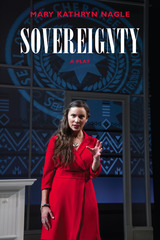 Sovereignty: A Play
Mary Kathryn Nagle
Northwestern University Press, 2020 A powerful meditation of the echoes of history and the never-ending struggle for sovereignty Sovereignty unfolds over two parallel timelines. In present-day Oklahoma, a young Cherokee lawyer, Sarah Ridge Polson, and her colleague Jim Ross defend the inherent jurisdiction of Cherokee Nation in the U.S. Supreme Court when a non-Indian defendant challenges the Nation’s authority to prosecute non-Indian perpetrators of domestic violence. Their collaboration is juxtaposed with scenes from 1835, when Cherokee Nation was eight hundred miles to the east in the southern Appalachians. That year, Sarah’s and Jim’s ancestors, historic Cherokee rivals, were bitterly divided over a proposed treaty with the administration of Andrew Jackson, the Treaty of New Echota, which led to the nation’s removal to Oklahoma on the infamous Trail of Tears.
A direct descendant of nineteenth-century Cherokee leaders John Ridge and Major Ridge, Mary Kathryn Nagle has penned a play that twists and turns from violent outbursts to healing monologues, illuminating a provocative double meaning for the sovereignty of both tribal territory and women’s bodies. Taking as its point of departure the story of one lawyer’s passionate defense of the rights of her people to prosecute non-natives who commit crimes on reservations, Sovereignty opens up into an expansive exploration of the circular continuity of history, human memory, and the power of human relationships.
 Sovereignty and Extortion: A New State Form in Mexico
Claudio Lomnitz
Duke University Press, 2024 Over the past fifteen years in Mexico, more than 450,000 people have been murdered and 110,000 more have been disappeared. In Sovereignty and Extortion, Claudio Lomnitz examines the Mexican state in relation to this extreme violence, uncovering a reality that challenges the familiar narratives of “a war on drugs” or a “failed state.” Tracing how neoliberal reforms, free trade agreements, and a burgeoning drug economy have shaped Mexico’s sociopolitical landscape, Lomnitz shows that the current crisis does not represent a tear in the social fabric. Rather, it reveals a fundamental shift in the relationship between the state and the economy in which traditional systems of policing, governance, and the rule of law have eroded. Lomnitz finds that power is now concentrated in the presidency and enforced through militarization, which has left the state estranged from itself and incapable of administering justice or regaining control over violence. Through this critical examination, Lomnitz offers a new theory of the state, its forms of sovereignty, and its shifting relation to capital and militarization.
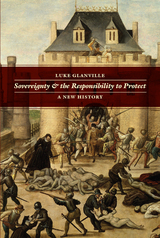 Sovereignty and the Responsibility to Protect: A New History
Luke Glanville
University of Chicago Press, 2013 In 2011, the United Nations Security Council adopted Resolution 1973, authorizing its member states to take measures to protect Libyan civilians from Muammar Gadhafi’s forces. In invoking the “responsibility to protect,” the resolution draws on the principle that sovereign states are responsible and accountable to the international community for the protection of their populations and that the international community can act to protect populations when national authorities fail to do so. The idea that sovereignty includes the responsibility to protect is often seen as a departure from the classic definition, but it actually has deep historical roots.
In Sovereignty and the Responsibility to Protect, Luke Glanville argues that this responsibility extends back to the sixteenth and seventeenth centuries, and that states have since been accountable for this responsibility to God, the people, and the international community. Over time, the right to national self-governance came to take priority over the protection of individual liberties, but the noninterventionist understanding of sovereignty was only firmly established in the twentieth century, and it remained for only a few decades before it was challenged by renewed claims that sovereigns are responsible for protection.
Glanville traces the relationship between sovereignty and responsibility from the early modern period to the present day, and offers a new history with profound implications for the present.
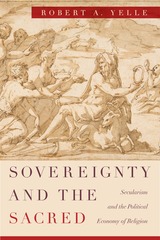 Sovereignty and the Sacred: Secularism and the Political Economy of Religion
Robert A. Yelle
University of Chicago Press, 2018 Sovereignty and the Sacred challenges contemporary models of polity and economy through a two-step engagement with the history of religions. Beginning with the recognition of the convergence in the history of European political theology between the sacred and the sovereign as creating “states of exception”—that is, moments of rupture in the normative order that, by transcending this order, are capable of re-founding or remaking it—Robert A. Yelle identifies our secular, capitalist system as an attempt to exclude such moments by subordinating them to the calculability of laws and markets. The second step marshals evidence from history and anthropology that helps us to recognize the contribution of such states of exception to ethical life, as a means of release from the legal or economic order. Yelle draws on evidence from the Hebrew Bible to English deism, and from the Aztecs to ancient India, to develop a theory of polity that finds a place and a purpose for those aspects of religion that are often marginalized and dismissed as irrational by Enlightenment liberalism and utilitarianism.
Developing this close analogy between two elemental domains of society, Sovereignty and the Sacred offers a new theory of religion while suggesting alternative ways of organizing our political and economic life. By rethinking the transcendent foundations and liberating potential of both religion and politics, Yelle points to more hopeful and ethical modes of collective life based on egalitarianism and popular sovereignty. Deliberately countering the narrowness of currently dominant economic, political, and legal theories, he demonstrates the potential of a revived history of religions to contribute to a rethinking of the foundations of our political and social order.
 Sovereignty and the Sea: How Indonesia Became an Archipelagic State
John G. Butcher and R. E. Elson
National University of Singapore Press, 2017 Until the mid-1950s nearly all of the sea between the far-flung islands of the Indonesian archipelago was open to ships of all nations, but in 1957, the Indonesian government declared that it had absolute sovereignty over all the waters lying within straight baselines drawn between the outermost islands of Indonesia. In this single step, Indonesia made its lands and seas a unified entity for the first time, a claim formally recognized in 1982 by the United Nations Convention on the Law of the Sea. Sovereignty and the Sea explores how Indonesia succeeded in its extraordinary claim despite its low international profile. John G. Butcher and R. E. Elson reveal that at the heart of Indonesia’s archipelagic campaign was a small group of Indonesian diplomats whose dogged persistence, negotiating skills, and willingness to make difficult compromises resulted in Indonesia becoming the greatest archipelagic state in the world.
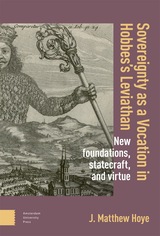 Sovereignty as a Vocation in Hobbes's Leviathan: New foundations, Statecraft, and Virtue
Matthew Hoye
Amsterdam University Press, 2024 This book argues that the fundamental foundation of Hobbes’s political philosophy in Leviathan is wise, generous, loving, sincere, just, and valiant—in sum, magnanimous—statecraft, whereby sovereigns aim to realize natural justice, manifest as eminent and other-regarding virtue. It proposes that concerns over the virtues of the natural person bearing the office of the sovereign suffuse Hobbes’s political philosophy, defining both his theory of new foundations and his critiques of law and obligation. These aspects of Hobbes’s thought are new to Leviathan, as they respond to limitations in his early works in political theory, Elements and De Cive—limitations made apparent by the civil wars and the regicide of Charles I. Though new, this book argues that they tap into ancient political and philosophical ideas, foremostly the variously celebrated, mystified, and maligned figure of the orator founder.
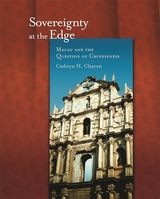 Sovereignty at the Edge: Macau and the Question of Chineseness
Cathryn H. Clayton
Harvard University Press, 2009 How have conceptions and practices of sovereignty shaped how Chineseness is imagined? This ethnography addresses this question through the example of Macau, a southern Chinese city that was a Portuguese colony from the 1550s until 1999. As the Portuguese administration prepared to transfer Macau to Chinese control, it mounted a campaign to convince the city’s residents, 95 percent of whom identified as Chinese, that they possessed a “unique cultural identity” that made them different from other Chinese, and that resulted from the existence of a Portuguese state on Chinese soil.
This attempt sparked reflections on the meaning of Portuguese governance that challenged not only conventional definitions of sovereignty but also conventional notions of Chineseness as a subjectivity common to all Chinese people around the world. Various stories about sovereignty and Chineseness and their interrelationship were told in Macau in the 1990s. This book is about those stories and how they informed the lives of Macau residents in ways that allowed different relationships among sovereignty, subjectivity, and culture to become thinkable, while also providing a sense of why, at times, it may not be desirable to think them.
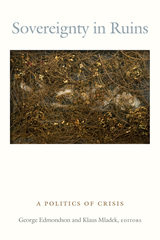 Sovereignty in Ruins: A Politics of Crisis
George Edmondson and Kalus Mladek, editors
Duke University Press, 2017 Featuring essays by some of the most prominent names in contemporary political and cultural theory, Sovereignty in Ruins presents a form of critique grounded in the conviction that political thought is itself an agent of crisis. Aiming to develop a political vocabulary capable of critiquing and transforming contemporary political frameworks, the contributors advance a politics of crisis that collapses the false dichotomies between sovereignty and governmentality and between critique and crisis. Their essays address a wide range of topics, such as the role history plays in the development of a politics of crisis; Arendt's controversial judgment of Adolf Eichmann; Strauss's and Badiou's readings of Plato's Laws; the acceptance of the unacceptable; the human and nonhuman; and flesh as a biopolitical category representative of the ongoing crisis of modernity. Altering the terms through which political action may take place, the contributors think through new notions of the political that advance countermodels of biopolitics, radical democracy, and humanity.
Contributors. Judith Butler, George Edmondson, Roberto Esposito, Carlo Galli, Klaus Mladek, Alberto Moreiras, Andrew Norris, Eric L. Santner, Adam Sitze, Carsten Strathausen, Rei Terada, Cary Wolfe
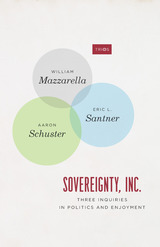 Sovereignty, Inc.: Three Inquiries in Politics and Enjoyment
William Mazzarella, Eric L. Santner, and Aaron Schuster
University of Chicago Press, 2020 What does the name Trump stand for? If branding now rules over the production of value, as the coauthors of Sovereignty, Inc. argue, then Trump assumes the status of a master brand whose primary activity is the compulsive work of self-branding—such is the new sovereignty business in which, whether one belongs to his base or not, we are all “incorporated.”
Drawing on anthropology, political theory, philosophy, psychoanalysis, and theater, William Mazzarella, Eric L. Santner, and Aaron Schuster show how politics in the age of Trump functions by mobilizing a contradictory and convoluted enjoyment, an explosive mixture of drives and fantasies that eludes existing portraits of our era. The current political moment turns out to be not so much exceptional as exceptionally revealing of the constitutive tension between enjoyment and economy that has always been a key component of the social order. Santner analyzes the collective dream-work that sustains a new sort of authoritarian charisma or mana, a mana-facturing process that keeps us riveted to an excessively carnal incorporation of sovereignty. Mazzarella examines the contemporary merger of consumer brand and political brand and the cross-contamination of politics and economics, warning against all too easy laments about the corruption of politics by marketing. Schuster, focusing on the extreme theatricality and self-satirical comedy of the present, shows how authority reasserts itself at the very moment of distrust and disillusionment in the system, profiting off its supposed decline. A dazzling diagnostic of our present, Sovereignty, Inc., forces us to come to terms with our complicity in Trump’s political presence and will immediately take its place in discussions of contemporary politics.
 Sovereignty, Indigeneity, and the Law, Volume 110
Eric Cheyfitz
Duke University Press Although Indigenous groups include diverse cultures and colonial experiences, Indigenous communities around the globe are united by a common struggle: to achieve self-determination and land rights as original occupants of the land prior to colonization. Historically, Western law has served both as an instrument of colonial control and as a means for Indigenous peoples to assert their claims to sovereignty and territory against those of nation-states. The essays in this issue of SAQ consider historical and contemporary colonial conflicts and explore key topics in Indigenous studies, including land rights, human rights, legal jurisdiction, Indigenous governance, and questions of language, culture, and the environment. This wide-ranging collection addresses the political possibilities of Western law and the international meanings of sovereignty and Indigeneity. One essay analyzes the autonomous government through which local citizens in Indigenous Zapatista communities in Mexico hope to dissolve systems of top-down sovereignty altogether. Another explores narratives of Native American law and the treatment of sovereignty in contemporary Mohawk visual culture. Several essays discuss the legal and political implications of the field’s pivotal public documents, including the 2007 U.N. Declaration on the Rights of Indigenous Peoples. Eric Cheyfitz is the Ernest I. White Professor of American Studies and Humane Letters in the Department of English at Cornell University. N. Bruce Duthu is the Samson Occom Professor of Native American Studies and Chair of the Native American Studies Program at Dartmouth College. Shari M. Huhndorf is Associate Professor of English at the University of Oregon. Contributors: Christine Black, Eric Cheyfitz, Gordon Christie, Chris Cunneen, Jonathan Goldberg-Hiller, Lorie M. Graham, Roy M. Huhndorf, Shari M. Huhndorf, Forrest Hylton, Mara Kaufman, Alvaro Reyes, Jolene Rickard, Carlos Salinas, Noenoe K. Silva, Cheryl Suzack, Siegfried Wiessner
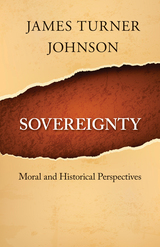 Sovereignty: Moral and Historical Perspectives
James Turner Johnson
Georgetown University Press, 2014 Sovereignty generally refers to a particular national territory, the inviolability of the nation’s borders, and the right of that nation to protect its borders and ensure internal stability. From the Middle Ages until well into the Modern Period, however, another concept of sovereignty held sway: responsibility for the common good. James Turner Johnson argues that these two conceptions—sovereignty as self-defense and sovereignty as acting on behalf of the common good—are in conflict and suggests that international bodies must acknowledge this tension. Johnson explores this earlier concept of sovereignty as moral responsibility in its historical development and expands the concept to the current idea of the Responsibility to Protect. He explores the use of military force in contemporary conflicts, includes a review of radical Islam, and provides a corrective to the idea of sovereignty as territorial integrity in the context of questions regarding humanitarian intervention. Johnson’s new synthesis of sovereignty deepens the possibilities for cross-cultural dialogue on the goods of politics and the use of military force.
The Sovereignty of Quiet: Beyond Resistance in Black Culture
Quashie, Kevin
Rutgers University Press, 2012 African American culture is often considered expressive, dramatic, and even defiant. In The Sovereignty of Quiet, Kevin Quashie explores quiet as a different kind of expressiveness, one which characterizes a person’s desires, ambitions, hungers, vulnerabilities, and fears. Quiet is a metaphor for the inner life, and as such, enables a more nuanced understanding of black culture. The book revisits such iconic moments as Tommie Smith and John Carlos’s protest at the 1968 Mexico City Olympics and Elizabeth Alexander’s reading at the 2009 inauguration of Barack Obama. Quashie also examines such landmark texts as Gwendolyn Brooks’s Maud Martha, James Baldwin’s The Fire Next Time, and Toni Morrison’s Sula to move beyond the emphasis on resistance, and to suggest that concepts like surrender, dreaming, and waiting can remind us of the wealth of black humanity.
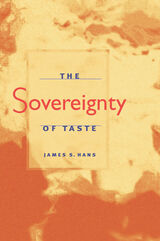 The Sovereignty of Taste
James S. Hans
University of Illinois Press, 2002 Challenging prevailing trends toward aesthetic neutrality, James S. Hans argues that there is such a thing as good and bad taste, that taste is something one is born with, and that it is firmly rooted in the mechanics of biology.
Taste is everything, Hans says, for it produces the primary values that guide our lives. Taste is the fundamental organizing mechanism of human bodies, a lifelong effort to fit one's own rhythms to the rhythms and patterns of the natural world and the larger human community. It is an aesthetic sorting process by which one determines what belongs in--a conversation, a curriculum, a committee, a piece of art, a meal, a logical argument--and what should be left out. On the one hand, taste is the source of beauty, justice, and a sense of the good. On the other hand, as an arbiter of the laws of fair and free play, taste enters into more ominous and destructive patterns--but patterns nonetheless--of resentment and violence.
Hans develops his conception of taste through astute readings of five literary landmarks: Milan Kundera's The Unbearable Lightness of Being, Sophocles' Oedipus the King, William Faulkner's Light in August, and the poetry of Emily Dickinson and the Polish Nobel Laureate Czeslaw Milosz. These texts explore the art of soulmaking and the quest for personal expression: the costs as well as the fruits that come from acceding to the imperatives of one's being. They also reveal how the collision of personal and collective rhythms, whether in the Greek citadel or the Mississippi countryside, leads to violence and ritualized sacrifice.
Elegant, principled, and provocative, The Sovereignty of Taste is an essential book that restores taste to its rightful place of influence, shoring up the ground beneath civilization's feet and offering hope for the future of integrity, value, and aesthetic truth.
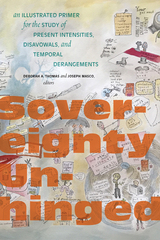 Sovereignty Unhinged: An Illustrated Primer for the Study of Present Intensities, Disavowals, and Temporal Derangements
Deborah A. Thomas and Joseph Masco, editors
Duke University Press, 2023 Sovereignty Unhinged theorizes sovereignty beyond the typical understandings of action, control, and the nation-state. Rather than engaging with the geopolitical realities of the present, the contributors consider sovereignty from the perspective of how it is lived and enacted in everyday practice and how it reflects people’s aspirations for new futures. In a series of ethnographic case studies ranging from the Americas to the Middle East to South Asia, they examine the means of avoiding the political and historical capture that make one complicit with sovereign authority rather than creating the conditions of possibility to confront it. The contributors attend to the affective dimensions of these practices of world-building to illuminate the epistemological, ontological, and transnational entanglements that produce a sense of what is possible. They also trace how sovereignty is activated and deactivated over the course of a lifetime within the struggle of the everyday. In so doing, they outline how individuals create and enact forms of sovereignty that allow them to endure fast and slow forms of violence while embracing endless opportunities for building new worlds.
Contributors. Alex Blanchette, Yarimar Bonilla, Jessica Cattelino, María Elena García, Akhil Gupta, Lochlann Jain, Purnima Mankekar, Joseph Masco, Michael Ralph, Danilyn Rutherford, Arjun Shankar, Kristen L. Simmons, Deborah A. Thomas, Leniqueca A. Welcome, Kaya Naomi Williams, Jessica Winegar
 Soviet Ballistic Missile Defense and the Western Alliance
David S. Yost
Harvard University Press, 1988 This is a study of the strategic challenges that Soviet ballistic missile defense (BMD) programs may pose for the Western alliance. David Yost suggests that the challenges for Western policy stem partly from Soviet military programs, Soviet arms control policies, and Soviet public diplomacy campaigns, and partly from the West’s own intra-alliance disagreements and lack of consensus about Western security requirements.
By reviewing the history of Western assessments of Soviet BMD, Yost shows that long before the American strategic defense initiative (SDI) was launched, Soviet BMD system modernization and infrastructure expansion were well under way, and that current Soviet programs are not mainly reactive to the SDI. Yost judges that the Soviets are probably better prepared than the Americans to deploy a network of traditional, ground-based BMD systems that would have at least some military value in the next decade, particularly against the limited and selective retaliatory attacks envisaged in NATO strategy. He does not argue that the Soviets are preparing for a clear-cut “breakout” from current arms control limits on BMD, but he notes the risks posed by activities that could eventually amount to a “creepout” from certain treaty constraints. Because of such ambiguities and the seriousness of the strategic and political stakes, the West should be prepared to pursue any necessary countermeasures in a timely fashion. His aim in this book is to advance understanding of the possible strategic challenges to the West and to identify potential points of consensus for Western policies.
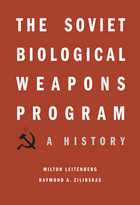 The Soviet Biological Weapons Program: A History
Milton Leitenberg and Raymond A. Zilinskas
Harvard University Press, 2012 Russian officials claim today that the USSR never possessed an offensive biological weapons program. In fact, the Soviet government spent billions of rubles and hard currency to fund a hugely expensive weapons program that added nothing to the country’s security. This history is the first attempt to understand the broad scope of the USSR’s offensive biological weapons research—its inception in the 1920s, its growth between 1970 and 1990, and its possible remnants in present-day Russia. We learn that the U.S. and U.K. governments never obtained clear evidence of the program’s closure from 1990 to the present day, raising the critical question whether the means for waging biological warfare could be resurrected in Russia in the future.
Based on interviews with important Soviet scientists and managers, papers from the Soviet Central Committee, and U.S. and U.K. declassified documents, this book peels back layers of lies, to reveal how and why Soviet leaders decided to develop biological weapons, the scientific resources they dedicated to this task, and the multitude of research institutes that applied themselves to its fulfillment. We learn that Biopreparat, an ostensibly civilian organization, was established to manage a top secret program, code-named Ferment, whose objective was to apply genetic engineering to develop strains of pathogenic agents that had never existed in nature. Leitenberg and Zilinskas consider the performance of the U.S. intelligence community in discovering and assessing these activities, and they examine in detail the crucial years 1985 to 1992, when Mikhail Gorbachev’s attempts to put an end to the program were thwarted as they were under Yeltsin.
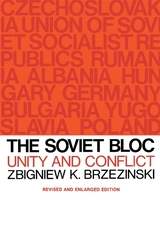 The Soviet Bloc: Unity and Conflict, Revised and Enlarged Edition
Zbigniew K. Brzezinski
Harvard University Press, 1967 This is the first full-length study of relations among the communist states. The study explores the implications of the status of Yugoslavia and China, the significance of the Hungarian revolution and the position of Poland in the Soviet bloc, and clarifies the Khrushchev–Gomulka clash of 1956 and the complex role of Tito. Zbigniew Brzezinski emphasizes the role of ideology and power in the relations among the communist states, contrasting bloc relations and the unifying role of Soviet power under Stalin with the present situation. He suggests that conflicts of interest among the ruling elites will result either in ideological disputes or in weakening the central core of the ideology, leading to a gradual decline of unity among the Communist states.
The author, while on leave from his post as Professor and Director of the Research Institute on Communist Affairs, Columbia University, and serving on the U.S. State Department’s Policy Planning Council, has revised and updated his important study and added three new chapters on more recent developments. He gives particular attention to the Sino–Soviet dispute.
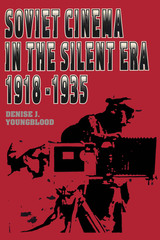 Soviet Cinema in the Silent Era, 1918–1935
By Denise J. Youngblood
University of Texas Press, 1991 The golden age of Soviet cinema, in the years following the Russian Revolution, was a time of both achievement and contradiction, as reflected in the films of Eisenstein, Pudovkin, and Kuleshov. Tensions ran high between creative freedom and institutional constraint, radical and reactionary impulses, popular and intellectual cinema, and film as social propaganda and as personal artistic expression. In less than a decade, the creative ferment ended, subjugated by the ideological forces that accompanied the rise of Joseph Stalin and the imposition of the doctrine of Socialist Realism on all the arts. Soviet Cinema in the Silent Era, 1918–1935 records this lost golden age. Denise Youngblood considers the social, economic, and industrial factors that influenced the work of both lesser-known and celebrated directors. She reviews all major and many minor films of the period, as well as contemporary film criticism from Soviet film journals and trade magazines. Above all, she captures Soviet film in a role it never regained—that of dynamic artform of the proletarian masses.
 Soviet Criminal Law and Procedure: The RSFSR Codes, Second Edition
Harold J. Berman
Harvard University Press There is no better key to the strengths and weaknesses of the Soviet social system than Soviet law. Here in English translation is the Criminal Code and Code of Criminal Procedure of the largest of the fifteen Soviet Republics—containing the basic criminal law of the Soviet Union and virtually the entire criminal law applicable in Russia—and the Law on Court Organization. These two codes and the Law, which went into effect o January 1, 1961, are among the chief products of the Soviet law reform movement which began after Stalin’s death, and are a concrete reflection of the effort to establish legality and prevent a return to Stalinist arbitrariness and terror.
In a long introductory essay Harold Berman, a leading authority on Soviet law, stresses the extent to which the codes are expressed in authentic soviet legal language, based in part on the pre-Revolutionary Russian past but oriented to Soviet concepts, conditions, and policies. He outlines the historical background of the new codes, with a detailed listing of the major changes reflected in them, interprets their significance, places them within the system of Soviet law as a whole, and discusses some of the principal similarities and differences between Soviet criminal law and procedure and that of Western Europe and of the United States.
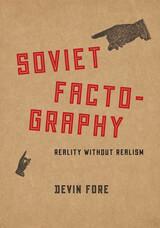 Soviet Factography: Reality without Realism
Devin Fore
University of Chicago Press, 2024 A study of Soviet factography, an avant-garde movement that employed photography, film, journalism, and mass media technologies.
This is the first major English-language study of factography, an avant-garde movement of 1920s modernism. Devin Fore charts this style through the work of its key figures, illuminating factography’s position in the material culture of the early Soviet period and situating it as a precursor to the genre of documentary that arose in the 1930s. Factographers employed photography and film practices in their campaign to inscribe facts and to chronicle modernization as it transformed human experience and society. Fore considers factography in light of the period’s explosion of new media technologies—including radio broadcasting, sound in film, and photo-media innovations—that allowed the press to transform culture on a massive scale.
This theoretically driven study uses material from Moscow archives and little-known sources to highlight factography as distinct from documentary and Socialist Realism and to establish it as one of the major twentieth-century avant-garde forms. Fore covers works of photography, film, literature, and journalism together in his considerations of Soviet culture, the interwar avant-gardes, aesthetics, and the theory of documentary.
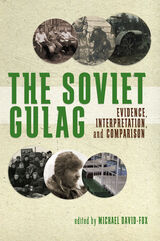 The Soviet Gulag: Evidence, Interpretation, and Comparison
Michael David-Fox
University of Pittsburgh Press, 2016 Before the collapse of the Soviet Union and the subsequent archival revolution, Aleksandr Solzhenitsyn’s famous “literary investigation” The Gulag Archipelago was the most authoritative overview of the Stalinist system of camps. But modern research is developing a much more thorough and nuanced understanding of the Gulag. There is a greater awareness of the wide variety of camps, many not isolated in far-off Siberia; prisoners often intermingled with local populations. The forced labor system was not completely distinct from the “free” labor of ordinary Soviet citizens, as convicts and non-prisoners often worked side-by-side. Nor was the Gulag unique when viewed in a global historical context.
Still, the scale and scope of the Soviet Gulag was unprecedented. Intrinsic to Stalinist modernization, the Gulag was tasked with the construction of massive public works, scientific and engineering projects, and such mundane work as road repairs. Along with the collectivization of agriculture, the Soviet economy (including its military exertions in World War II) was in large part dependent on compulsory labor. The camp system took on an outsized economic significance, and the vast numbers of people taken in by zealous secret police were meant to fulfill material, not just political, goals. While the Soviet system lacked the explicitly dedicated extermination camps of its Nazi counterpart, it did systematically extract work from inmates to the verge of death then cynically “released” them to reduce officially reported mortality rates.
In an original turn, the book offers a detailed consideration of the Gulag in the context of the similar camps and systems of internment. Chapters are devoted to the juxtaposition of nineteenth-century British concentration camps in Africa and India, the Tsarist-era system of exile in Siberia, Chinese and North Korean reeducation camps, the post-Soviet penal system in the Russian Federation, and of course the infamous camp system of Nazi Germany. This not only reveals the close relatives, antecedents, and descendants of the Soviet Gulag—it shines a light on a frighteningly widespread feature of late modernity.
Overall, The Soviet Gulag offers fascinating new interpretations of the interrelationship and importance of the Gulag to the larger Soviet political and economic system, and how they were in fact parts of the same entity.
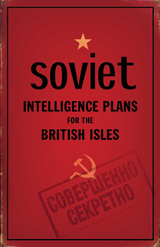 Soviet Intelligence Plans for the British Isles
John M. Davies and Alexander J. Kent
Bodleian Library Publishing During the Cold War, the Soviet military embarked on a massive project to map every corner of the globe. As part of this project, many cities and towns in the British Isles were mapped in astonishing detail and with great accuracy, providing the Soviet Union with strategic intelligence on key British and Irish locations. These were not simply copies of existing local maps, but included considerable original research. Following the collapse of the Soviet Union, news of the previously secret maps began to emerge, though little is still known about why they were made or how the information was gathered.
Drawing on an archive acquired by the Bodleian Library, John M. Davies and Alexander J. Kent examine the maps of more than thirty British and Irish towns, including, among many others, Liverpool, Manchester, Birmingham, Swansea, and Sheffield. They look at some of the notable inaccuracies and highlight the surprising wealth of information the maps contain, including bridge heights, river depths, street names, and every strategic installation of possible significance. In addition, their expert commentary offers suggestions about what the maps may reveal about the sources of the data.
A fascinating collection of documents concerning Cold War military intelligence, Soviet Intelligence Plans for the British Isles represents an intriguing exploration of how information was compiled during a period of deep mutual suspicion between the Soviet Union and the West.
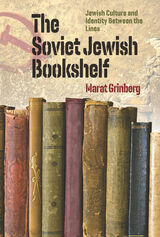 The Soviet Jewish Bookshelf: Jewish Culture and Identity Between the Lines
Marat Grinberg
Brandeis University Press, 2022 An original investigation into the reading strategies and uses of books by Jews in the Soviet era.
In The Soviet Jewish Bookshelf, Marat Grinberg argues that in an environment where Judaism had been all but destroyed, and a public Jewish presence routinely delegitimized, reading uniquely provided many Soviet Jews with an entry to communal memory and identity. The bookshelf was both a depository of selective Jewish knowledge and often the only conspicuously Jewish presence in their homes. The typical Soviet Jewish bookshelf consisted of a few translated works from Hebrew and numerous translations from Yiddish and German as well as Russian books with both noticeable and subterranean Jewish content. Such volumes, officially published, and not intended solely for a Jewish audience, afforded an opportunity for Soviet Jews to indulge insubordinate feelings in a largely safe manner. Grinberg is interested in pinpointing and decoding the complex reading strategies and the specifically Jewish uses to which the books on the Soviet Jewish bookshelf were put. He reveals that not only Jews read them, but Jews read them in a specific way.
 Soviet Leaders and Intelligence: Assessing the American Adversary during the Cold War
Raymond L. Garthoff
Georgetown University Press, 2015 During the Cold War, the political leadership of the Soviet Union avidly sought intelligence about its main adversary, the United States. Although effective on an operational level, Soviet leaders and their intelligence chiefs fell short when it came to analyzing intelligence. Soviet leaders were often not receptive to intelligence that conflicted with their existing beliefs, and analysts were reluctant to put forward assessments that challenged ideological orthodoxy. There were, however, important changes over time. Ultimately the views of an enlightened Soviet leader, Gorbachev, trumped the ideological blinders of his predecessors and the intelligence service’s dedication to an endless duel with their ideologically spawned “main adversary," making it possible to end the Cold War. Raymond Garthoff draws on over five decades of personal contact with Soviet diplomats, intelligence officers, military leaders, and scholars during his remarkable career as an analyst, senior diplomat, and historian. He also builds on previous scholarship and examines documents from Soviet and Western archives. Soviet Leaders and Intelligence offers an informed and highly readable assessment of how the Soviets understood—and misunderstood—the intentions and objectives of their Cold War adversary.
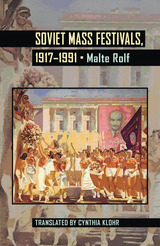 Soviet Mass Festivals, 1917–1991
Malte Rolf
University of Pittsburgh Press, 2013
Mass festivals were a trademark of twentieth-century authoritarianism, as seen in fascist Italy, Nazi Germany, and elsewhere. But nowhere was this phenomenon more prevalent than in the Soviet Union. Despite being a dominant feature of Soviet culture, these public spectacles have been largely overlooked as objects of study by historians.
Originally published in German, Malte Rolf’s highly acclaimed work examines the creation and perpetuation of large-scale celebrations such as May Day, the anniversary of the October Revolution, Harvest Day, and others throughout the Soviet era. He chronicles the overt political agendas, public displays of power, forced participation, and widespread use of these events in the Soviet drive to eradicate existing cultural norms and replace them with new icons of Soviet ideology. Rolf shows how the new Red Calendar became an essential tool in redefining celebrations in the Soviet Union.
Rolf traces the roots of Soviet mass festivals in disparate multiethnic celebrations, protests, and street marches during the late imperial era. He then contrasts these with postrevolutionary events that sought to dissolve ethnic rituals and unify the masses. By the end of the civil war, the Bolsheviks had a well-defined calendar of events and began to dictate the forms of public celebration in accordance with party rhetoric. In distant regions, organizers attempted to follow the models of Moscow and Leningrad, despite budgetary constraints and local resistance. In many outlying areas a hybridization of events developed as local customs merged with party mandates. People often made use of official holidays to adopt their own agendas, yet continued to follow the line of an official Soviet culture. Mass festivals were thus an important tool for Sovietizing the cultural landscape.
After the Second World War, the Soviets exported their festival culture to Eastern Europe and the Baltic states, which resulted in a melding of Soviet guidelines with national cultural forms. Additionally, Rolf compares and contrasts Soviet mass spectacles with mass events in Italy, Germany, and the United States to reveal their similar influence despite divergent political, cultural, and social systems.
In the Soviet Union, mass festivals continued through the time of Khrushchev, Brezhnev, and up until perestroika, despite their fading political impact. Rolf finds that in the end, Soviet celebrations became effectively ingrained in Russia’s post-Soviet national memory, which ironically was the intent of the original festival planners.
 Soviet Military Intervention in Hungary, 1956
Alexandr Kirov
Central European University Press, 2000 This first detailed account of Soviet military operations is based on access to unpublished material in Soviet archives, which have recently been reclassified. The major contribution made by the book is its source material, which reveals new information on the organization, command, strategy, and tactics of the Soviet armed forces which invaded Hungary in 1956. Particularly interesting is the precise documentation of the irrationally large size of the forces. The volume is based on research in Soviet archives, and this alone makes it of unique scholarly importance. The book opens with a substantial introductory essay by the editors, and includes a major study by the Russian military historian Alexandr Kirov, based on research in Soviet military archives. One of the real strengths of the book is that it also includes the memoirs of General Yevgeny Malashenko, in 1956 a colonel in the Soviet Army and acting Chief of Staff of the Special Corps in Budapest. He provides unparalleled insights into Soviet military procedures, politico-military co-operation, and the actual fighting strengths and weaknesses of the Red Army. Very few other high-ranking Soviet officers have ever published their memoirs in the West.
 Soviet Natural Resources in the World Economy
Edited by Robert G. Jensen, Theodore Shabad, and Arthur W. Wright
University of Chicago Press, 1983 Russia is a huge storehouse of natural resources, including oil, gas, and other energy sources, which she can trade with the rest of the world for advanced technology and wheat. In this book, leading experts evaluate the Soviet potential in major energy and industrial raw materials, giving special attention to implications for the world economy to the end of the twentieth century.
The authors examine the mineral and forest resources that the Soviet Union has developed and may yet develop to provide exports during the 1980s. They discuss the regional dimension of these resources, especially in Siberia and the Soviet Far East; individual mineral raw materials, such as petroleum, natural gas, timber, iron ore, manganese, and gold; and finally the role of raw materials in Soviet foreign trade.
The authors, representing the United States, Canada, and Great Britain, are primarily geographers, but they include economists, political scientists, and a geologist. Their work is based on primary sources (for most of these reports, current information is no longer being released to researchers) and on interviews with Soviet officials.
 The Soviet Nuclear Archipelago: A Historical Geography of Atomic-Powered Communism
Per Högselius
Central European University Press, 2024 The war in Ukraine, with the exposure of nuclear power stations and the danger of atomic warfare, has made the legacy of the Soviet nuclear sector of critical importance. The two authors map the Soviet nuclear industry in a shifting historical context, making sense of a complex socio-technical and environmental history. Taking an innovative approach, this book explores the history of atomic power in the former Soviet Union using the spatial dimensions of the nuclear industry as a point of departure. The key concept is that of the archipelago – a network of nuclear facilities spread throughout the Soviet territory, but mutually reliant on each other and densely connected. The story traces the emergence of nuclear science and technology for military and civilian purposes through to the post-Soviet Russian nuclear corporations as providers of resources and technology. The book explains how nuclear developments in the Soviet Union interacted with processes of environmental and landscape change. The spatial lens offers an analytically fruitful and pedagogically stimulating way to comprehend the nuclear histories of the Soviet Union and its successor states.
Soviet Occupation of Romania, Hungary, and Austria 1944/45–1948/49
László Borhi
Central European University Press, 2015 This book compares the various aspects – political, military economic – of Soviet occupation in Austria, Hungary and Romania. Using documents found in Austrian, Hungarian, Romanian and Russian archives the authors argue that the nature of Soviet foreign policy has been misunderstood. Existing literature has focused on the Soviet foreign policy from a political perspective; when and why Stalin made the decision to introduce Bolshevik political systems in the Soviet sphere of influence. This book will show that the Soviet conquest of East-Central Europe had an imperial dimension as well and allowed the Soviet Union to use the territory it occupied as military and economic space. The final dimension of the book details the tragically human experiences of Soviet occupation: atrocities, rape, plundering and deportations.
 Soviet Policy in West Africa
Robert Legvold
Harvard University Press, 1970 This is a study of Soviet policy in six West African countries: Ghana, Guinea, the Ivory Coast, Mali, Nigeria, and Senegal. Robert Legvold analyzes the awakening of Soviet Interest in sub-Saharan Africa and the growth, problems, and influences of the Soviet involvement from Ghana's independence in 1957 to 1968.
Those nations are significant not only because they were the first African colonies to achieve independence and therefore have had the longest involvement with the Soviet Union, but also because together they supply illustrations of every problem that Black Africa poses for an outside nation's foreign policy: from hypersensitive nationalism to what has been called neo-colonial dependence; from relative long-term stability to fundamental instability; from military coups d'état to civil war.
From the Soviet viewpoint the six countries range from the most progressive to the most reactionary. Each has had an interesting relationship with the Soviet Union.
The author considers several basic questions: How has the Soviet Union coped with the problems and opportunities created by Black Africa? How have its perceptions of Black Africa evolved during the first decade of its involvement there? Has policy shifted correspondingly with changes In these perceptions?Mr. Legvold explains why Black Africa lay largely ignored for years while Soviet leaders turned their attention to struggle and revolution in the Far East and South Asia. He has examined the Soviet and African press to trace the full evolution of Soviet attitudes and action in these countries, and has interviewed Soviet, African, and other officials. He compares Soviet policy as between one African nation and another, as well as between Africa and other continents.
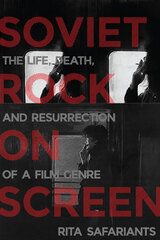 Soviet Rock on Screen: The Life, Death, and Resurrection of a Film Genre
Rita Safariants
University of Wisconsin Press, 2026 As the Iron Curtain fell and Cold War suspicions thickened in the second half of the twentieth century, the quintessentially American genre of rock and roll, seen as a potent symbol and product of an enemy ideology, quickly became a clandestine import in the USSR. The Soviet underground embraced the forbidden sounds, despite official propaganda that called rock stars social parasites and corrupting sluggards. Contrary to the regime’s desires, the genre grew in popularity until it could no longer be ignored. In the Soviet Union’s last decade, a flailing film industry, controlled by and dependent on an increasingly unstable central government, seized on the rock star as a central figure—and the Soviet rock film was born.
In Soviet Rock on Screen, Rita Safariants chronicles the birth, life, death, and resurrection of a genre that rapidly became one of the most readily recognized cultural signifiers of the perestroika era and which continues to reflect and codify Russian culture. During their initial heyday in the 1980s, rock films were influenced by and encouraged the cultural shifts of perestroika and the incipient political storm. Today, Safariants argues, the reemergence and reconfiguration of the genre indicates the extent to which Soviet-era cultural emblems inform Russian national identity and obliquely support the current political repression under Putin.
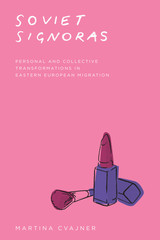 Soviet Signoras: Personal and Collective Transformations in Eastern European Migration
Martina Cvajner
University of Chicago Press, 2019 Across the Western world, the air is filled with talk of immigration. The changes brought by immigration have triggered a renewed fervor for isolationism able to shutter political traditions and party systems. So often absent from these conversations on migration are however the actual stories and experiences of the migrants themselves. In fact, migration does not simply transport people. It also changes them deeply. Enter Martina Cvajner’s Soviet Signoras, a far-reaching ethnographic study of two decades in the lives of women who migrated to northern Italy from several former Soviet republics.
Cvajner details the personal and collective changes brought about by the experience of migration for these women: from the first hours arriving in a new country with no friends, relatives, or existing support networks, to later remaking themselves for their new environment. In response to their traumatic displacement, the women of Soviet Signoras—nearly all of whom found work in their new Western homes as elder care givers—refashioned themselves in highly sexualized, materialistic, and intentionally conspicuous ways. Cvajner’s focus on overt sexuality and materialism is far from sensationalist, though. By zeroing in on these elements of personal identity, she reveals previously unexplored sides of the social psychology of migration, coloring our contemporary discussion with complex shades of humanity.
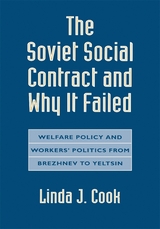 The Soviet Social Contract and Why It Failed: Welfare Policy and Workers’ Politics from Brezhnev to Yeltsin
Linda Cook
Harvard University Press, 1993 As their woefully backward economy continues to crumble, much of the Soviet population remains indifferent, if not downright hostile, to the idea of reform. This phenomenon, so different from the Solidarity movement in Poland or the velvet revolution in Czechoslovakia, has been explained in terms of a “social contract”—a tacit agreement between the post-Stalin regime and the working class whereby the state provided economic and social security in return for the workers' political compliance. This book is the first critical assessment of the likelihood and implications of such a contract.
Linda Cook pursues the idea from Brezhnev's day to our own, and considers the constraining effect it may have had on Gorbachev's attempts to liberalize the Soviet economy. In case studies on job security, retail price stability, and social service subsidies, Cook identifies points at which leaders had to make critical decisions—to commit more resources or to abandon other policies at significant cost—in order to maintain the contract. The pattern that emerges attests to the validity of the social contract thesis for the Brezhnev period. At the same time, Cook's analysis points to several important factors, such as the uneven distribution of benefits, that help explain why labor unrest and activism have varied dramatically from sector to sector in recent years.
Ultimately, these case studies reveal, particularly for the Gorbachev period, deep conflicts between the old contract and the requisites of economic reform. Cook extends her analysis into the Yeltsin period to show how the democratizing state dealt weakly with labor's demands, seeking to stabilize labor relations with an inappropriate corporate structure. In the end, mobilized labor contributed greatly to the pressures that undermined Gorbachev's regime, and remained an obstacle to economic reform through the early months of Yeltsin's Russia.
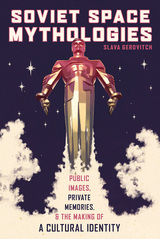 Soviet Space Mythologies: Public Images, Private Memories, and the Making of a Cultural Identity
Slava Gerovitch
University of Pittsburgh Press, 2015 Winner, 2021 Gardner-Lasser Aerospace History Literature Award
From the start, the Soviet human space program had an identity crisis. Were cosmonauts heroic pilots steering their craft through the dangers of space, or were they mere passengers riding safely aboard fully automated machines? Tensions between Soviet cosmonauts and space engineers were reflected not only in the internal development of the space program but also in Soviet propaganda that wavered between praising daring heroes and flawless technologies. Soviet Space Mythologies explores the history of the Soviet human space program within a political and cultural context, giving particular attention to the two professional groups—space engineers and cosmonauts—who secretly built and publicly represented the program. Drawing on recent scholarship on memory and identity formation, this book shows how both the myths of Soviet official history and privately circulating counter-myths have served as instruments of collective memory and professional identity. These practices shaped the evolving cultural image of the space age in popular Soviet imagination. Soviet Space Mythologies provides a valuable resource for scholars and students of space history, history of technology, and Soviet (and post-Soviet) history.
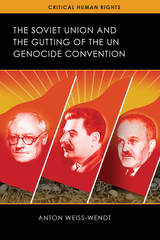 The Soviet Union and the Gutting of the UN Genocide Convention
Anton Weiss-Wendt
University of Wisconsin Press, 2017 After the staggering horrors of World War II and the Holocaust, the United Nations resolved to prevent and punish the crime of genocide throughout the world. The resulting UN Genocide Convention treaty, however, was drafted, contested, and weakened in the midst of Cold War tensions and ideological struggles between the Soviet Union and the West.
Based on extensive archival research, Anton Weiss-Wendt reveals in detail how the political aims of the superpowers rendered the convention a weak instrument for addressing abuses against human rights. The Kremlin viewed the genocide treaty as a political document and feared repercussions. What the Soviets wanted most was to keep the subjugation of Eastern Europe and the vast system of forced labor camps out of the genocide discourse. The American Bar Association and Senate Committee on Foreign Relations, in turn, worried that the Convention contained vague formulations that could be used against the United States, especially in relation to the plight of African Americans. Sidelined in the heated discussions, Weiss-Wendt shows, were humanitarian concerns for preventing future genocides.
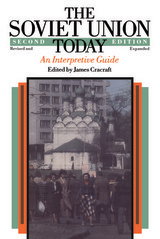 The Soviet Union Today: An Interpretive Guide
Edited by James Cracraft
University of Chicago Press, 1987 This newly revised and expanded second edition of The Soviet Union Today provides a comprehensive introduction to contemporary Soviet reality. Written by thirty experts, the book is divided into eight general sections: history, politics, the armed forces, the physical context, the economy, science and technology, culture, and society. The individual chapters, which are intended to respond to the questions most frequently asked about the Soviet Union, are devoted to everything from the Lenin cult to the KGB; from Soviet architecture to Soviet education; from the status of women and ethnic minorities to the question of religion. All of the chapters from the first edition have been updated, and five new chapters—on the Soviet cinema, mass media, foreign trade, arms control, and the legal system—have been added. An annotated list of further reading suggestions and a special "Note for Travelers" enhance this volume's usefulness. Students, teachers, journalists, prospective tourists, and anyone interested in Soviet life will find this new edition of The Soviet Union Today an essential and stimulating guide to understanding the world's largest country.
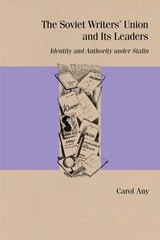 The Soviet Writers' Union and Its Leaders: Identity and Authority under Stalin
Carol Any
Northwestern University Press, 2021 Winner, University of Southern California Book Prize in Literary and Cultural Studies
The Soviet Writers’ Union offered writers elite status and material luxuries in exchange for literature that championed the state. This book argues that Soviet ruler Joseph Stalin chose leaders for this crucial organization, such as Maxim Gorky and Alexander Fadeyev, who had psychological traits he could exploit. Stalin ensured their loyalty with various rewards but also with a philosophical argument calculated to assuage moral qualms, allowing them to feel they were not trading ethics for self‑interest. Employing close textual analysis of public and private documents including speeches, debate transcripts, personal letters, and diaries, Carol Any exposes the misgivings of Writers’ Union leaders as well as the arguments they constructed when faced with a cognitive dissonance. She tells a dramatic story that reveals the interdependence of literary policy, communist morality, state‑sponsored terror, party infighting, and personal psychology. This book will be an important reference for scholars of the Soviet Union as well as anyone interested in identity, the construction of culture, and the interface between art and ideology.
 Soviet-American Relations After the Cold War
Robert Jervis and Seweryn Bialer, eds.
Duke University Press, 1991 This important collection of essays explores the terrain of possible Soviet-American relations in the next decade. Starting from the premise that glasnost and perestroika will not be reversed, this expert group of contributors provides a wide-ranging and far-reaching analysis of Soviet-U.S. relations crucial to any current discussion of the topic. Moving beyond the boundaries of traditional studies of international relations, the contributors here focus on such topics as public opinion and the relationship of domestic policy to foreign policy. Other areas of consideration include the Soviet-U.S. relationship and the Third World and East Asia, the role of the United Nations in Soviet and American policy in the 1990s, international environmental protection, and the Soviet opening to nonprovocative defense. A final section concludes with policy choices for the future regarding security strategies and prospects for peace. Contributors. Seweryn Bialer, Robert Dallek, Charles Gati, Toby Trister Gati, Colin S. Gray, Ole R. Holsti, Robert Jervis, Alexander J. Motyl, John Mueller, Eric A. Nordlinger, George H. Quester, Harold H. Sanders, Glenn E. Schweitzer, Jack Snyder, Donald S. Zagoria, William Zimmerman
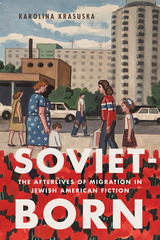 Soviet-Born: The Afterlives of Migration in Jewish American Fiction
Karolina Krasuska
Rutgers University Press, 2024 In 2010, when The New Yorker published a list of twenty writers under the age of forty who were “key to their generation,” it included five Jewish-identified writers, two of whom—American Gary Shteyngart and Canadian David Bezmozgis—were Soviet-born. This publicity came after nearly a decade of English-language literary output by Soviet-born writers of all genders in North America. Soviet-Born: The Afterlives of Migration in Jewish American Fiction traces the impact of these now numerous authors—among others, David Bezmozgis, Boris Fishman, Keith Gessen, Sana Krasikov, Ellen Litman, Gary Shteyngart, Anya Ulinich, and Lara Vapnyar—on major coordinates of the Jewish American imaginary.
Entering an immigrant, Soviet-born standpoint creates an alternative and sometimes complementary pattern of how the Eastern and Central European past and present resonate with American Jewishness. The novels, short stories, and graphic novels considered here often stage strikingly fresh variations on key older themes, including cultural geography, the memory of World War II and the Holocaust, communism, gender and sexuality, genealogy, and finally, migration. Soviet-Born demonstrates how these diasporic writers, with their critical stance toward identity categories, open up the field of what is canonically Jewish American to broader contemporary debates.
This book is also freely available online as an open-access digital edition.
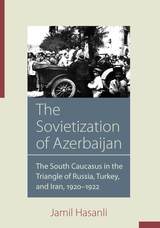 The Sovietization of Azerbaijan: The South Caucasus in the Triangle of Russia, Turkey, and Iran, 1920–1922
Jamil Hasanli
University of Utah Press, 2017 Utah Series in Middle East Studies
World War I and the fall of tsarist Russia brought brief independence to Azerbaijan, but by 1920 the Bolshevik revolution pushed south with the twofold purpose of accessing the oil-rich fields near Baku on the Caspian Sea and spreading communism into the Caucasus. Azerbaijan, the richest and earliest significant source of oil in the world, was the first republic in the South Caucasus occupied by the Red Army, which then advanced into neighboring Armenia and Georgia. Pulling from confidential, newly accessed archives, Hasanli describes Soviet Russia’s aggressive policy toward the three South Caucasian nations, which led to their absorption into the USSR by the end of 1922.
The book highlights the Caucasian peoples’ struggle to retain political independence against Soviet Russia and an international cast that included European powers wanting to retain petroleum concessions; Kemalist Turkey, which claimed special ties to the Turkic Azeris; and Iran, which controlled South Azerbaijan and was thus a possible route of expansion eastward for Bolshevik movement. The author also considers the impact on Azerbaijani-Armenian relations of the first two years of Sovietization and explains how Azerbaijan provided space for Bolshevik experiments. Throughout his book, Hasanli illuminates the tragedy of the complex, confused period of Sovietization of the South Caucasus.
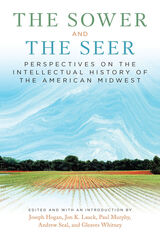 The Sower and the Seer: Perspectives on the Intellectual History of the American Midwest
Joseph Hogan
Wisconsin Historical Society Press, 2021 This collection of twenty-two essays, a product of recent revivals of interest in both Midwestern history and intellectual history, argues for the contributions of interior thinkers and ideas in forming an American identity.
The Midwest has been characterized as a fertile seedbed for the germination of great thinkers, but a wasteland for their further growth. The Sower and the Seer reveals that representation to be false. In fact, the region has sustained many innovative minds and been the locus of extraordinary intellectualism. It has also been the site of shifting interpretations—to some a frontier, to others a colonized space, a breadbasket, a crossroads, a heartland. As agrarian reformed (and Michigander) Liberty Hyde Bailey expressed in his 1916 poem “Sower and Seer,” the Midwestern landscape has given rise to significant visionaries, just as their knowledge has nourished and shaped the region.
The essays gathered for this collection examine individual thinkers, writers, and leaders, as well as movements and ideas that shaped the Midwest, including rural school consolidation, women’s literary societies, Progressive-era urban planning, and Midwestern radical liberalism. While disparate in subject and style, these essays taken together establish the irrefutable significance of the intellectual history of the American Midwest.
The Soweto Uprising
Noor Nieftagodien
Ohio University Press, 2015 The Soweto uprising was a true turning point in South Africa’s history. Even to contemporaries, it seemed to mark the beginning of the end of apartheid. This compelling book examines both the underlying causes and the immediate factors that led to this watershed event. It looks at the crucial roles of Black Consciousness ideology and nascent school-based organizations in shaping the character and form of the revolt. What began as a peaceful and coordinated demonstration rapidly turned into a violent protest when police opened fire on students. This short history explains the uprising and its aftermath from the perspective of its main participants, the youth, by drawing on a rich body of oral histories.
 Sowing Change: The Making of Havana's Urban Agriculture
Adriana Premat
Vanderbilt University Press, 2012 Following the dissolution of the Soviet bloc, Cuba found itself struggling to find its place in a new geopolitical context, while dealing with an unprecedented agricultural and food crisis that experts feel foreshadows the future of many countries across the globe. Sowing Change traces the evolution of the officially endorsed urban agriculture movement in the capital city of Havana, considering its political significance for the Cuban government and its import for transnational actors in the field of sustainable development. But the analysis does not stop at official understandings and representations of this movement. Rather, it brings into focus the perspectives of small-scale urban farmers--real men and women who live at the conceptual margins of the Cuban economy and struggle to balance personal needs and dreams with political ideals and government expectations, in a context where those very ideals and expectations continually shift. Sowing Change is a timely reflection on the changing agricultural, urban, and power landscapes of post-Soviet Cuba that, finally, queries common presumptions about this socialist nation and its now famous urban agriculture experience.
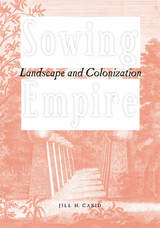 Sowing Empire: Landscape And Colonization
Jill H. Casid
University of Minnesota Press, 2005 Planting and transplanting, seeding and reshaping—landscaping practices that emerged in the eighteenth century—are inextricable from the contested terrain of empire within which they operated. From the plantations of the “nabobs” to the island gardens of narrative fiction, from William Beckford’s estate at Fonthill to Marie Antoinette’s ornamented farm, Sowing Empire considers imperial relandscaping—its patriarchal organization, heterosexual reproduction, and slavery—and how it contributed to the construction of imperial power. At the same time, the book shows how these picturesque landscapes and sugar plantations contained within them the seeds of resistance—how, for instance, slave gardens and the Afro-Caribbean practice of Vodou threatened authority and created new possibilities for once again transforming the landscape.In an ambitious work of wide-ranging literary, visual, and historical allusion, Jill H. Casid examines how landscaping functioned in an imperial mode that defined and remade the “heartlands” of nations as well as the contact zones and colonial peripheries in the West and East Indies. Revealing the colonial landscape as far more than an agricultural system—as a means of regulating national, sexual, and gender identities—Casid also traces how the circulation of plants and hybridity influenced agriculture and landscaping on European soil and how colonial contacts materially shaped what we take as “European.”Utilizing a wide range of both visual and written sources—maps, literature, and travel writing—this book is interdisciplinary in its methodology and in its scope. Sowing Empire explores how postcolonial and queer studies can alter art history and visual studies and, in turn, what close attention to the visual may offer to both postcolonial theorizing and historically and materially based colonial cultural studies.Jill H. Casid is assistant professor of art history and part of the developing transdisciplinary program in visual culture studies at the University of Wisconsin, Madison.
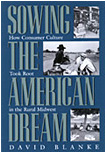 Sowing the American Dream: How Consumer Culture Took Root in the Rural Midwest
David Blanke
Ohio University Press, 2000 From 1840 to 1900, midwestern Americans experienced firsthand the profound economic, cultural, and structural changes that transformed the nation from a premodern, agrarian state to one that was urban, industrial, and economically interdependent. Midwestern commercial farmers found themselves at the heart of these changes. Their actions and reactions led to the formation of a distinctive and particularly democratic consumer ethos, which is still being played out today.
By focusing on the consumer behavior of midwestern farmers, Sowing the American Dream provides illustrative examples of how Americans came to terms with the economic and ideological changes that swirled around them. From the formation of the Grange to the advent of mail-order catalogs, the buying patterns of rural midwesterners set the stage for the coming century.
Carefully documenting the rise and fall of the powerful purchasing cooperatives, David Blanke explains the shifting trends in collective consumerism, which ultimately resulted in a significant change in the way that midwestern consumers pursued their own regional identity, community, and independence.
Sowing the Dragon’s Teeth: Byzantine Warfare in the Tenth Century
Eric McGeer
Harvard University Press, 1995 The military achievements of the emperors Nikephoros Phokas, John Tzimiskes, and Basil II brought the Byzantine Empire to the height of its power by the early eleventh century. This volume presents new editions and translations of two military treatises—the Praecepta militaria of Nikephoros Phokas and the revised version included in the Taktika of Nikephoros Ouranos—outlining the tactical system used by Byzantine armies in campaigns against Muslim forces in Cilicia and Syria. Products of experienced soldiers, the texts offer a realistic view of Byzantine warfare and reveal the sophistication of Byzantine military science.
Eric McGeer places the treatises in military historical context; explores the factors that led the Byzantine army to fight as it did; and investigates morale, discipline, and leadership—all of which determined the difference between failure and success.
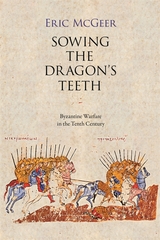 Sowing the Dragon’s Teeth: Byzantine Warfare in the Tenth Century
Eric McGeer
Harvard University Press The military achievements of the emperors Nikephoros Phokas, John Tzimiskes, and Basil II brought the Byzantine Empire to the height of its power by the early eleventh century. Sowing the Dragon’s Teeth presents new editions and translations of two military treatises—the Praecepta militaria of Nikephoros Phokas and the revised version included in the Taktika of Nikephoros Ouranos—outlining the tactical system used by Byzantine armies in campaigns against Muslim forces in Cilicia and Syria. Products of experienced soldiers, the texts offer a realistic view of Byzantine warfare and reveal the sophistication of Byzantine military science.
Eric McGeer places the treatises in their military historical context; explores the factors that led the Byzantine army to fight as it did; and investigates morale, discipline, and leadership—all of which determined the difference between failure and success.
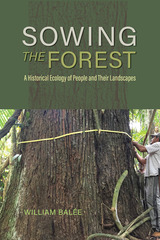 Sowing the Forest: A Historical Ecology of People and Their Landscapes
William Balée
University of Alabama Press, 2023 Explores how, over centuries, Amazonian people and their cultures have interacted with rainforests
William Balée is a world-renowned expert on the cultural and historical ecology of the Amazon basin. His new collection, Sowing the Forest, is a companion volume to the award-winning Cultural Forests of the Amazon, published in 2013. Sowing the Forest engages in depth with how, over centuries, Amazonian people and their cultures have interacted with rainforests, making the landscapes of palm forests and other kinds of forests, and how these and related forests have fed back into the vocabulary and behavior of current indigenous occupants of the remotest parts of the vast hinterlands.
The book is divided into two parts. Part 1, “Substrate of Intentionality,” comprises chapters on historical ecology, indigenous palm forests, plant names in Amazonia, the origins of the Amazonian plantain, and the unknown “Dark Earth people” of thousands of years ago and their landscaping. Together these chapters illustrate the phenomenon of feedback between culture and environment.
In Part 2, “Scope of Transformation,” Balée lays out his theory of landscape transformation, which he divides into two rubrics—primary landscape transformation and secondary landscape transformation—and for which he provides examples and various specific effects. One chapter compares environmental and social interrelationships in an Orang Asli group in Malaysia and the Ka’apor people of eastern Amazonian Brazil, and another chapter covers loss of language and culture in the Bolivian Amazon. A final chapter addresses the controversial topic of monumentality in the rainforest. Balée concludes by emphasizing the common thread in Amazonian historical ecology: the long-term phenomenon of encouraging diversity for its own sake, not just for economic reasons.
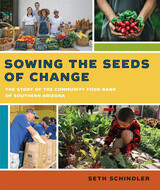 Sowing the Seeds of Change: The Story of the Community Food Bank of Southern Arizona
Seth Schindler
University of Arizona Press, 2021 This is the story of a remarkable organization’s sustained, compassionate response to a problem of staggering proportions: there are about 35 million food-insecure people in America today.
The numbers are no less shocking in southern Arizona: one in six residents, and one in four children, are food insecure. How can this be in the richest country in the world? This book explores that paradox and the innovative solutions that one organization has developed to create a healthier, more secure tomorrow for the less fortunate among us.
The Community Food Bank of Southern Arizona (CFB) is one of the oldest and most respected food banks in America. It is a widely recognized leader not simply in providing hunger relief but in attacking the root causes of hunger and poverty through community development, education, and advocacy. In 2018, Feeding America—the national organization of food banks—named it “Food Bank of the Year.” The CFB serves as a model for all nonprofits to follow, no matter their mission.
This profusely illustrated book chronicles the CFB’s amazing success and evolution from a tiny grassroots hunger-relief organization to one with more than six thousand workers and an annual budget exceeding $100 million. The book gives voice to the thousands of CFB participants past and present, weaving their profiles and quotes throughout the book. These profiles personalize the history of the CFB and give readers an insider’s perspective on the people and events that shaped the food bank’s success. It shows how individuals working together can help prevent hunger and break the cycle of poverty that is its cause.
The aim of Sowing the Seeds of Change is not to laud the CFB’s achievements. It is to demonstrate to readers that the war against hunger, despite the obstacles, can be won. And not tomorrow. Now!
Sowing the Seeds of Democracy in China: Political Reform in the Deng Xiaoping Era
Merle Goldman
Harvard University Press, 1994 The West’s leading authority on the role of intellectuals in contemporary China presents a percipient account of the efforts at political reform in the Deng Xiaoping era. Merle Goldman describes a group of highly placed intellectuals who, with the patronage of Deng Xiaoping’s designated successors Hu Yaobang and then Zhao Ziyang, attempted to reshape both China’s Marxist–Leninist ideology and its political system.
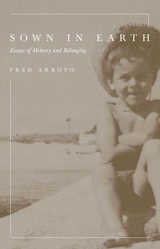 Sown in Earth: Essays of Memory and Belonging
Fred Arroyo
University of Arizona Press, 2020 Sown in Earth is a collection of personal memories that speak to the larger experiences of hardworking migratory men. Often forgotten or silenced, these men are honored and remembered in Sown in Earth through the lens of Arroyo’s memories of his father. Arroyo recollects his father’s anger and alcohol abuse as a reflection of his place in society, in which his dreams and disappointments are patterned by work and poverty, loss and displacement, memory and belonging.
In Sown in Earth, Arroyo often roots his thoughts and feelings in place, expressing a deep connection to the small homes he inhabited in his childhood, his warm and hazy memories of his grandmother’s kitchen in Puerto Rico, the rivers and creeks he fished, and the small cafés in Madrid that inspired writing and reflection in his adult years. Swirling in romantic moments and a refined love for literature, Arroyo creates a sense of belonging and appreciation for his life despite setbacks and complex anxieties along the way.
By crafting a written journey through childhood traumas, poverty, and the impact of alcoholism on families, Fred Arroyo clearly outlines how his lived experiences led him to become a writer. Sown in Earth is a shocking yet warm collage of memories that serves as more than a memoir or an autobiography. Rather, Arroyo recounts his youth through lyrical prose to humanize and immortalize the hushed lives of men like his father, honoring their struggle and claiming their impact on the writers and artists they raised.
 The Soybean Industry: With Special Reference to the Competitive Position of the Minnesota Producer and Processor
Ray A. Goldberg
University of Minnesota Press, 1952
The Soybean Industry was first published in 1952. Minnesota Archive Editions uses digital technology to make long-unavailable books once again accessible, and are published unaltered from the original University of Minnesota Press editions.
The rapid development of the soybean industry in the United States is reflected in the growth of the industry in Minnesota, a state that now ranks sixth in total production. This state was one of the last to develop a soybean crop, but in the decade from 1940 to 1950 the dollar value of its crop rose from $76,000 to $37,000,000.
Because the industry is a new and important one on the agricultural front, producers and processors in the industry, as well as members of the grain trade and agricultural economists, are faced with the problem of ascertaining the probably future trends of the industry. This study provides a factual basis for the industry's future planning in Minnesota and in other major soybean-producing and processing states.
Since the total picture of supply and demand and the operation of the industry within a single state are interrelated and interdependent, the study describes the elements of production, utilization, and processing on international, national, and state levels. These factors are then correlated with significant aspects of transportation, storage, commodity markets, and price formulation for an analysis of the competitive position of the industry in Minnesota. In conclusion, the future of the industry as a whole as well as specifically in Minnesota is estimated.
 Soybeans and Their Products: Markets, Models, and Policy
James P. Houck, Mary E. Ryan, and Abraham Subotnik
University of Minnesota Press, 1972
Soybeans and Their Products was first published in 1972. Minnesota Archive Editions uses digital technology to make long-unavailable books once again accessible, and are published unaltered from the original University of Minnesota Press editions.
This is the report of a comprehensive study designated to identify and measure empirically the forces, interrelationships, and processes which shape the behavior of the total soybean market. The research focused on the years from 1946 to 1967, a period when the soybean economy developed from its small beginnings to its present magnitude. Soybeans are now the leading oilseed in world trade; soybean oil is the most prominent among the many edible oils available in the world; and soybean meal stands first in importance in world markets for high-protein livestock feeds. As a top cash crop in U.S. agriculture soybeans are rivaled only by corn.
Much of the remarkable surge in soybean and related markets in recent years can be explained and analyzed by using the concepts of demand growth and commodity substitution developed in this book. In addition to serving the specific interests of commodity experts, the study will be useful to econometricians and price analysts as an example of empirical investigation of a major agricultural and industrial raw material.
The research was carried out through close cooperation between the University of Minnesota's Department of Agricultura and Applied Economics and the Economic and Statistical Analysis Division of the Economic Research Service, U.S. Department of Agriculture.
Space: A Memoir
Jesse Lee Kercheval
University of Wisconsin Press, 2014 Jesse Lee Kercheval opens her story in Cocoa, Florida, in 1966 as a precocious ten-year-old whose family—father, mother, two little girls—is trying to ride the Space Race’s tide of optimism. But even as the rockets keep going up, the Kercheval family slowly spirals down.
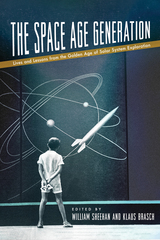 The Space Age Generation: Lives and Lessons from the Golden Age of Solar System Exploration
William Sheehan and Klaus Brasch
University of Arizona Press, 2024 In 1957 Sputnik launched toward the stars. President Kennedy then announced that the United States would send men to the Moon and then return them to Earth.These pivotal moments sparked an unequaled bound forward in human innovation and scientific exploration.
At the heart of this momentous time were the men and women working behind the scenes. Scientists, historians, and astronomers share their memories and contributions from this unparalleled era in essays told in their own words. They are the remarkable generation who witnessed and contributed to some of space science’s most stunning achievements. Here they have recorded their memories—their childhood inspirations, their challenges, failures, and triumphs—for future generations.
A unique and authoritative record of a momentous period in human history, The Space Age Generation highlights the golden age of space exploration and the people who made it happen.
Contributors
Leo Aerts
Alexander Basilevsky
Klaus Brasch
Clark R. Chapman
Dale P. Cruikshank
William K. Hartmann
William Leatherbarrow
Baerbel Koesters Lucchitta
Yvonne Pendleton
Peter H. Schultz
William Sheehan
Paolo Tanga
Charles A. Wood
 Space and Place in Jewish Studies
Mann, Barbara E
Rutgers University Press, 2012 Scholars in the humanities have become increasingly interested in questions of how space is produced and perceived—and they have found that this consideration of human geography greatly enriches our understanding of cultural history. This “spatial turn” equally has the potential to revolutionize Jewish Studies, complicating familiar notions of Jews as “people of the Book,” displaced persons with only a common religious tradition and history to unite them. Space and Place in Jewish Studies embraces these exciting critical developments by investigating what “space” has meant within Jewish culture and tradition—and how notions of “Jewish space,” diaspora, and home continue to resonate within contemporary discourse, bringing space to the foreground as a practical and analytical category. Barbara Mann takes us on a journey from medieval Levantine trade routes to the Eastern European shtetl to the streets of contemporary New York, introducing readers to the variety of ways in which Jews have historically formed communities and created a sense of place for themselves. Combining cutting-edge theory with rabbinics, anthropology, and literary analysis, Mann offers a fresh take on the Jewish experience.
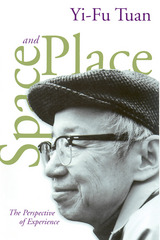 Space And Place: The Perspective of Experience
Yi-Fu Tuan
University of Minnesota Press, 2001 A study of the ways in which people feel and think about space, how they form attachments to home, neighborhood, and nation, and how feelings about space and place are affected by the sense of time.“Since it is the breadth and universality of his argument that concerns Yi-Fu Tuan, experience is defined as ‘all the modes by which a person knows and constructs reality,’ and examples are taken with equal ease from non-literate cultures, from ancient and modern oriental and western civilizations, from novels, poetry, anthropology, psychology, and theology. The result is a remarkable synthesis, which reflects well the subtleties of experience and yet avoids the pitfalls of arbitrary classification and facile generalization. For these reasons, and for its general tone and erudition and humanism, this book will surely be one that will endure when the current flurry of academic interest in environmental experience abates.” Canadian Geographer
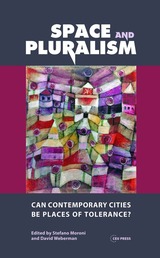 Space and Pluralism: Can Contemporary Cities Be Places of Tolerance?
Stefano Moroni
Central European University Press, 2016 This book addresses the social, functional and symbolic dimensions of urban space in today's world. The twelve essays are grouped in three parts, ranging from a conceptual framework to case descriptions rich with illustrations. They provide a valuable service in exploring the nature and significance of social space and particular aspects of its contemporary distribution and contestation. The book addresses a topic that is intrinsically interdisciplinary. Questions of space are examined from a rich variety of disciplinary perspectives in a welcome range from urban planning to political philosophy, shedding a good deal of light in the process. The issues in focus include the dichotomies of public and private space, discussion of rights and duties with regard to the use of space, or conflicts over its allocation. Well reasoned and presented discussion is offered from the perspective of basic values and rights. The policy issue of institutional recognition of the specifics of (minority community) identity is raised in opposition to abstract distributive accounts of justice.
Space and the Production of Cultural Difference among the Akha Prior to Globalization: Channeling the Flow of Life
Deborah E. Tooker
Amsterdam University Press, 2012
Based on the author's extensive fieldwork among the Akha people prior to full nation-state integration, this illuminating study critically reexamines assumptions about space, power, and the politics of identity, so often based on modern, western contexts. Tooker explores the active role that spatial practices have played in maintaining cultural autonomy. The book expands current debates about power relations in the region from a mostly political and economic framework into the domains of ritual, cosmology, and indigenous meaning and social systems.
Space and Time under Persecution: The German-Jewish Experience in the Third Reich
Guy Miron
University of Chicago Press, 2023 A new history of how the Nazi era upended German-Jewish experiences of space and time from eminent historian Guy Miron.
In Space and Time under Persecution, Guy Miron considers how social exclusion, economic decline, physical relocation, and, later, forced evictions, labor, and deportation under Nazi rule forever changed German Jews’ experience of space and time. Facing ever-mounting restrictions, German Jews reimagined their worlds—devising new relationships to traditional and personal space, new interpretations of their histories, and even new calendars to measure their days. For Miron, these tactics reveal a Jewish community’s attachment to German bourgeois life as well as their defiant resilience under Nazi persecution.
Space as Storyteller: Spatial Jumps in Architecture, Critical Theory, and Literature
Laura Chiesa
Northwestern University Press, 2016 Walter Benjamin's Arcades Project suggests that space can become a storyteller: if so, plenty of fleeting stories can be read in the space of modernity, where repetition and the unexpected cross-pollinate. In Space as Storyteller, Laura Chiesa explores several stories across a wide range of time that narrate spatial jumps, from Benjamin's tangential take on the cityscape, the experimentalism of Futurist theatricality, the multiple and potential atlases narrated by Italo Calvino and Georges Perec, and the posturban thought and practice of Bernard Tschumi and Rem Koolhaas/OMA. Space as Storyteller diverts attention from isolated disciplines and historical or geographical contexts toward transdisciplinary encounters that mobilize the potential to invent new spaces of comparison, a potential the author describes as "architecturability."
 Space Commerce
John L. McLucas
Harvard University Press, 1991 Space Commerce relates the story of private enterprise’s unsteady rise to prominence as a major influence on world space policy and research. The first space race proved the technological and military prowess of the two superpowers; but since the 1970s that contest has been supplanted by a multinational struggle to command the commercial opportunities of space.
The commercial space age was born in 1965 when Early Bird, the first commercial communications satellite, went into orbit. With characteristic ingenuity, American industrialists began to dream of garnering billions of dollars per year from space-based products and services. In the microgravity of space, they hoped, hitherto unavailable drugs could be produced that would revolutionize medicine; in the high vacuum of space, crystals of extreme purity could be grown in orbital laboratories, both for biological research and for application in the manufacture of advanced microcircuits.
John McLucas covers the broad sweep of space commerce, both the vision and the reality: the construction of communications satellites and their ground control stations; the sale and leasing of communications services; remote sensing and measurement of earth’s processes; navigation by satellites, serving ships, airplanes, and automobiles; the design and deployment of space laboratories for scientific research and product development; and life science experiments to determine the effects of space habitation on humans.
Drawing on his considerable expertise, McLucas brings a sober perspective to his assessment of the technological accomplishments as well as the challenges still faced by industry in space. He incorporates into his discussion an illuminating analysis of the economic and political impact of space commerce and its rapidly changing international character.
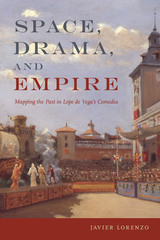 Space, Drama, and Empire: Mapping the Past in Lope de Vega's Comedia
Javier Lorenzo
Bucknell University Press, 2023 Spanish poet, playwright, and novelist Félix Lope de Vega (1562–1635) was a key figure of Golden Age Spanish literature, second only in stature to Cervantes, and is considered the founder of Spain’s classical theater. In this rich and informative study, Javier Lorenzo investigates the symbolic use of space in Lope’s drama and its function as an ideological tool to promote an imagined Spanish national past. In specific plays, this book argues, historical landscapes and settings were used to foretell and legitimize the imperial present in Hapsburg Spain, allowing audiences to visualize and plot, as on a map, the country’s expansionist trajectory throughout the centuries. By focusing on connections among space, drama, and empire, this book makes an important contribution to the study of literature and imperialism in early modern Spain and equally to our understanding of the role and political significance of spatiality in Siglo de Oro comedia.
A Space Filled with Moving
Maggie Anderson
University of Pittsburgh Press, 1992 Previous Praise for Maggie Anderson's Cold Comfort
"We are struck by the generosity of a voice that manages to bridge the gap between a personal and a world view, a balance that reveals a narrator who is of the world yet not overwhelmed by it."
—Prairie Schooner
Space, Geography, and Politics in the Early Roman Empire
Claude Nicolet
University of Michigan Press, 2015 Drawing on unexpected texts both ancient and modern, Space, Geography, and Politics in the Early Roman Empire offers startling insights into the character of Rome and its princeps-turned-emperor, Augustus. Claude Nicolet documents Roman expansion at the start of the early imperial period and explores how Romans came to map the world they knew and conquered. The roles of both the agrimensores, who worked in the state’s interest observing and recording new territories, and M. Vipsanius Agrippa, the sometime son-in-law of Emperor Augustus, are considered. Nicolet also presents the integral relations between territorial expansion and political expansion, as well as between propaganda cultivated in the national interest and propaganda designed to secure the status of the princeps as primus inter pares, first among equals.
Space, Images, and Art Perception in Napoleonic Paris: Setting the Gaze
Camilla Murgia
Amsterdam University Press, 2025 This book examines the impact of space on the perception of art and visual culture in early nineteenth-century Paris. It turns its attention to the way in which space determines the understanding and the development of visual culture. The abundance of images, their status, and their employment alike offer a means to grasp the extent of the development of an approach to art which further involved the spectator. Space is here conceived as a multifaceted entity, spanning architectural, scholarly, artistic, and visual dimensions. These various aspects offer means to consider the way in which images work and are consumed, and the individual experience they represent. Space works as a link and a connecting tool between different intellectual and visual categories, and this study examines how this interaction applies to works of art as well as everyday objects.
Space in Greek Tragedy (BICS Supplement 131)
Edited by Vassiliki Kampourelli
University of London Press, 2016 This book presents a critical application of semiotic models to Greek tragic space. It thus reappraises certain aspects of the tragic texts themselves by illuminating the semantics of space, that is, the ways in which space may contribute to the creation of meaning. After the formulation of a working model appropriate to the examination of space in Greek tragedy, an analysis of the proposed categories of tragic space follows. The architectural space of tragedy is then examined with particular reference to the ways in which it finds expression in the Theatre of Dionysus in Athens. Drawing widely on the works of Aeschylus, Sophocles and Euripedes, the focus turns to the interactions between the proposed categories of tragic space.
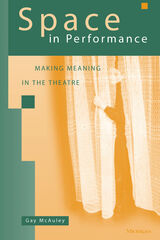 Space in Performance: Making Meaning in the Theatre
Gay McAuley
University of Michigan Press, 2000 Theater, as distinct from other dramatic media, is essentially a relationship between performer, spectator, and the space in which both come together. Space in Performance examines the way theater buildings function to frame the performance event, the organization of audience and practitioner spaces within the building, the nature of the stage and the modes of representation it facilitates, and the relationship between the real space of the theater and the fictional places that are evoked.
The book's theoretical and methodological framework is both semiotic and phenomenological, based in part from the seminal work of Anne Ubersfeld, from direct observation of the rehearsal process, and from documentation and analysis of professional performances. The situation of the academic observer in the rehearsal room has much in common with that of the ethnographer in the field, and contemporary ethnographic practice provides a third theoretical and methodological perspective to this study.
Performance studies is an emerging discipline, and it is still evolving appropriate methodologies. The multi-faceted approach adopted here will engage theater and performance studies specialists, those concerned with modes of representation in contemporary culture, and students of theater, semiotics, architecture, set design, acting and performance theory. It also offers a great deal to theater practitioners as well as to spectators interested in deepening their appreciation of theater art. It is written in a simple, accessible way, and the theory always emerges from descriptions of practice.
"An excellent study that imaginatively summarizes, synthesizes, and intelligently critiques a wide range of previous theory and practice while making an important new contribution to the field of theater studies." --Marvin Carlson, City University of New York
Gay McAuley is Director of the Centre for Performance Studies, University of Sydney.
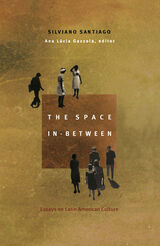 The Space In-Between: Essays on Latin American Culture
Silviano Santiago
Duke University Press, 2001 Silviano Santiago has been a pioneer in the development of concepts crucial to the discourse of contemporary critical and cultural theory, especially postcolonial theory. The notions of “hybridity” and “the space in-between” have been so completely absorbed into current theory that few scholars even realize these terms began with Santiago. He was the first to introduce poststructuralist thought to Brazil—via his publication of the Glossario de Derrida and his role as a prominent teacher. The Space In-Between translates many of his seminal essays into English for the first time and, in the process, introduces the thought of one of Brazil’s foremost critics and theorists of the late twentieth century.
Santiago’s work creates a theoretical field that transcends both the study of a specific national literature and the traditional perspectives of comparative literature. He examines the pedagogical and modernizing mission of Western voyagers from the conquistadors to the present. He deconstructs the ideas of “original” and “copy,” unpacking their implications for the notions of so-called dominant and dominated cultures. Santiago also confronts questions of cultural dependency and analyzes the problems involved in the imposition of an alien European history, the cultural displacements experienced by the Indians through their religious conversion, and the hierarchical suppression of native and Afro-Brazilian values.
Elegantly written and translated, The Space In-Between will provide insights and perspectives that will interest cultural and literary theorists, postcolonial scholars, and other students of contemporary culture.
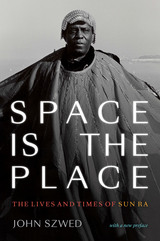 Space Is the Place: The Lives and Times of Sun Ra
John Szwed
Duke University Press, 2020 Considered by many to be a founder of Afrofuturism, Sun Ra—aka Herman Blount—was a composer, keyboardist, bandleader, philosopher, entrepreneur, poet, and self-proclaimed extraterrestrial from Saturn. He recorded over 200 albums with his Arkestra, which, dressed in Egypto-space costumes, played everything from boogie-woogie and swing to fusion and free jazz. John Szwed's Space is the Place is the definitive biography of this musical polymath, who was one of the twentieth century's greatest avant-garde artists and intellectuals. Charting the whole of Sun Ra's life and career, Szwed outlines how after years in Chicago as a blues and swing band pianist, Sun Ra set out in the 1950s to impart his views about the galaxy, black people, and spiritual matters by performing music with the Arkestra that was as vital and innovative as it was mercurial and confounding. Szwed's readers—whether they are just discovering Sun Ra or are among the legion of poets, artists, intellectuals, and musicians who consider him a spiritual godfather—will find that, indeed, space is the place.
 Space Monkeys!: Remembering the Nonhuman Astronauts in US Space Exploration
John A. Lynch
University of Alabama Press, 2026 Before humans ever left Earth’s atmosphere, a handful of primates paved the way—earning fame and fascination but leaving behind a complicated and often highly debated legacy. As the Cold War intensified, the US space program turned to monkeys—Able, Baker, Ham, and Enos—to test and explore the limits of human survival in space. These animals became media sensations, museum exhibits, and symbols of American ingenuity, even as their suffering was often overlooked. With insight and empathy, Lynch unpacks the stories we tell about these primates and how they are remembered through culture and time, both modern and historically. Lynch argues that the public memory of these animals often justifies their use in the name of scientific progress. Sometimes they are portrayed as tools, other times as human stand-ins, and frequently as objects of sympathy—but rarely as subjects of critique. Lynch shows how feelings—compassion, cuteness, patriotism, and the technological sublime—shape the stories we tell about these animals and the ethical frameworks we build around them. Each chapter focuses on a different genre of memory-making, from newspaper and photojournalism to museum exhibits, children’s literature, and fictional films. By reframing these animal pioneers, Lynch uncovers the ethical and emotional narratives that shape how we remember science. Space Monkeys! is a vital reflection on memory, identity, and the more-than-human costs of progress.
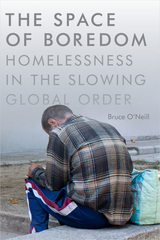 The Space of Boredom: Homelessness in the Slowing Global Order
Bruce O'Neill
Duke University Press, 2017 In The Space of Boredom Bruce O'Neill explores how people cast aside by globalism deal with an intractable symptom of downward mobility: an unshakeable and immense boredom. Focusing on Bucharest, Romania, where the 2008 financial crisis compounded the failures of the postsocialist state to deliver on the promises of liberalism, O'Neill shows how the city's homeless are unable to fully participate in a society that is increasingly organized around practices of consumption. Without a job to work, a home to make, or money to spend, the homeless—who include pensioners abandoned by their families and the state—struggle daily with the slow deterioration of their lives. O'Neill moves between homeless shelters and squatter camps, black labor markets and transit stations, detailing the lives of men and women who manage boredom by seeking stimulation, from conversation and coffee to sex in public restrooms or going to the mall or IKEA. Showing how boredom correlates with the downward mobility of Bucharest's homeless, O'Neill theorizes boredom as an enduring affect of globalization in order to provide a foundation from which to rethink the politics of alienation and displacement.
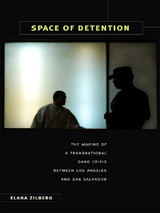 Space of Detention: The Making of a Transnational Gang Crisis between Los Angeles and San Salvador
Elana Zilberg
Duke University Press, 2011 Space of Detention is a powerful ethnographic account and spatial analysis of the “transnational gang crisis” between the United States and El Salvador. Elana Zilberg seeks to understand how this phenomenon became an issue of central concern for national and regional security, and how La Mara Salvatrucha, a gang founded by Salvadoran immigrants in Los Angeles, came to symbolize the “gang crime–terrorism continuum.” She follows Salvadoran immigrants raised in Los Angeles, who identify as—or are alleged to be—gang members and who are deported back to El Salvador after their incarceration in the United States. Analyzing zero-tolerance gang-abatement strategies in both countries, Zilberg shows that these measures help to produce the very transnational violence and undocumented migration that they are intended to suppress. She argues that the contemporary fixation with Latino immigrant and Salvadoran street gangs, while in part a product of media hype, must also be understood in relation to the longer history of U.S. involvement in Central America, the processes of neoliberalism and globalization, and the intersection of immigration, criminal, and antiterrorist law. These forces combine to produce what Zilberg terms “neoliberal securityscapes.”
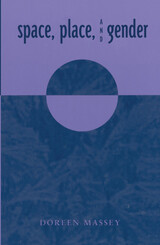 Space, Place, and Gender
Doreen Massey
University of Minnesota Press, 1994 A leading feminist geographer puts forth new ways of thinking about space and place.
In these days of global acceleration on the one hand and intensifying local nationalisms on the other, how should we be thinking about space and place? This new book brings together Doreen Massey's key writings on this debate. In it she argues that we have seen some problematical readings of both terms in recent years, and she proposes an alternative approach more adequate to the issues facing the social sciences today.
Massey has organized these debates around the three themes of space, place, and gender. She traces the development of ideas about the social structure of space and place, and the relation of both to issues of gender and certain debates within feminism. Beginning with the economy and social structures of production, Massey develops a wider notion of spatiality as the product of intersecting social relations. On this basis she proposes an approach to "places" that is essentially open and hybrid while always provisional and contested. The themes intersect with much current thinking about identity within feminism and cultural studies.
The chapters range from studies of the concepts of place employed in debates on uneven regional development and inner-city problems to arguments about the relationship between the conceptualization of space/place and the social construction of gender relations.
"This book presents a collection of Massey's writings that have appeared over the last two decades. The volume is, however, more than a sum of its parts, in that Massey uses commentaries throughout the book to delineate an intellectual trajectory in Anglo geography that connects the concerns of economic geography with critiques and extensions by feminist and postcolonial writers. Massey builds a multifaceted argument of the richness of geographical analysis and its centrality for contemporary social theory debates." Professional Geographer
"In a compilation of essays spanning over fifteen years, Space, Place and Gender, Doreen Massey explores the intricate and profound connection of space and place with gender and the construction of gender relations. Spaces and places are gendered, she argues, at once reflecting and affecting how gender is understood." Harvard Design Magazine
Doreen Massey is professor of geography at the Open University in the United Kingdom. She is the author of five books, including Spatial Divisions of Labour (1984) and, with David Weild and Paul Quintas, High-Tech Fantasies (1991).
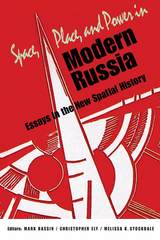 Space, Place, and Power in Modern Russia: Essays in the New Spatial History
Mark Bassin
Northern Illinois University Press, 2018
Exploring the creation, transformation, and imagination of Russian space as a lens through which to understand Russia's development over the centuries, this volume makes an important contribution to Russian studies and the "new spatial history." It considers aspects of the relationship between place and power in Russia from the local level to the national and from the 18th century through the present.
Essays include:
Melissa K. Stockdale, “What is a Fatherland? Changing Notions of Duty, Rights and Belonging in Russia”
Mark Bassin, “Nationhood, Natural Regions, Mestorazvitie: Environmental Discourses in Classic Eurasianism”
John Randolph, “Russian Route: The Politics of the Petersburg-Moscow Road, 1700-1800”
Richard Stites, “On the Dance Floor: Royal Power, Class, and Nationality in Servile Russia”
Patricia Herlihy, “Ab Oriente ad Ultimum Oriente: Eugen Scuyler, Russia and Central Asia”
Robert Argenbright, “Soviet Agitational Vehicles: Colonization from Place to Place”
Christopher Ely, “Street Space and Political Culture under Alexander II”
Sergei Zhuk, “Unmakinig the ‘Sacred Landscape’ of Orthodox Russia: Religious Pluralism, Identity Crisis, and Religious Politics on the Ukrainian Borderlands of the late Russian Empire”
Cathy A. Frierson, “Filling in the Map for Vologda’s Post-Soviet Identity”
Lisa A, Kirschenbaum, “Place, Memory and the Politics of Identity: Historical Buildings and Street Names in Leningrad-St. Petersburg”
Space Robotics and Autonomous Systems: Technologies, advances and applications
Yang Gao
The Institution of Engineering and Technology, 2021 Space robotics and autonomous systems (Space RAS) play a critical role in the current and future development of mission-defined machines that can survive in space while performing exploration, assembly, construction, maintenance and servicing tasks. They represent a multi-disciplinary emerging field at the intersection of space engineering, terrestrial robotics, computer science and materials. The field is essential to humankind's ability to explore or operate in space; providing greater access beyond human spaceflight limitations in the harsh environment of space, and offering greater operational handling that extends astronauts' capabilities. Space RAS covers all types of robotics for the exploration of planet surfaces as well as robotics used in orbit around the Earth and the sensors needed by the platform for navigation or control.
Space, Site, Intervention: Situating Installation Art
Erika Suderburg
University of Minnesota Press, 2000 In Space, Site, Intervention, some of today's most prominent art critics, curators, and artists view installation art as a diverse, multifaceted, and international art form that challenges institutional assumptions and narrow conceptual frameworks. Together, the essays in Space, Site, Intervention investigate how installation resonates within modern culture and society, as well as its ongoing influence on contemporary visual culture. Contributors: C. Ondine Chavoya, John Coleman, Sean Cubitt, Colin Gardner, Chrissie Iles, Miwon Kwon, Ernest Larsen, Tiffany Ana López, Catherine Lord, Kevin McMahon, James Meyer, Alessandra Moctezuma, Leda Ramos, Laurence A. Rickels, Barbara Maria Stafford, Susan Stewart, Marita Sturken, and John C. Welchman.
 The Space Station: A Personal Journey
Hans Mark
Duke University Press, 1987 This insider's account, a penetrating view of science policy and politics during two presidencies, captures the euphoria that characterized the space program in the late seventies and early eighties and furnishes an invaluable perspective on the Challenger tragedy and the future of the United States in space. President Reagan's approval of $8 billion for the construction of a permanently manned orbiting space station climaxed one of the most important political and technological debates in the history of the U.S. program in space.
In The Space Station the story of this debate is told by Hans mark, who had major roles in the development of the space shuttle from its beginnings in the sixties and who bore a primary responsibility for overseeing the space station project during the decisive years from 1981 to 1984. Mark's appointment to the post of deputy administrator of NASA capped a career devoted to the development and management of space technology—he served as director of NASA's Ames Research Center, then as under secretary and later secretary of the U.S. Air Force. Serving under both President Carter and President Reagan, mark is uniquely able to chronicle the intricate process by which the space shuttle became a reality and the space station an acknowledged goal of the American space effort.
A scientist by training, Mark's account of his career in the space program is the story of a personal dream as well as the story of a vast public enterprise whose human side is only now being fully appreciated.
 Space Syntax: Selected Papers by Bill Hillier
Edited by Laura Vaughan, John Peponis, and Ruth Dalton
University College London, 2025 Discover the visionary ideas that redefined architecture and urbanism—Bill Hillier’s most influential writings on space syntax, all in one critical volume.
Few scholars have reshaped our understanding of architecture and urban design as profoundly as Bill Hillier. Space Syntax compiles the most influential works from his career, spanning over half a century, to showcase the evolution of his innovative theories on the spatial structure of cities and the social functions of built environments.
Including his early explorations of architecture as a research discipline and his later theories on how spatial configurations influence human movement and urban vitality, this collection provides a definitive overview of Hillier’s intellectual legacy. Featuring newly redrawn figures, rare texts, and expert introductions from leading theorists and practitioners, the volume offers fresh viewpoints on the continued relevance of space syntax in contemporary research and practice.
Relevant to subjects ranging from archaeology to physics, Space Syntax cements Hillier’s place as a revolutionary thinker whose ideas continue to shape how we design and understand space.
 Space, Time and Architecture: The Growth of a New Tradition, Fifth Revised and Enlarged Edition
Sigfried Giedion
Harvard University Press, 1969 "The standard work on the development of modern architecture."—Walter Gropius
"Giedion’s accomplishment remains unmatched."—José Luis Sert
Sigfried Giedion was an unlikely candidate for the Charles Eliot Norton Professorship in Poetry at Harvard. Trained as a mechanical engineer and an art historian, the Swiss polymath had a tenuous command of English and little name recognition when he accepted the prestigious yearlong post in 1938, narrowly edging out the novelist Thomas Mann. After his twelve Norton Lectures were published in 1941, however, they quickly captured the imagination of a generation of artists, architects, and students.
Revised and expanded four times since its initial publication and translated into half a dozen languages, Space, Time and Architecture remains an unsurpassed classic in its field—a veritable bible of architectural modernism. Giedion delves deeply into the techniques that have made modern architecture possible, from the development of structural engineering to the increasingly sophisticated uses of concrete, glass, and steel. Yet he never loses sight of the human feelings and activities that bring structures to life. Starting with the one-point perspective that defined the Renaissance città ideale and moving through the stark geometries of Le Corbusier and Mies van der Rohe, he vividly illustrates how evolving conceptions of space, time, and motion have molded both the contours of our built environment and our daily lives.
Weaving a rich visual tapestry, Space, Time and Architecture juxtaposes over five hundred architectural drawings and photographs with painting, sculpture, and industrial design to make surprising connections across scale and medium. Throughout, Giedion remains tenaciously convinced that architecture offers hope for a grand unification: of reason and emotion, of science and art, and even of human civilization itself.
Space, Time, and Gravity: The Theory of the Big Bang and Black Holes
Robert M. Wald
University of Chicago Press, 1992 Writing for the general reader or student, Wald has completely revised and updated this highly regarded work to include recent developments in black hole physics and cosmology. Nature called the first edition "a very readable and accurate account of modern relativity physics for the layman within the unavoidable constraint of almost no mathematics. . . . A well written, entertaining and authoritative book."
Spacecraft Technology: The early years
Mark Williamson
The Institution of Engineering and Technology, 2006 Spacecraft Technology: The early years charts the fascinating story of the early Space Age, encompassing the launch of the first satellites and the landing of men on the Moon. While concentrating on the most significant technology developments, it places them in the context of historical events, specific missions and the individuals that made it all happen.
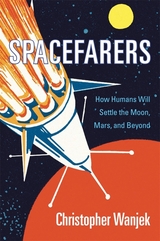 Spacefarers: How Humans Will Settle the Moon, Mars, and Beyond
Christopher Wanjek
Harvard University Press, 2020 A Telegraph Best Science Book of the Year
“A witty yet in-depth exploration of the prospects for human habitation beyond Earth…Spacefarers is accessible, authoritative, and in the end, inspiring.”
—Richard Panek, author of The Trouble with Gravity
It’s been over fifty years since Apollo 11 landed on the moon. So why is there so little human presence in space? Will we ever reach Mars? And what will it take to become a multiplanet species? While many books have speculated on the possibility of living beyond the Earth, few have delved into the practical challenges.
A wry and compelling take on the who, how, and why of near-future colonies in space, Spacefarers introduces us to the engineers, scientists, planners, dreamers, and entrepreneurs who are striving right now to make life in space a reality. While private companies such as SpaceX are taking the lead and earning profits from human space activity, Christopher Wanjek is convinced this is only the beginning. From bone-whittling microgravity to eye-popping profits, the risks and rewards of space settlement have never been so close at hand. He predicts we will have hotels in low-earth orbit, mining and tourism on the Moon, and science bases on Mars—possibly followed (gravity permitting) by full blown settlements.
“Nerdily engaging (and often funny)…Technology and science fiction enthusiasts will find much here to delight them, as Wanjek goes into rich detail on rocketry and propulsion methods, including skyhooks and railguns to fling things into orbit…He is a sensible skeptic, yet also convinced that, in the long run, our destiny is among the stars.”
—The Guardian
“If the events of this year have had you daydreaming about abandoning the planet entirely, [Spacefarers] is a geekily pleasurable survey of the practicalities and challenges.”
—The Telegraph
“The best book I’ve read on space exploration since Isaac Asimov.”
—Michael Shermer, publisher of Skeptic
Spaceflight and the Myth of Presidential Leadership
Edited by Roger D. Launius and Howard E. McCurdy
University of Illinois Press, 1997 Setting the tone for the collection, NASA chief historian Roger D. Launius and Howard McCurdy maintain that the nation's presidency had become imperial by the mid-1970s and that supporters of the space program had grown to find relief in such a presidency, which they believed could help them obtain greater political support and funding. Subsequent chapters explore the roles and political leadership, vis-à-vis government policy, of presidents Eisenhower, Kennedy, Johnson, Nixon, Ford, Carter, and Reagan.
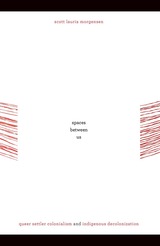 Spaces between Us: Queer Settler Colonialism and Indigenous Decolonization
Scott Lauria Morgensen
University of Minnesota Press, 2011 We are all caught up in one another, Scott Lauria Morgensen asserts, we who live in settler societies, and our interrelationships inform all that these societies touch. Native people live in relation to all non-Natives amid the ongoing power relations of settler colonialism, despite never losing inherent claims to sovereignty as indigenous peoples. Explaining how relational distinctions of “Native” and “settler” define the status of being “queer,” Spaces between Us argues that modern queer subjects emerged among Natives and non-Natives by engaging the meaningful difference indigeneity makes within a settler society. Morgensen’s analysis exposes white settler colonialism as a primary condition for the development of modern queer politics in the United States. Bringing together historical and ethnographic cases, he shows how U.S. queer projects became non-Native and normatively white by comparatively examining the historical activism and critical theory of Native queer and Two-Spirit people. Presenting a “biopolitics of settler colonialism”—in which the imagined disappearance of indigeneity and sustained subjugation of all racialized peoples ensures a progressive future for white settlers—Spaces between Us newly demonstrates the interdependence of nation, race, gender, and sexuality and offers opportunities for resistance in the United States.
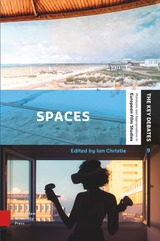 Spaces: Exploring Spatial Experiences of Representation and Reception in Screen Media
Ian Christie
Amsterdam University Press, 2024 Film has long been defined as a temporal art, most famously by André Bazin and Andrei Tarkovsky. Yet more fundamentally it has always been a spatial art, transporting its audiences imaginatively to spaces and places other than those they literally inhabit. In the digital era, this spatial illusion and paradox has been greatly expanded – by the predominance of domestic film viewing, along with new extra-terrestrial perspectives, and the promise of novel kinesthetic experiences with Virtual Reality and “immersion”. The international authors in this collection address the history and aesthetics of screen media as spatial transposition, in a range of exemplary analyses that run from the landscapes of John Ford’s westerns to Chantal Akerman’s claustrophobic domestic spaces, from the conventions of the English country house film to Patrick Keiller’s Robinson roaming a changed country, and from the experiences of Covid pandemic confinement to those of un-homed van-dwellers in Chloe Zhao’s award-winning NOMADLAND.
Spaces of Communication: Elements of Semio-Pragmatics
Roger Odin
Amsterdam University Press, 2022 Spaces of Communication offers a concise introduction to semiopragmatics and condenses the intellectual trajectory of one of the foundational figures of film studies into a relatively short and accessible volume. It testifies to the author’s deep and rich intellectual engagement with a vast array of objects ranging from the classics of the cinephile canon to television news programs, home movies and mobile phone films.
 Spaces of Creative Resistance: Social Change Projects in Twenty-First-Century East Asia
Andrea Gevurtz Arai
Rutgers University Press, 2025 Spaces of Creative Resistance: Social Change Projects in Twenty-First-Century East Asia brings together an exciting cross-regional interdisciplinary group of scholars, scholar activists, artists, and others for a collection that addresses the last two decades' hollowing out of social connections, socioeconomic income gaps, and general precarity of life in East Asian societies. Written by authors from China, Japan, South Korea, Taiwan, and Hong Kong, each chapter is focused on people making a difference together in socially sustainable ways, particularly in the areas of gender, labor, and environments—both built and natural. These projects all constitute acts of creative resistance to neoliberal development, and each act of creative resistance demonstrates how individuals and communities across East Asia are making new worlds and lifeways in the small and everyday. Taking on larger political and economic forces that affect their lives and communities, each project and group of individuals featured here is focused on making more liveable presents and more possible futures.
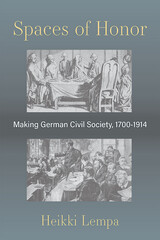 Spaces of Honor: Making German Civil Society, 1700-1914
Heikki Lempa
University of Michigan Press, 2021 The common understanding is that honor belongs to a bygone era, whereas civil society belongs to the future and modern society. Heikki Lempa argues that honor was not gone or even in decline between 1700 and 1914, and that civil society was not new but had long roots that stretched into the Middle Ages. In fact, what is peculiar for this era in Germany were the deep connections between practices of honor and civil society. This study focuses on collective actions of honor and finds them, in a series of case studies, at such communal spaces as schools, theaters, lunch and dinner tables, spas, workers’ strikes, and demonstrations. It is in these collective actions that we see civil society in making. The Spaces of Honor sees civil society not primarily as an idea or an intellectual project but as a set of practices shaped in physical spaces. Around 1700, the declining power of religious authorities allowed German intellectuals to redefine civil society, starting with a new language of honor. Then, in the middle of the eighteenth century, an increasing number of voluntary associations and public spaces turned it into reality. Here, honor provided cohesion. In the nineteenth century, urbanization and industrialization ushered in powerful forces of atomization that civil society attempted to remedy. The remedy came from social and physical spaces that generated a culture of honor and emotional belonging. We find them in voluntary associations, spas, revived guilds, and labor unions. By the end of the nineteenth century, honor was deeply embedded in German civil society.
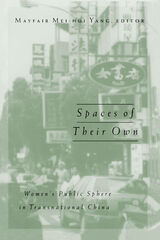 Spaces Of Their Own: Women’s Public Sphere in Transnational China
Mayfair Mei-Hui Yang
University of Minnesota Press, 1999 An exploration of women’s public expression--in China and beyond. How are the public and political lives of Chinese women constrained by states and economies? And how have pockets of women’s consciousness come to be produced in and disseminated from this traditionally masculine milieu? The essays in this volume examine the possibilities for a public sphere for Chinese women, one that would emerge from concrete historical situations and local contexts and also cut across the political boundaries separating the Mainland, Taiwan, Hong Kong, and the West. The challenges of this project are taken up in essays on the legacy of state feminism on the Mainland as contrasted with a grassroots women’s movement in Taiwan; on the role of the capitalist consumer economy in the emerging lesbian movement in Taiwan; and on the increased trafficking of women as brides, prostitutes, and mistresses between the Mainland and wealthy male patrons in Taiwan and Hong Kong. The writers’ examples of masculine domination in the media include the reformulation of Chinese women in Fifth Generation films for a transnational Western male film audience and the portrayal of Mainland women in Taiwanese and Hong Kong media. The contributors also consider male nationalism as it is revealed through both international sports coverage on television and in a Chinese television drama. Other works examine a women’s museum, a telephone hotline in Beijing, the films of Hong Kong filmmaker Ann Hui, the transnational contacts of a Taiwanese feminist organization, the diaspora of Mainland women writers, and the differences between Chinese and Western feminist themes.Contributors: Susan Brownell, U of Missouri; Virginia Cornue; Dai Jinhua, Beijing U; Kathleen Erwin; Elaine Yee Lin Ho, Hong Kong U; Lee Yuan-chen, Tamkang U; Li Xiaojiang, Zhengzhou U and Henan U; Lisa Rofel, U of California, Santa Cruz; Tze-lan Deborah Sang, U of Oregon; Shu-mei Shih, UCLA; Zhang Zhen. ISBN 0-8166-3145-X Cloth $49.95xxISBN 0-8166-3146-8 Paper $19.95x336 pages 9 black-and-white photos 5 7/8 x 9 FebruaryPublic Worlds Series, volume 4Translation inquiries: University of Minnesota Press
The Spaces of Violence
James R. Giles
University of Alabama Press, 2006 Probes the interrelationship of violence and space in ten contemporary American novels
In The Spaces of Violence, James R. Giles examines ten contemporary American novels for the unique ways in which they explore violence and space as interrelated phenomena. These texts are Russell Banks’s Affliction, Cormac McCarthy’s Outer Dark and Child of God, Lewis Nordan’s Wolf Whistle, Dorothy Allison’s Bastard Out of Carolina, Don DeLillo’s End Zone, Denis Johnson’s Angels, Sherman Alexie’s Indian Killer, Robert Stone’s Dog Soldiers, and Bret Easton Ellis’s American Psycho. A concluding chapter extends the focus to texts by Jane Smiley, Toni Morrison, Edwidge Danticat, and Chuck Palahniuk, who treat the destructive effects of violence on family structures.
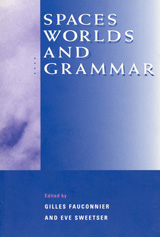 Spaces, Worlds, and Grammar
Edited by Gilles Fauconnier and Eve Sweetser
University of Chicago Press, 1996 In the highly influential mental-spaces framework developed by Gilles Fauconnier in the mid-1980s, the mind creates multiple cognitive "spaces" to mediate its understanding of relations and activities in the world, and to engage in creative thought.
These twelve original papers extend the mental-spaces framework and demonstrate its utility in solving deep problems in linguistics and discourse theory. Investigating the ties between mental constructs, they analyze a wide range of phenomena, including analogical counterfactuals; the metaphor system for conceptualizing the self; abstract change expressions in Japanese; mood in Spanish; deictic expressions; copular sentences in Japanese; conditional constructions; and reference in American Sign Language.
The ground-breaking research presented in this volume will be of interest to linguists and cognitive scientists.
The contributors are Claudia Brugman, Gilles Fauconnier, George Lakoff, Yo Matsumoto, Errapel Mejias-Bikandi, Laura A. Michaelis, Gisela Redeker, Jo Rubba, Shigeru Sakahara, Jose Sanders, Eve Sweetser, and Karen van Hoek.
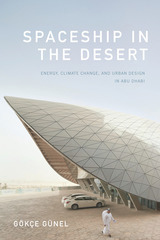 Spaceship in the Desert: Energy, Climate Change, and Urban Design in Abu Dhabi
Gökçe Günel
Duke University Press, 2019 In 2006 Abu Dhabi launched an ambitious project to construct the world’s first zero-carbon city: Masdar City. In Spaceship in the Desert Gökçe Günel examines the development and construction of Masdar City's renewable energy and clean technology infrastructures, providing an illuminating portrait of an international group of engineers, designers, and students who attempted to build a post-oil future in Abu Dhabi. While many of Masdar's initiatives—such as developing a new energy currency and a driverless rapid transit network—have stalled or not met expectations, Günel analyzes how these initiatives contributed to rendering the future a thinly disguised version of the fossil-fueled present. Spaceship in the Desert tells the story of Masdar, at once a “utopia” sponsored by the Emirati government, and a well-resourced company involving different actors who participated in the project, each with their own agendas and desires.
Spacetime And Geometry: The Alfred Schild Lectures
Edited by Richard A. Matzner and L. C. Shepley
University of Texas Press, 1982 These reports, at the forefront of relativity theory when they were written, in particular the geometrical aspects of spacetime theory, were the result of the Alfred Schild Memorial Lecture Series presented at the University of Texas at Austin beginning in 1977. Each article is a self-contained summary of an important area of contemporary gravitational physics, while the book as a whole provides an overview of a wide variety of the problems of general relativity and gravitation.
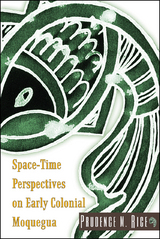 Space-Time Perspectives on Early Colonial Moquegua
Prudence M. Rice
University Press of Colorado, 2024 In this rich study of the construction and reconstruction of a colonized landscape, Prudence M. Rice takes an implicit political ecology approach in exploring encounters of colonization in Moquegua, a small valley of southern Peru. Building on theories of spatiality, spatialization, and place, she examines how politically mediated human interaction transformed the physical landscape, the people who inhabited it, and the resources and goods produced in this poorly known area. Space-Time Perspectives on Early Colonial Moquegua looks at the encounters between existing populations and newcomers from successive waves of colonization, from indigenous expansion states (Wari, Tiwanaku, and Inka) to the foreign Spaniards, and the way each group “re-spatialized” the landscape according to its own political and economic ends. Viewing these spatializations from political, economic, and religious perspectives, Rice considers both the ideological and material occurrences. Concluding with a special focus on the multiple space-time considerations involved in Spanish-inspired ceramics from the region, Space-Time Perspectives on Early Colonial Moquegua integrates the local and rural with the global and urban in analyzing the events and processes of colonialism. It is a vital contribution to the literature of Andean studies and will appeal to students and scholars of archaeology, historical archaeology, history, ethnohistory, and globalization.
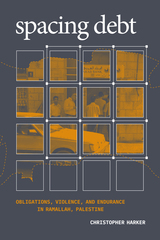 Spacing Debt: Obligations, Violence, and Endurance in Ramallah, Palestine
Christopher Harker
Duke University Press, 2020 In Spacing Debt Christopher Harker demonstrates that financial debt is as much a spatial phenomenon as it is a temporal and social one. Harker traces the emergence of debt in Ramallah after 2008 as part of the financialization of the Palestinian economy under Israeli settler colonialism. Debt contributes to processes through which Palestinians are kept economically unstable and subordinate. Harker draws extensively on residents' accounts of living with the explosion of personal debt to highlight the entanglement of consumer credit with other obligatory relations among family, friends, and institutions. He offers a new geographical theorization of debt, showing how debt affects urban space, including the movement of bodies through the city, localized economies, and the political violence associated with occupation. Bringing cultural and urban imaginaries into conversation with monetized debt, Harker shows how debt itself becomes a slow violence embedded into the everyday lives of citizens. However, debt is also a means through which Palestinians practice endurance, creatively adapting to life under occupation.
 Spacings--of Reason and Imagination: In Texts of Kant, Fichte, Hegel
John Sallis
University of Chicago Press, 1987 By applying the tools of deconstruction to crucial texts of German Idealism, John Sallis reveals the suppressed but essential role of imagination in even the most ambitious attempts to represent pure reason.
Sallis focuses on certain operations of "spacing" in metaphysics—textual lapses and leaps in which reason is displaced or suspended or abridged. In the project of establishing priority of reason, such operations can appear only in disguise, and Sallis reveals the play of imagination and metaphor that masks them. Concentrating on what has been called the closure of metaphysics, he examines texts in which the suppression of spacing would be carried out most rigorously, texts in which even metaphysics itself is seen as only an errant roaming, a spacing that must still be secured, to be replaced by a pure space of truth. And yet, in these very texts Sallis identifies outbreaks of spacing that would disrupt the tranquil space of reason. Rather than closure, he finds an opening of reason to imagination.
Sallis's reading of a metaphorical system in the Critique of Pure Reason reveals a fissuring and historicizing of what would otherwise be called pure reason. Next he traces in Fichte's major work as well as in several lesser-known texts a decentering from reason to imagination, which he characterizes as a power of hovering between opposites and beyond being. Sallis then returns to the Critique of Pure Reason to expose, in relation to the famous question of the common root of reason and sensibility, a certain eccentricity of reason. Proceeding to the Critique of Judgment, he traces a divergence of sublime nature away from that supersensible space of reason to which Kant would otherwise assimilate it—a withdrawal toward an abyss. Finally, Sallis turns to Hegel's Encyclopedia, supplementing his reading with previously unknown notes from Hegel's lectures on those sections dealing with imagination; his reading of those sections serves to expose, within the most rigorous reduction of spacing in the history of metaphysics, an irrepressible and disseminative play of imagination.
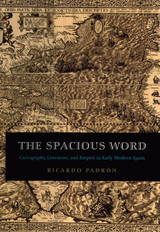 The Spacious Word: Cartography, Literature, and Empire in Early Modern Spain
Ricardo Padrón
University of Chicago Press, 2004 The Spacious Word explores the history of Iberian expansion into the Americas as seen through maps and cartographic literature, and considers the relationship between early Spanish ideas of the world and the origins of European colonialism. Spanish mapmakers and writers, as Padrón shows, clung to a much older idea of space that was based on the itineraries of travel narratives and medieval navigational techniques.
Padrón contends too that maps and geographic writings heavily influenced the Spanish imperial imagination. During the early modern period, the idea of "America" was still something being invented in the minds of Europeans. Maps of the New World, letters from explorers of indigenous civilizations, and poems dramatizing the conquest of distant lands, then, helped Spain to redefine itself both geographically and imaginatively as an Atlantic and even global empire. In turn, such literature had a profound influence on Spanish ideas of nationhood, most significantly its own.
Elegantly conceived and meticulously researched, The Spacious Word will be of enormous interest to historians of Spain, early modern literature, and cartography.
 Spain: A Unique History
Stanley G. Payne
University of Wisconsin Press, 2010 From bloodthirsty conquest to exotic romance, stereotypes of Spain abound. This new volume by distinguished historian Stanley G. Payne draws on his half-century of experience to offer a balanced, broadly chronological survey of Spanish history from the Visigoths to the present. Who were the first “Spaniards”? Is Spain a fully Western country? Was Spanish liberalism a failure? Examining Spain’s unique role in the larger history of Western Europe, Payne reinterprets key aspects of the country’s history.
Topics include Muslim culture in the peninsula, the Spanish monarchy, the empire, and the relationship between Spain and Portugal. Turning to the twentieth century, Payne discusses the Second Republic and the Spanish Civil War. The book’s final chapters focus on the Franco regime, the nature of Spanish fascism, and the special role of the military. Analyzing the figure of Franco himself, Payne seeks to explain why some Spaniards still regard him with respect, while many others view the late dictator with profound loathing.
Framed by reflections on the author’s own formation as a Hispanist and his evaluation of the controversy about “historical memory” in contemporary Spain, this volume offers deeply informed insights into both the history and the historiography of a unique country.
A Choice Outstanding Academic Book
Best Books for General Audiences, selected by the Public Library Association
 Spain and Portugal in the New World, 1492-1700
Lyle N. McAlister
University of Minnesota Press, 1984
Spain and Portugal in the New World, 1492-1700 was first published in 1984. Minnesota Archive Editions uses digital technology to make long-unavailable books once again accessible, and are published unaltered from the original University of Minnesota Press editions.
Spanish and Portuguese expansion substantially altered the social, political, and economic contours of the modern world. In his book, Lyle McAlister provides a narrative and interpretive history of the exploration and settlement of the Americas by Spain and Portugal.
McAlister divides this period (and the book) into three parts. First, he describes the formation of Old World societies with particular attention to those features that influenced the directions and forms of overseas expansion. Second, he traces the dynamic processes of conquest and colonization that between 1492 and about 1570 firmly established Spanish and Portuguese dominion in the New World. The third part deals with colonial growth and consolidation down to about 1700. McAlister's main themes are: the post-conquest territorial expansion that established the limits of what later came to be called Latin America, the emergence of distinctively Spanish and Portuguese American societies and economies, the formation of systems of imperial control and exploitation, and the ways in which conflicts between imperial and American interests were reconciled.
This comprehensive history, with its extensive bibliographic essay and attention to historiographic issues, will be a standard reference for students and scholars of the period.
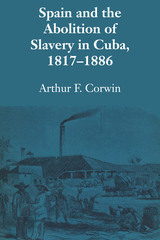 Spain and the Abolition of Slavery in Cuba, 1817–1886
By Arthur F. Corwin
University of Texas Press, 1967 This book explores the abolition of African slavery in Spanish Cuba from 1817 to 1886—from the first Anglo-Spanish agreement to abolish the slave trade until the removal from Cuba of the last vestige of black servitude. Making extensive use of heretofore untapped research sources from the Spanish archives, the author has developed new perspectives on nineteenth-century Spanish policy in Cuba. He skillfully interrelates the problem of slavery with international politics, with Cuban conservative and liberal movements, and with political and economic developments in Spain itself. Arthur Corwin finds that the study of this problem falls naturally into two phases, the first of which, 1817–1860, traces the gradual reduction of the African traffic to the Spanish Antilles and constitutes, in effect, a study in Anglo-Spanish diplomacy. He gives special attention here to the aggressive nature of British abolitionist diplomacy and the mounting but generally ineffective indignation resulting from Spanish failure to apply sanctions against the traffic, as well as the increasing North American interest in the annexation of Cuba. The first phase has for its principal theme the manner in which for decades Spain feigned compliance with agreements to end the slave trade while actually protecting slaveholding interests as the best means of holding Cuba. The American Civil War, which destroyed the greatest bulwark of black slavery in the New World, marked the opening of a new phase, 1860–1886. The author strongly emphasizes here such influences as the rise of the Creole reform movement in Cuba and Puerto Rico, which, reading the signs of the times, gave the initial impulse to a Spanish abolitionist movement and contributed to closing the Cuban slave trade in 1866; the liberal revolution of 1868 in Spain and its promise of colonial reforms; the outbreak of the great Creole rebellion in Cuba, 1868–1878, and the abolitionist promises of the rebel chieftains; the threat of American intervention and the abolitionist pressure of American diplomacy; and the protests of the Spanish reactionaries in Spain and Cuba, leading to further procrastination in Madrid. The second phase has as its principal theme the shaping, through all these intertwined factors, of Spain’s first measure of gradual emancipation, the Moret Law of 1870, and all subsequent steps toward abolition.
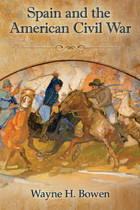 Spain and the American Civil War
Wayne H. Bowen
University of Missouri Press, 2011 In the mid-1800s, Spain experienced economic growth, political stabilization, and military revival, and the country began to sense that it again could be a great global power. In addition to its desire for international glory, Spain also was the only European country that continued to use slaves on plantations in Spanish-controlled Cuba and Puerto Rico. Historically, Spain never had close ties to Washington, D.C., and Spain’s hard feelings increased as it lost Latin America to the United States in independence movements. Clearly, Spain shared many of the same feelings as the Confederate States of America during the American Civil War, and it found itself in a unique position to aid the Confederacy since its territories lay so close to the South. Diplomats on both sides, in fact, declared them “natural allies.” Yet, paradoxically, a close relationship between Spain and the Confederacy was never forged. In Spain and the American Civil War, Wayne H. Bowen presents the first comprehensive look at relations between Spain and the two antagonists of the American Civil War. Using Spanish, United States and Confederate sources, Bowen provides multiple perspectives of critical events during the Civil War, including Confederate attempts to bring Spain and other European nations, particularly France and Great Britain, into the war; reactions to those attempts; and Spain’s revived imperial fortunes in Africa and the Caribbean as it tried to regain its status as a global power. Likewise, he documents Spain’s relationship with Great Britain and France; Spanish thoughts of intervention, either with the help of Great Britain and France or alone; and Spanish receptiveness to the Confederate cause, including the support of Prime Minister Leopoldo O’Donnell. Bowen’s in-depth study reveals how the situations, personalities, and histories of both Spain and the Confederacy kept both parties from establishing a closer relationship, which might have provided critical international diplomatic support for the Confederate States of America and a means through which Spain could exact revenge on the United States of America.
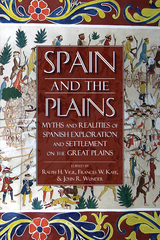 Spain and the Plains: Myths and Realities of Spanish Exploration and Settlement on the Great Plains
Ralph H. Vigil
University Press of Colorado, 2007 The myths of settlement of the Great Plains usually conjure up images of Anglo-American pioneers moving into a sea of grass, opposed by Native peoples. Such myths leave out the considerable influence of Spain. Spain and the Plains corrects this error, revealing the Plains as a northern frontier of New Spain, a frontier antedating the northern European presence in North America, and a frontier where Spanish and Native peoples met, clashed, and blended. Spain and the Plains introduces and documents Spanish exploration of and migration to the Plains, examines the myths that shaped Spanish exploration and the pragmatic realities of exploration and settlement, and documents racism and misrepresentation that Hispanic groups encountered in the nineteenth and twentieth centuries. Contributors show how early explorers, shaped by the intellectual context of the Renaissance, sought mythical locales: the fountain of youth, the straits of Anian, and the city of Quivira. They describe how exploration shifted to emphasize military and economic gains in the eighteenth and nineteenth centuries. Essays portray the diaspora of Spanish settlers and reconstruct daily life in their settlements on the Plains. This unique collection paints a clear picture of a crucial but often misrepresented and neglected era in American and Spanish history. The editors, all authors of previous books, are affiliated with the Center for Great Plains Studies at the University of Nebraska-Lincoln, where Frances W. Kaye is a professor of English, John R. Wunder is a professor of history and journalism, and Ralph H. Vigil is a professor emeritus of history and ethnic studies. Contributors include Félix D. Almaráz Jr., Thomas E. Chávez, Frances W. Kaye, Russell M. Magnaghi, Ralph H. Vigil, Waldo R. Wedel, and John R. Wunder.
 Spain at the Crossroads: Civil Society, Politics, and the Rule of Law
Víctor Pérez-Díaz
Harvard University Press, 1999 This book explores the trials of Spanish democracy from the death of Franco to the present. But the heart of the story is the generation that came of age in the 1960s, assumed political power, and formed the first Socialist government in 1982 with Felipe González as Prime Minister, which was returned to power in four consecutive elections. Starting in 1993, however, the government came under siege. High officials were accused of authorizing the assassination of as many as twenty-eight Basque nationalists suspected of terrorism over the years, and of covering up these crimes. This scandal, along with other disclosures of corruption and serious law-breaking, shook the country's confidence in its legal and political institutions and in its ability to hold its leaders to the rule of law.
The author probes for the roots of these events in the character of the generation that assumed power and in the immature nature of the civil society it inherited. Facing unusually high unemployment, internal economic and social pressures, the stringent requirements for joining the European Union, and the demands of Catalan and Basque nationalists, the government lost its way and was eventually voted out of office.
Using Spain as the example, the book examines issues of governance, social change, and internal nationalist movements as they relate to the civil society and the wider polity everywhere.
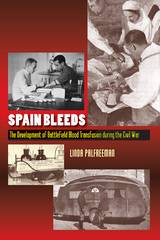 Spain Bleeds: The Development of Battlefield Blood Transfusion During the Civil War
Linda Palfreeman
Sussex Academic Press, 2022 War is sometimes mistakenly construed as the chief impetus for medical innovation. Nevertheless, military conflict obliges the implementation of discoveries still at an experimental stage. Such was the case with the practice of blood transfusion during the Spanish Civil War, when massive demand for blood provoked immediate recourse to breakthroughs in transfusion medicine not yet integrated into standard medical practice. The Spanish Civil War marked a new era in blood transfusion medicine. Frederic Duran Jorda and Carlos Elosegui Sarasoles, directors, respectively, of the blood transfusion services of the Republican Army and of the insurgent forces, were innovators in the field of indirect blood transfusion with preserved blood. Not only had they to create transfusion services, almost from scratch, capable of supplying campaigning armies with blood in wartime conditions, they also had to struggle against the medical establishment and to convince their medical peers of the value (not to mention the scientific significance) of what they were doing. The Blood Transfusion Service of the Republic was a truly international effort, with medical volunteers from all over the world carrying out transfusion work in primitive and often dangerous conditions. All took their lead from one man - the young Catalan haematologist, Frederic Duran Jorda, the indisputable pioneer of civil war blood transfusion medicine. From humble beginnings at the outbreak of war, blood transfusion services were created in Spain that would later become crucial in the treatment of casualties during the Second World War and would shape the future evolution of blood transfusion medicine throughout the developed world.
Spain, China, and Japan in Manila, 1571-1644: Local Comparisons and Global Connections
Birgit Tremml-Werner
Amsterdam University Press, 2015 Spain, China and Japan in Manila, 1571—1644 offers a new perspective on the connected histories of Spain, China, and Japan as they emerged and developed following Manila’s foundation as the capital of the Spanish Philippines in 1571. Examining a wealth of multilingual primary sources, Birgit Tremml-Werner shows that crosscultural encounters not only shaped Manila’s development as a "Eurasian" port city, but also had profound political, economic, and social ramifications for the three premodern states. Combining a systematic comparison with a focus on specific actors during this period, this book addresses many long-held misconceptions and offers a more balanced and multifaceted view of these nations’ histories.
 Spain during World War II
Wayne H Bowen
University of Missouri Press, 2006 The story of Spain during World War II has largely been viewed as the story of dictator Francisco Franco’s foreign diplomacy in the aftermath of civil war. Wayne H. Bowen now goes behind the scenes of fascism to reveal less-studied dimensions of Spanish history. By examining the conflicts within the Franco regime and the daily lives of Spaniards, he has written the first book-length assessment of the regime’s formative years and the struggle of its citizens to survive. Bowen argues that the emphasis of previous scholars on Spain’s foreign affairs is misplaced—that even the most pro-Axis elements of Franco’s regime were more concerned with domestic politics, the potential for civil unrest, and poverty than with events in Europe. Synthesizing a wide range of Spanish-language scholarship and recently declassified government documents, Bowen reveals how Franco’s government stumbled in the face of world war, inexperienced leaders, contradictory political ideology, and a divided populace. His book tells the dramatic story of a six-year argument among the general, the politicians, and the clerics on nothing less than what should be the nature of the new Spain, touching on issues as diverse as whether the monarchy should be restored and how women should dress. Examining the effects of World War II years on key facets of Spanish life—Catholicism, the economy, women, leisure, culture, opposition to Franco, and domestic politics—Bowen explores a wide range of topics: the grinding poverty following the civil war, exacerbated by poor economic decisions; restrictions on employment for women versus the relative autonomy enjoyed by female members of the Falange; the efforts of the Church to recover from near decimation; and methods of repression practiced by the regime against leftists, separatists, and Freemasons. He also shows that the lives of most Spaniards remained apolitical and centered on work, family, and leisure marked by the popularity of American movies and the resurgence of loyalty to regional sports teams. Unlike other studies that have focused exclusively on Spain’s foreign affairs during the Second World War, Bowen’s work stresses the importance of the home front not only in keeping Spain out of the war but also in keeping Franco in power. He shows that in spite of internal problems and external distractions, Franco’s government managed to achieve its goals of state survival and internal peace. As the only single-volume survey of this era available in English, Spain during World War II is a masterful synthesis that offers a much-needed alternative view of the Franco regime during crucial times as it provides a testament to the Spanish people’s will to survive.
Spain's Cause was Mine: A Memoir of an American Medic in the Spanish War
Hank Rubin
Southern Illinois University Press, 1999
“No man ever entered earth more honorably than those who died in Spain.”—Ernest Hemingway
In 1937, Hank Rubin, a twenty-year-old Jewish pre-med student at UCLA, volunteered for service in the International Brigades combating fascists in the Spanish Civil War. In his illustrated memoir, Rubin reflects on those events, making no apologies for his youthful impulsiveness, bravado, and ideology, but recalling the heroics and sufferings he witnessed and experienced in Spain, as well as the disappointing treatment he received upon his return.
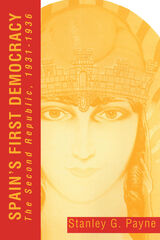 Spain's First Democracy: The Second Republic, 1931–1936
Stanley G. Payne
University of Wisconsin Press, 1993 The significance of Spain’s Second Republic has been largely overshadowed by the cataclysmic Civil War that immediately followed it. Stanley Payne brings his immense knowledge of Spanish history to bear on the five-year span of the Second Republic as a historic entity in its own right. In Spain’s First Democracy, he argues that the Republic was one of the major national attempts at political democratization and reform in Europe between the World Wars and represented the most important effort to swim against the tide during Europe’s “era of fascism.”
Payne’s detailed study places the Republic within the historical framework of Spanish liberalism and the rapid modernization of interwar Europe, which was unlike any other period in Spain’s history. Payne discusses the Republicans’ efforts to establish Spain’s first democratic political systems and to institute major reforms within the Republic. In highlighting reforms in politics and government, church-state relations, education and culture, public works, military affairs, and society as a whole, he assesses the successes and failures of these reforms as well as the reasons for their limitations. He also examines the economic and foreign policy issues of the period.
Focusing particularly on political conflict and social cleavage, Payne brilliantly explores the sources and character of the political polarization that developed as a result of the assaults on the Republic from the Left and the Right. He identifies the main political actors in this schism and their role in the eventual breakdown of the Republic. Tracing the progressive collapse of the Republican polity in the first half of 1936, Payne stresses the importance of political violence in the democracy’s downfall.
In restoring perspectives that have been ignored or bypassed, Payne presents a consistent and detailed interpretation of Spain’s Second Republic, demonstrating its striking parallels to the Weimar Republic in Germany.
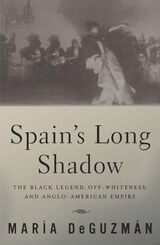 Spain's Long Shadow: The Black Legend, Off-Whiteness, and Anglo-American Empire
María DeGuzmán
University of Minnesota Press, 2005 England and the Netherlands, Spain’s imperial rivals of the sixteenth and seventeenth centuries, imagined Spain as a land of cruel and degenerate barbarians of la leyenda negra (the Black Legend), in league with the powers of “blackest darkness” and driven by “dark motives.” In Spain’s Long Shadow, María DeGuzmán explores how this convenient demonization made its way into American culture—and proved essential to the construction of whiteness. DeGuzmán’s work reaches from the late eighteenth century—in the wake of the American Revolution—to the present. Surveying a broad range of texts and images, from Poe’s “William Wilson” and John Singer Sargent’s El Jaleo to Richard Wright’s Pagan Spain and Kathy Acker’s Don Quixote, Spain’s Long Shadow shows how the creation of Anglo-American ethnicity as specifically American has depended on the casting of Spain as a colonial alter ego. The symbolic power of Spain in the American imagination, DeGuzmán argues, is not just a legacy of that nation’s colonial presence in the Americas; it lives on as well in the “blackness” of Spain and Spaniards—in the assigning of people of Spanish origin to an “off-white” racial category that reserves the designation of white for Anglo-Americans. By demonstrating how the Anglo-American imagination needs Spain and Spaniards as figures of attraction and repulsion, DeGuzmán makes a compelling and illuminating case for treating Spain as the imperial alter ego of the United States. Cross-cultural and interdisciplinary, ambitious in its chronological sweep, and elegant in its interpretation of literary and visual works, DeGuzmán’s book leads us to a powerful new understanding of the nature—and history—of American ethnicity.
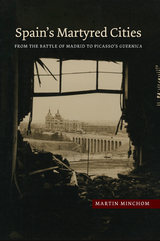 Spain's Martyred Cities: From the Battle of Madrid to Picasso's Guernica
Martin Minchom
Sussex Academic Press, 2022 Spain's Martyred Cities studies international reactions to the Spanish Civil War between the Battle of Madrid in November 1936 and the bombing of Guernica in April 1937. Many of the iconic events of the war belong to this key period, when international perceptions of the conflict were decisively shaped. The subject is approached through French and British newspapers and pamphlets, and events are linked to both their immediate press coverage and subsequent literary and artistic representations. For contemporaries, the aerial bombardments of Madrid, Guernica and other cities formed part of a single unbroken narrative. It was only later that Guernica acquired its perceived symbolic primacy. The language of 'martyrdom' was sometimes evoked in pro-Republican writing as a means of challenging Francoist claims to the religious and moral high ground. But the ur-text was The Martyrdom of Madrid (1937), a compilation of the posthumous, censored reports of the French correspondent Louis Delapree on the bombing of Madrid. Delapree's earliest reporting (July-October 1936) was from both the Nationalist and Republican zones, and is used to provide an introductory overview of the early stages of the war; he was an eyewitness of the aerial bombardments of Madrid in November 1936; subsequently, the posthumous publication of his writings created a major stir in Paris. Delapree's powerful and emotive writing provides a platform from which to discuss issues of press censorship and journalistic practice. It is notable for its initial impact, when publication in no less than five languages enabled it to reach writers as different as Virginia Woolf and Andre Malraux. This book shows that Delapree's reports were also an important catalyst in Picasso's artistic involvement in the war, culminating in his Guernica. Published in association with the Canada Blanch Centre for Contemporary Spanish Studies
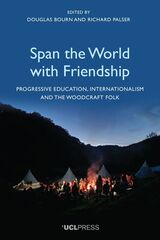 Span the World with Friendship
Edited by Douglas Bourn and Richard Palser
University College London, 2025 The first major academic study of the Woodcraft Folk, this volume evaluates how a cooperative youth movement fostered socialist education and international solidarity.
For nearly a century, the Woodcraft Folk has championed radical social change through education, but its contributions remain largely overlooked in histories of progressive youth movements. Span the World with Friendship is the first major academic study of this pioneering organization, tracing its role in fostering internationalism, cooperative learning, and environmental activism long before these became mainstream concerns. The Woodcraft Folk’s impact is inspected through diverse disciplinary perspectives, including political theory, anthropology, and youth work studies. Through a review of multiple archival sources—letters, meeting records, and oral testimonies—contributors bring a critical lens to a movement often narrated uncritically.
Beginning with a biography of founder Leslie Paul, the book looks into the Folk’s relationship with the labor movement, its engagement with eugenics debates, and its use of folk traditions as tools for social cohesion. Concluding with an exploration of its transition into a youth-led movement, this volume positions the Woodcraft Folk within broader discussions on education for global justice and activism, ensuring its legacy is finally given the academic attention it deserves.
 Spaniards and Nazi Germany: Collaboration in the New Order
Wayne H. Bowen
University of Missouri Press, 2000 Using recently declassified documents from Spain and the United States, personal interviews, and unpublished and published Spanish, German, British, and U.S. records, Spaniards and Nazi Germany makes a significant contribution to the understanding of Hispano-German relations during the 1930s and 1940s. This study shows that Naziphiles within the Spanish Falange, Spain's fascist party, made a concerted effort to bring their nation into World War II, and that only the indecisiveness of dictator Francisco Franco and diplomatic mistakes by the Nazis prevented them from succeeding. Bowen demonstrates that while Spain was neutral in World War II, its policies clearly favored the Axis, at least in the early stages of the war. Franco, who had emerged victorious from the Spanish Civil War in 1939 largely because of support from Adolf Hitler and Benito Mussolini, even carefully considered entering World War II on the side of Nazi Germany. By the late 1930s, members of the Falange saw World War II as a revolutionary opportunity, a chance to lead Spain into a new age as a partner with Nazi Germany and Fascist Italy at the head of a New Europe of social justice and authoritarian regimes. By the end of 1939, a significant minority of pro- Nazi Spaniards were unhappy that Spain had not entered the war and remade itself to fit better into Hitler's New Order. Bowen argues that support for Nazi Germany in Spain and among Spanish communities throughout Europe was both wide and deep, and that this enthusiasm for the Third Reich and the New Order it promised to bring lasted until the end of the war. Despite statements of neutrality by the Spanish government, the Franco regime was well aware of this collaboration by Spanish citizens as late as 1944-1945 and did little to stop it. Had Hitler been more interested in bringing Spain into his empire, or exploiting the pro-Nazi sentiments of these thousands of Spaniards, he might have replaced Franco with someone more willing to support his interests even as late as 1943. Spaniards and Nazi Germany presents many possibilities for what might have been a far different outcome of World War II in Europe. It shows that even without the full support of the Spanish or German governments, pro-Nazi Spaniards, even if they did not quite bring Spain into the war, added to the strength of the Third Reich by serving in its armies, working in its factories, and promoting its ideas to other nations.
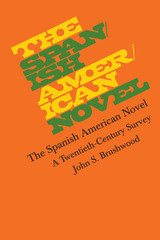 The Spanish American Novel: A Twentieth-Century Survey
By John S. Brushwood
University of Texas Press, 1975 In The Spanish American Novel, John S. Brushwood analyzes the twentieth-century Spanish American novel as an artistic expression of social reality. In relating the generic history of the novel to extraliterary events in Spanish America, he shows how twentieth-century fiction sets forth the essence of such phenomena as the first Perón regime, the Mexican Revolution, the Che Guevara legend, indigenismo, and the strongman political type. In essence, he views the novel as art rather than as document, but not as art alienated from society. The discussion is organized chronologically, opening with the turn of the century and focusing on novels from 1900 to 1915 that exemplify various aspects of the nineteenth-century literary inheritance. Brushwood then highlights the avant-garde fiction (influenced by Proust and Joyce) of the 1920s as a precursory movement to the “new” Latin American novel, a phenomenon that came into its own during the 1940s. He then examines the “boom” in Spanish American fiction, the period of extensive international recognition of certain works, which he dates from 1962 or 1963. In each era considered, the development of the novel is placed in dual perspective. One view—that of particularly significant novels in light of others published during the same year—is a cross section of the genre at one particular moment. The second view—that of a panorama of novels published in intervals between significant moments in the history of the novel—is more general and selective in the number of books discussed. Combining the historical with the analytical approach, the author proposes that the experience of a novel in which reality has been transformed into art is essential to our understanding of that reality.
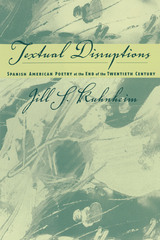 Spanish American Poetry at the End of the Twentieth Century: Textual Disruptions
By Jill Kuhnheim
University of Texas Press, 2005 Has poetry lost its relevance in the postmodern age, unable to keep pace with other forms of cultural production such as film, mass media, and the Internet? Quite the contrary, argues Jill Kuhnheim in this pathfinding book, which explores how recent Spanish American poetry participates in the fundamental cultural debates of its time. Using a variety of interdisciplinary approaches, Kuhnheim engages in close readings of numerous poetic works to show how contemporary Spanish American poetry struggles with the divisions between politics and aesthetics and between visual and written images; grapples with issues of ethnic, national, sexual, and urban identities; and incorporates rather than rejects technological innovations and elements from the mass media. Her analysis illuminates the ways in which contemporary issues such as indigenismo and Latin America's postcolonial legacy, modernization, immigration, globalization, economic shifts toward neoliberalism and informal economies, urbanization, and the technological revolution have been expressed in—and even changed the very form of—Spanish American poetry since the 1970s.
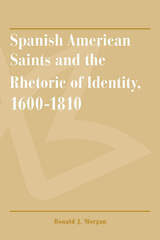 Spanish American Saints and the Rhetoric of Identity, 1600-1810
Ronald J. Morgan
University of Arizona Press, 2002 Spanish American civilization developed over several generations as Iberian-born settlers and their "New World" descendants adapted Old World institutions, beliefs, and literary forms to diverse American social contexts. Like their European forebears, criollos—descendants of Spanish immigrants who called the New World home—preserved the memory of persons of extraordinary Roman Catholic piety in a centuries-old literary form known as the saint's Life. These criollo religious biographies reflect not only traditional Roman Catholic values but also such New World concerns as immigration, racial mixing, and English piracy. Ronald Morgan examines the collective function of the saint's Life from 1600 to the end of the colonial period, arguing that this literary form served not only to prove the protagonist’s sanctity and move the faithful to veneration but also to reinforce sentiments of group pride and solidarity. When criollos praised americano saints, he explains, they also called attention to their own virtues and achievements. Morgan analyzes the printed hagiographies of five New World holy persons: Blessed Sebastián de Aparicio (Mexico), St. Rosa de Lima (Peru), St. Mariana de Jesús (Ecuador), Catarina de San Juan (Mexico), and St. Felipe de Jesús (Mexico). Through close readings of these texts, he explores the significance of holy persons as cultural and political symbols. By highlighting this convergence of religious and sociopolitical discourse, Morgan sheds important light on the growth of Spanish American self-consciousness and criollo identity formation. By focusing on the biographical process itself, Morgan demonstrates the importance of reading each hagiographic text for its idiosyncrasies rather than its conventional features. His work offers new insight into the Latin American cult of saints, inviting scholars to look beyond the isolated lives of individuals to the cultural and social milieus in which their sanctity originated and their public reputations took shape.
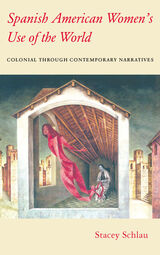 Spanish American Women's Use of the Word: Colonial through Contemporary Narratives
Stacey Schlau
University of Arizona Press, 2001 Women's participation, both formal and informal, in the creation of what we now call Spanish America is reflected in its literary legacy. Stacey Schlau examines what women from a wide spectrum of classes and races have to say about the societies in which they lived and their place in them. Schlau has written the first book to study a historical selection of Spanish American women's writings with an emphasis on social and political themes. Through their words, she offers an alternative vision of the development of narrative genres—critical, fictional, and testimonial—from colonial times to the present. The authors considered here represent the chronological yet nonlinear development of women's narrative. They include Teresa Romero Zapata, accused before the Inquisition of being a false visionary; Inés Suárez, nun and writer of spiritual autobiography; Gertrudis Gómez de Avellaneda, author of an indigenist historical romance; Magda Portal, whose biography of Flora Tristán furthered her own political agenda; Dora Alonso, who wrote revolutionary children's books; Domitila Barrios de Chungara, political leader and organizer; Elvira Orphée, whose novel unpacks the psychology of the torturer; and several others who address social and political struggles that continue to the present day. Although the writers treated here may seem to have little in common, all sought to maneuver through institutions and systems and insert themselves into public life by using the written word, often through the appropriation and modification of mainstream genres. In examining how these authors stretched the boundaries of genre to create a multiplicity of hybrid forms, Schlau reveals points of convergence in the narrative tradition of challenging established political and social structures. Outlining the shape of this literary tradition, she introduces us to a host of neglected voices, as well as examining better-known ones, who demonstrate that for women, simply writing can be a political act.
|
|

